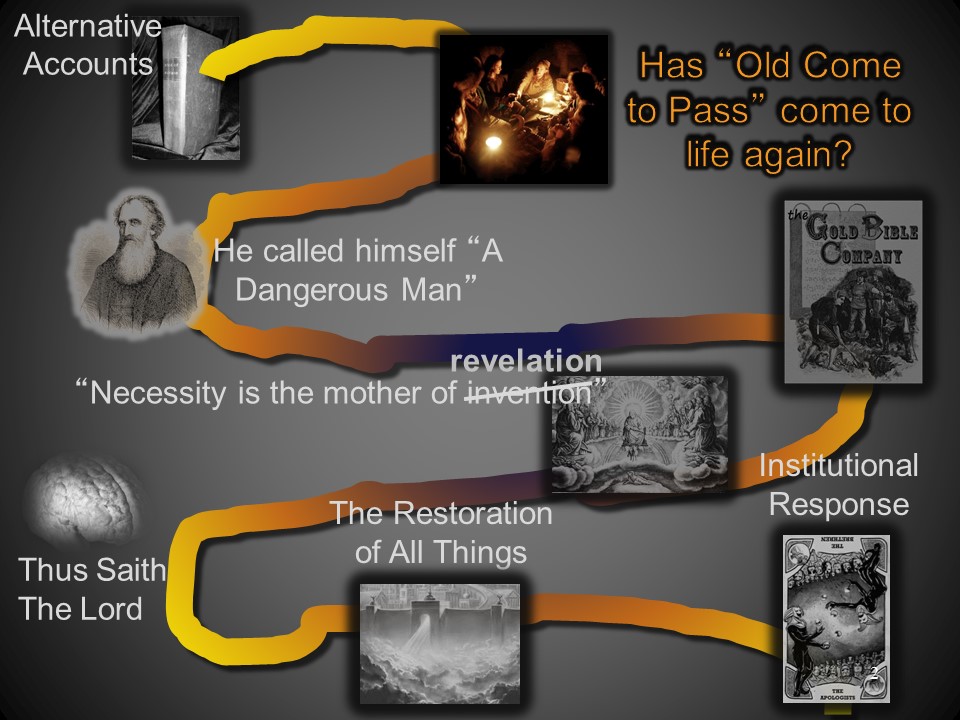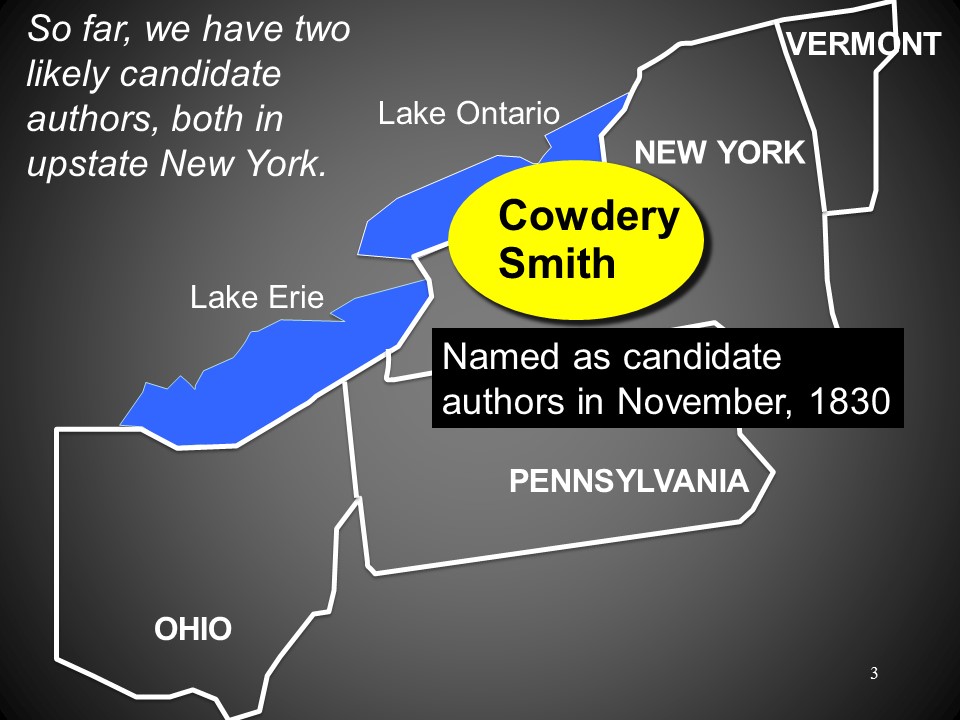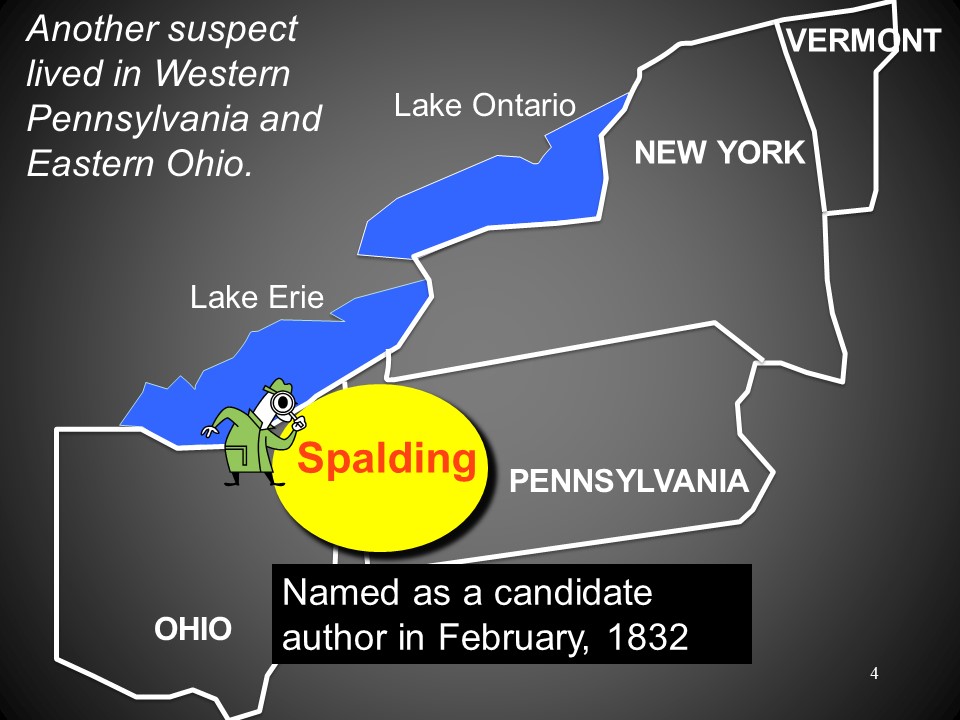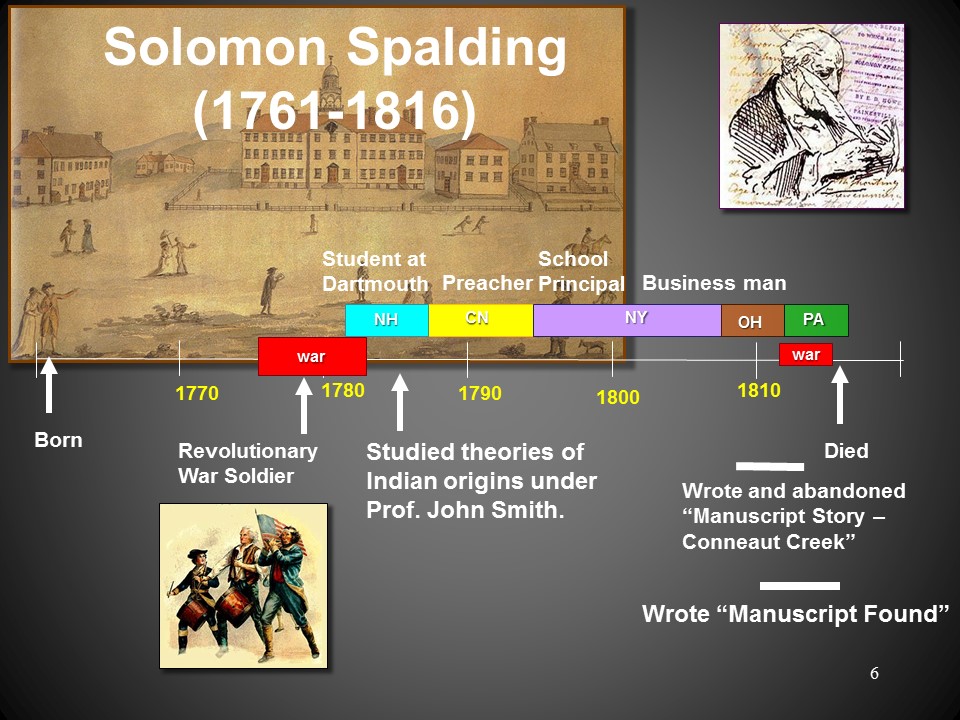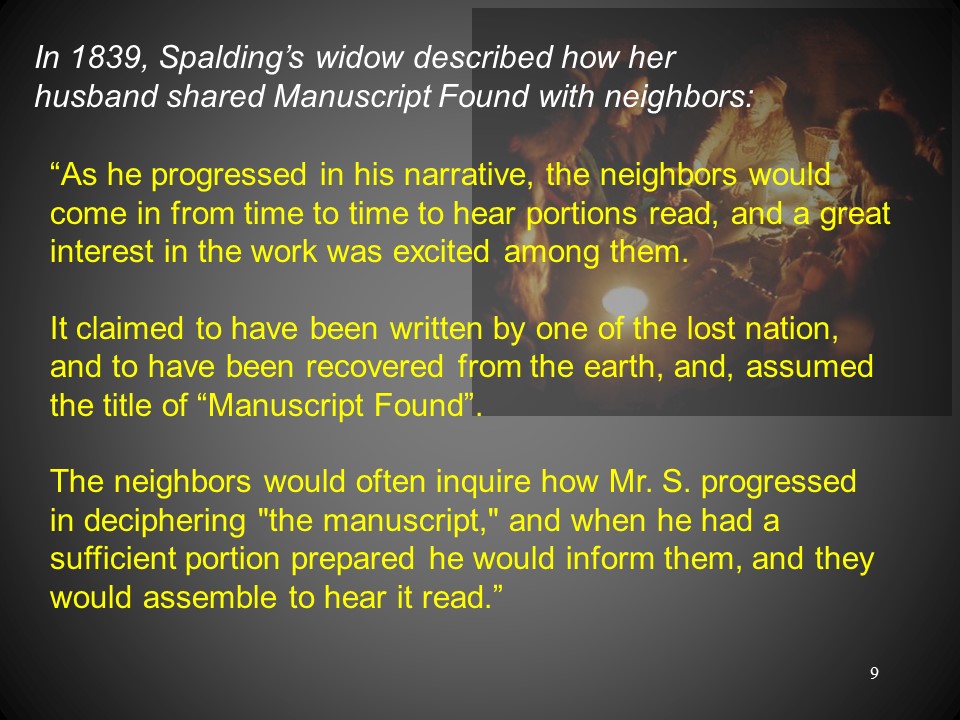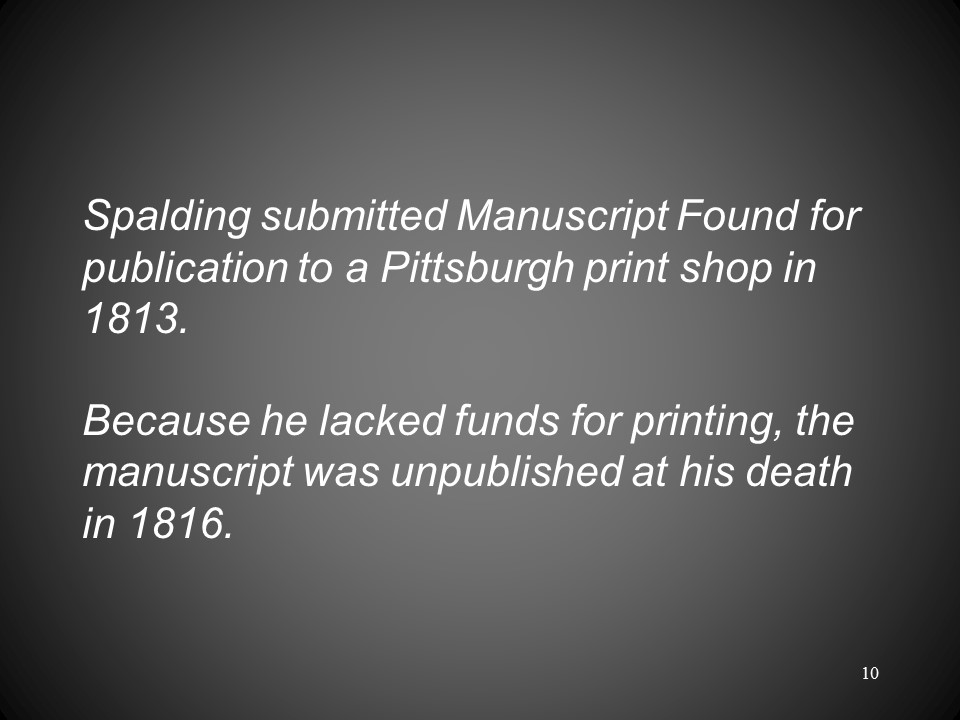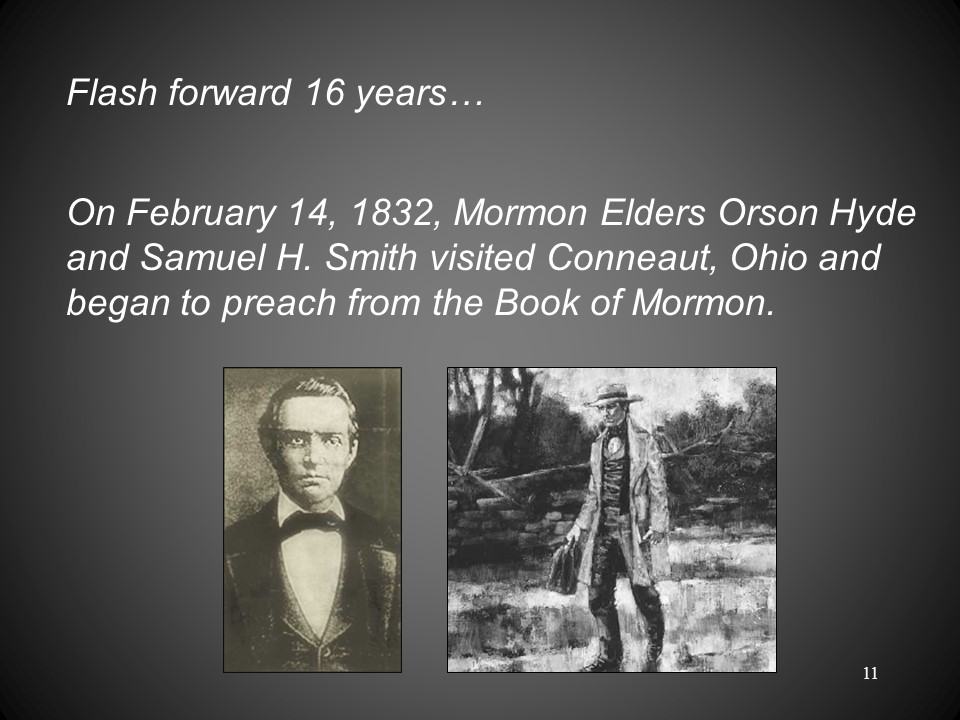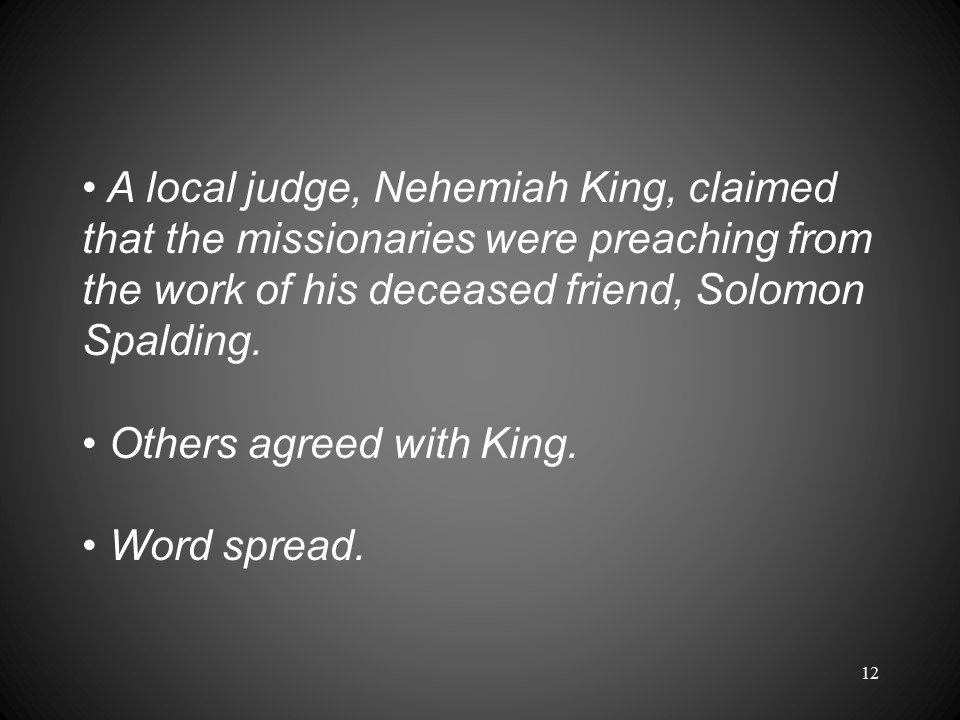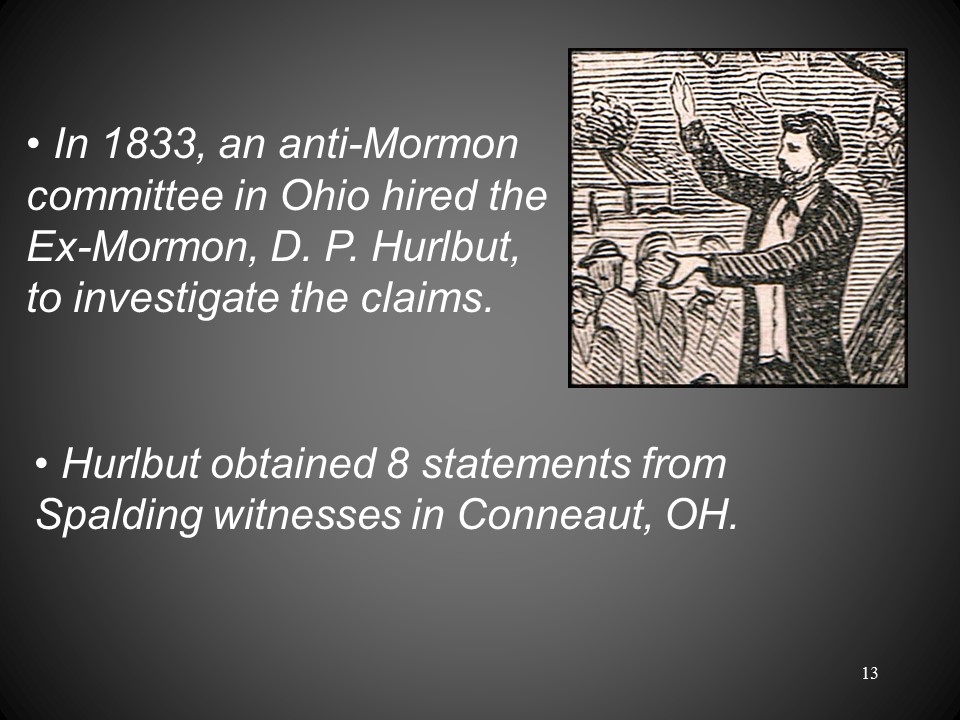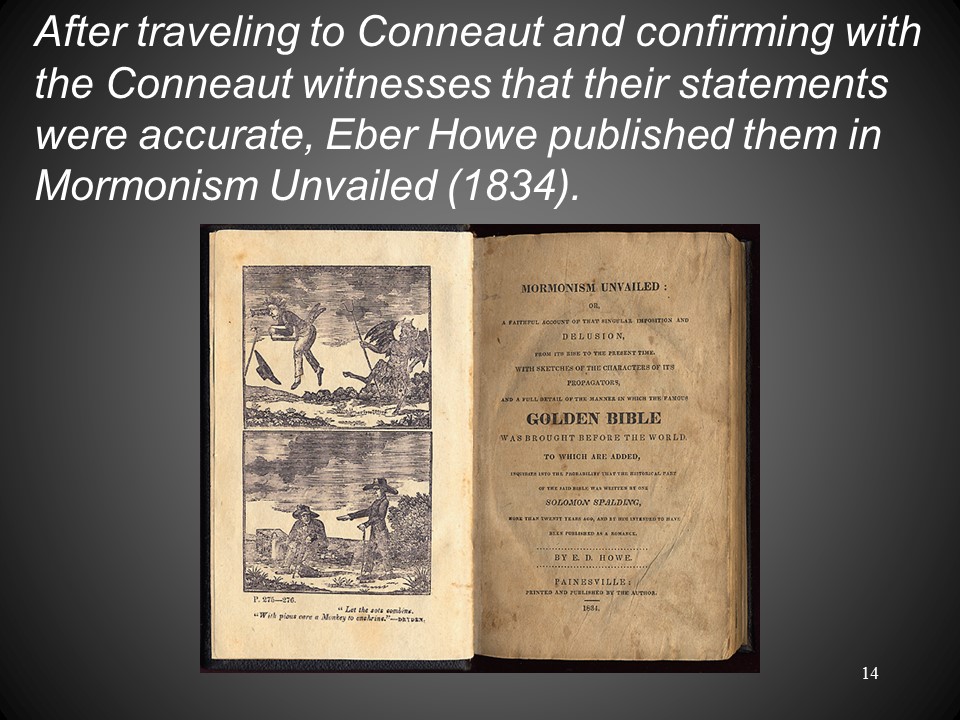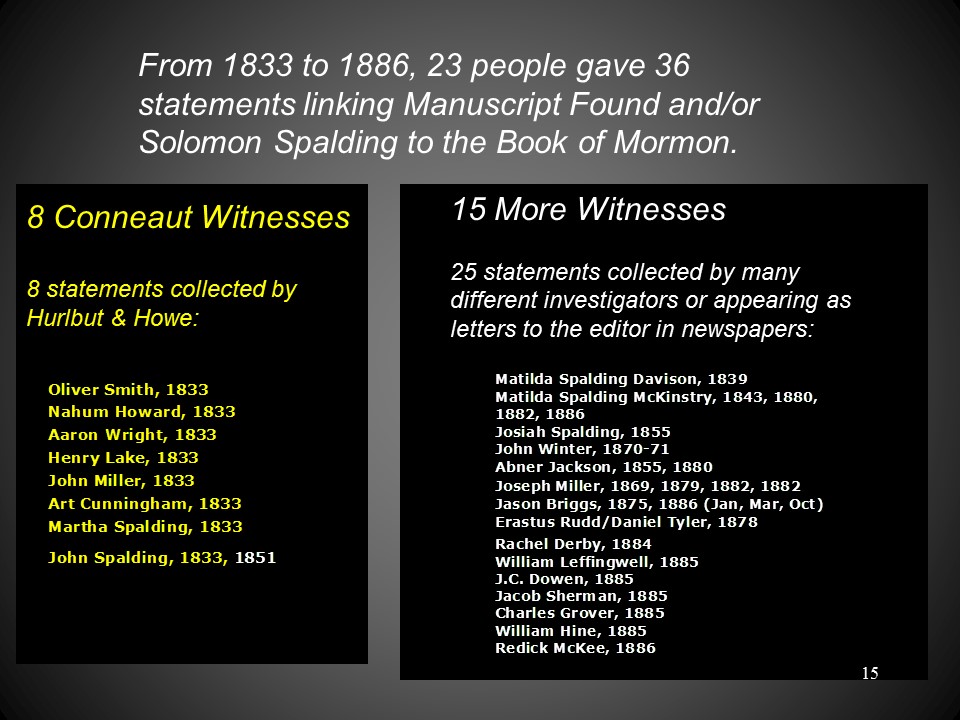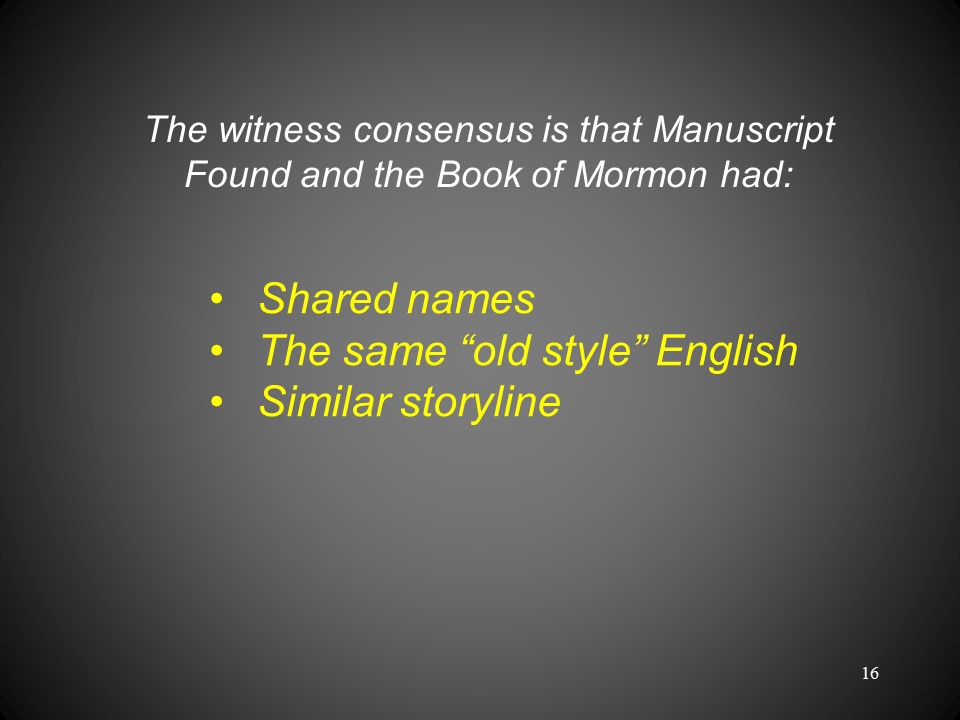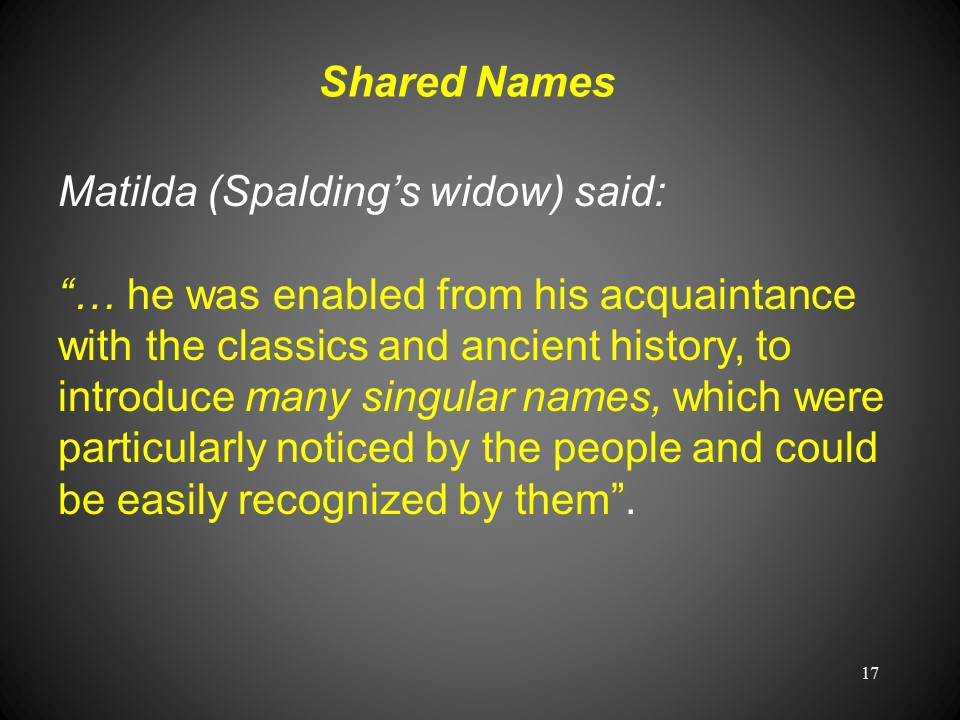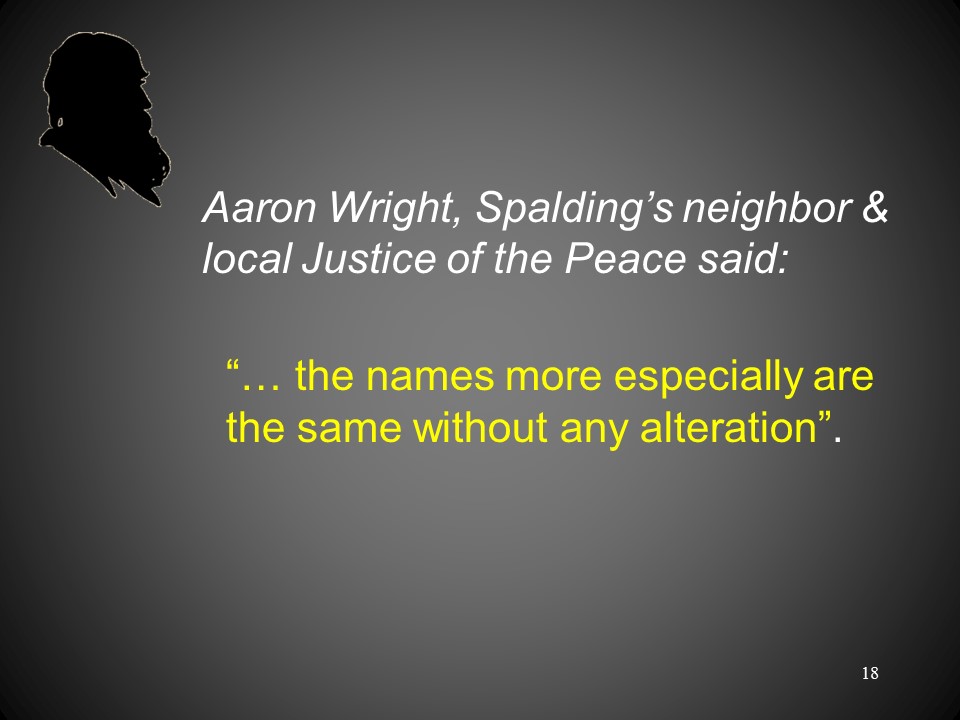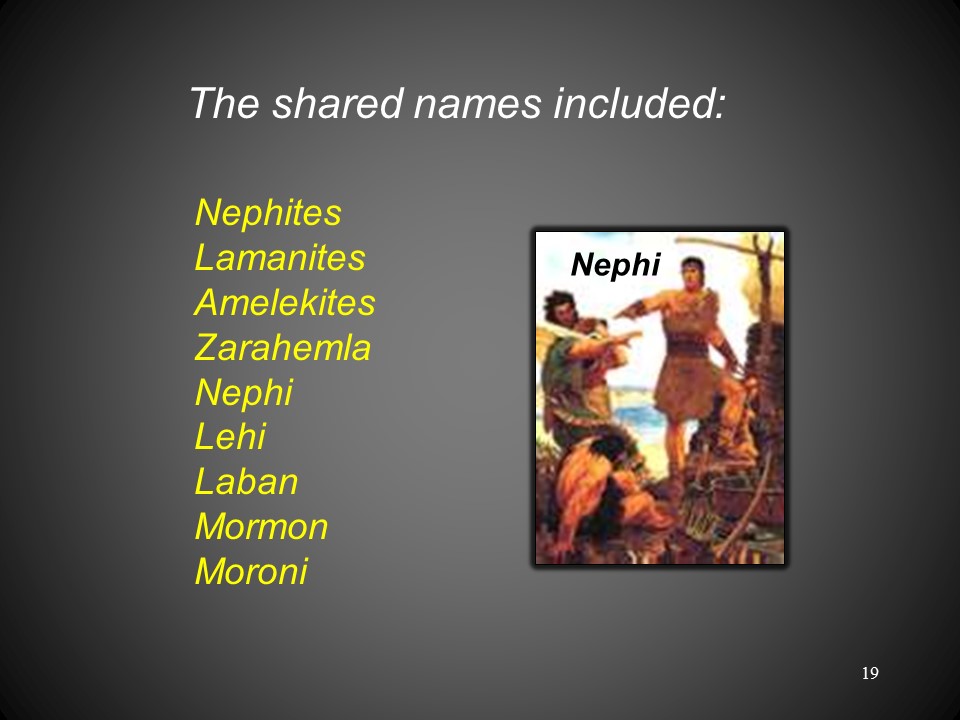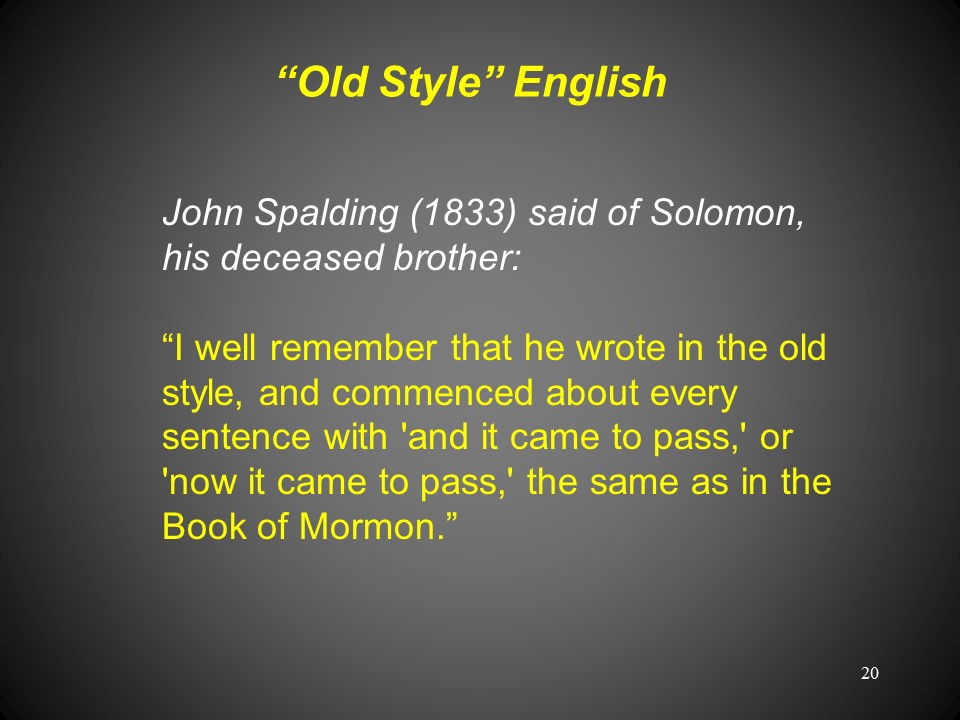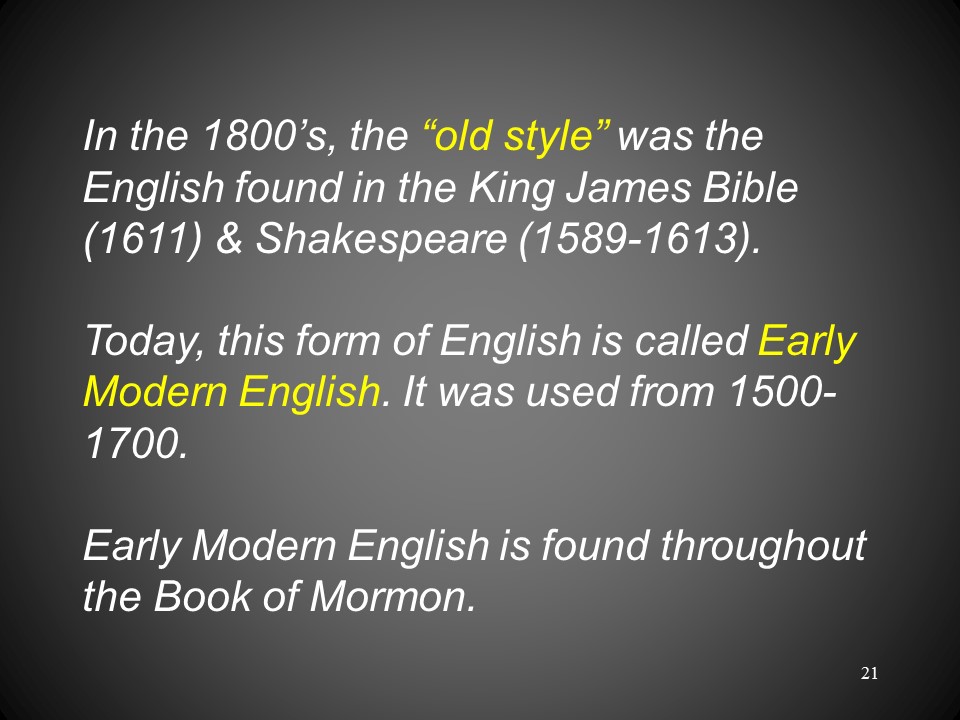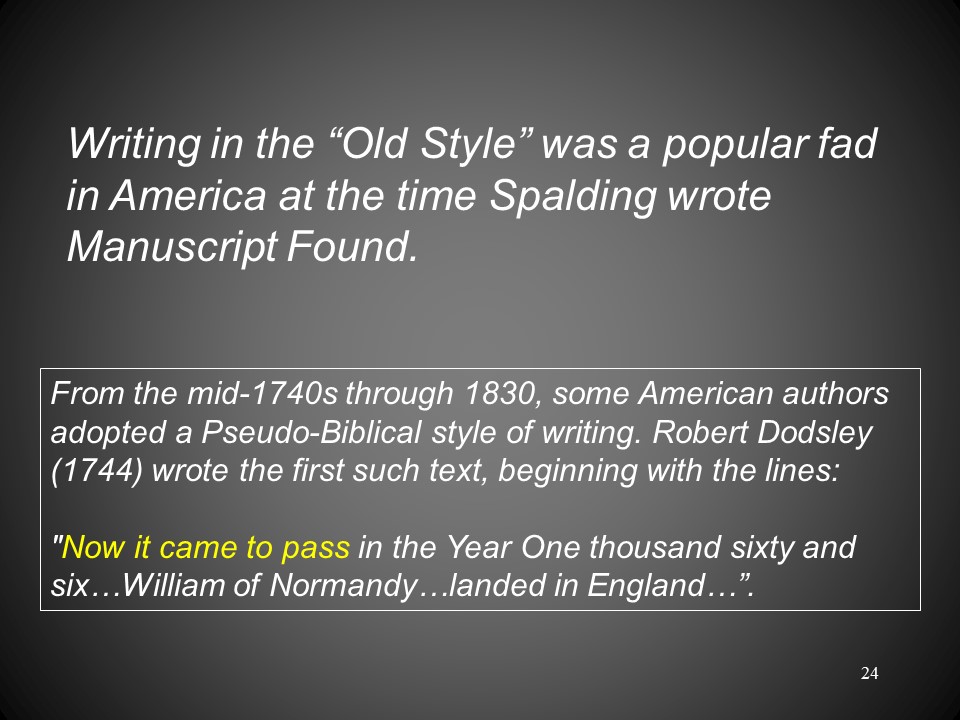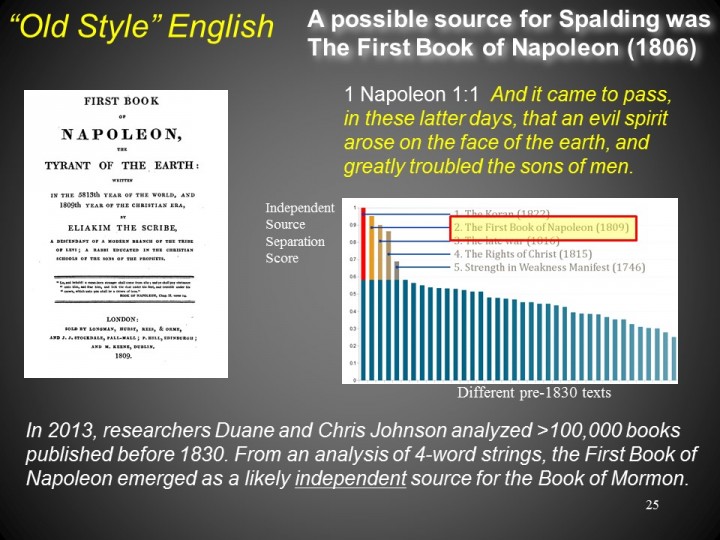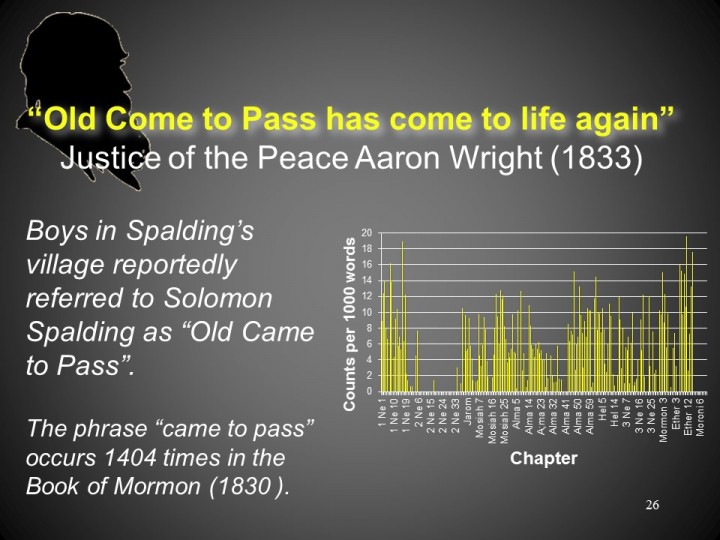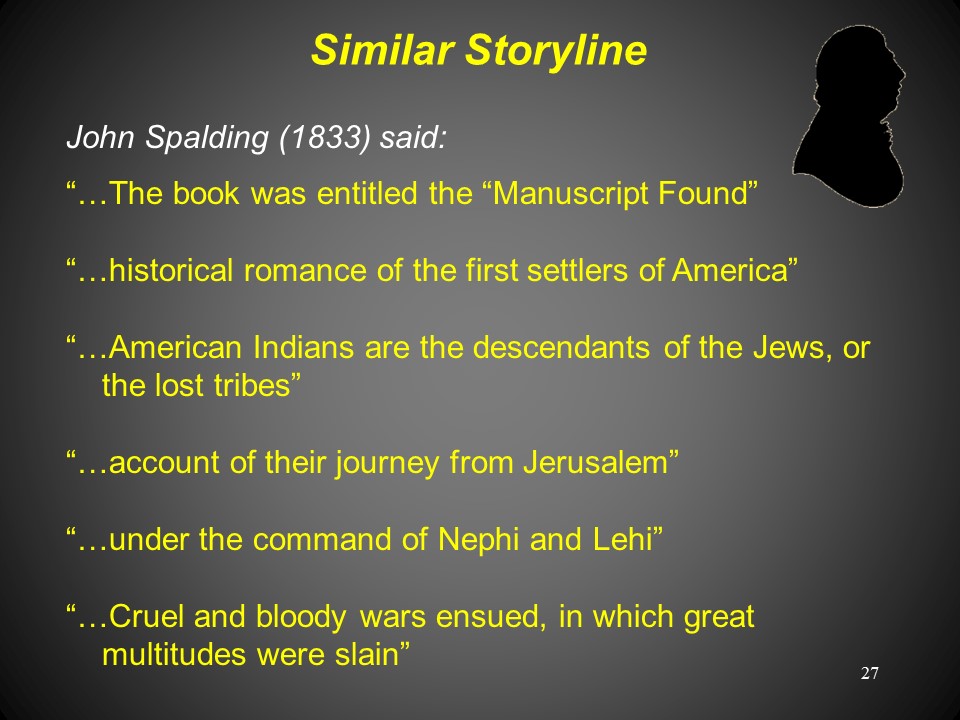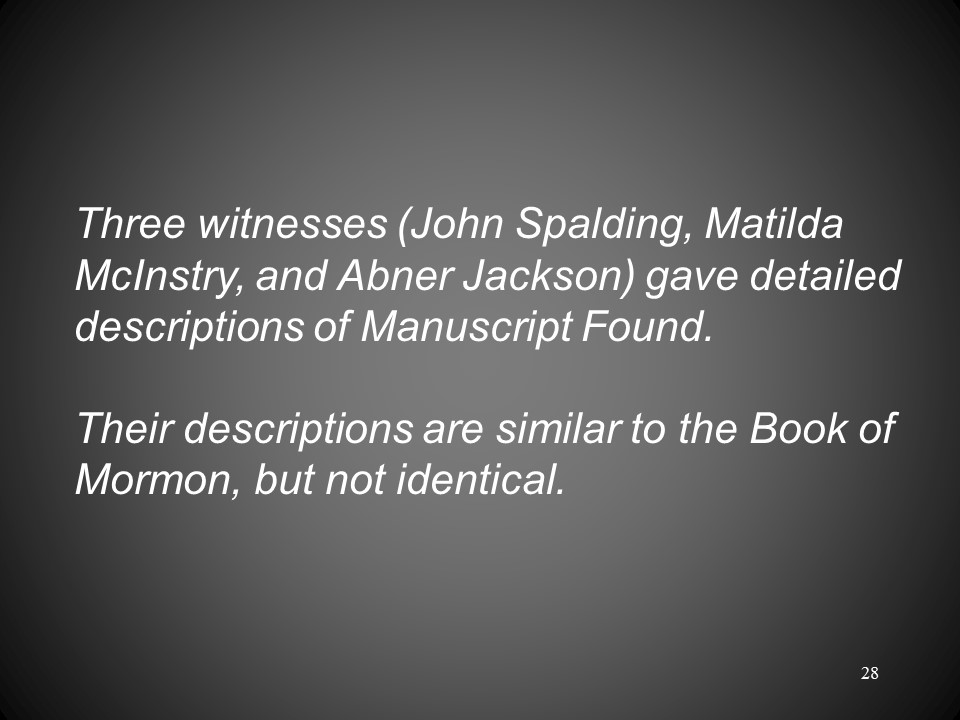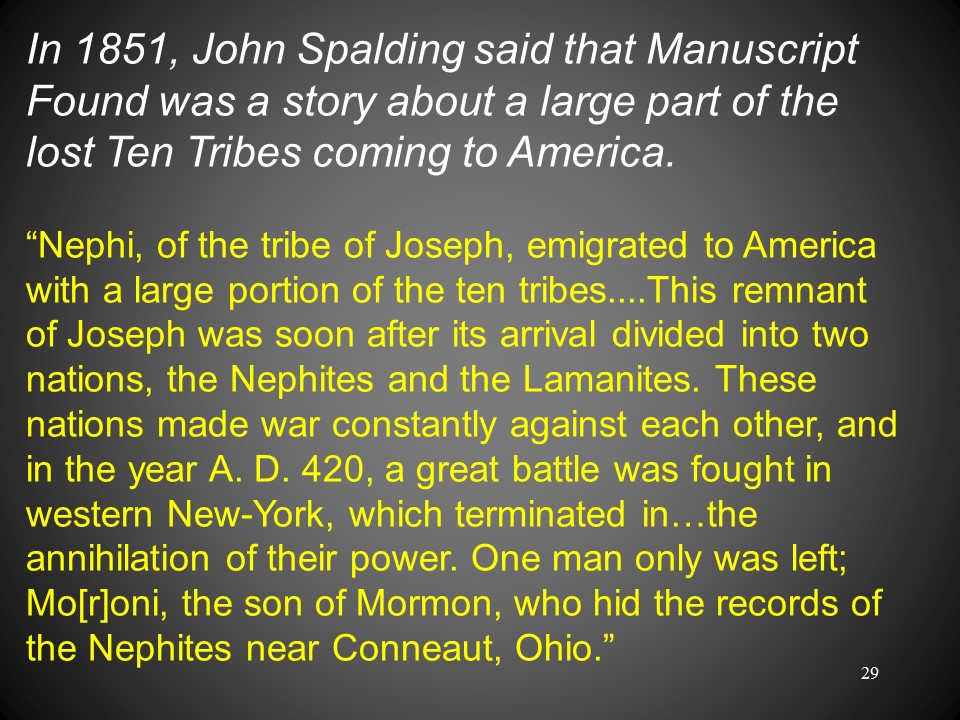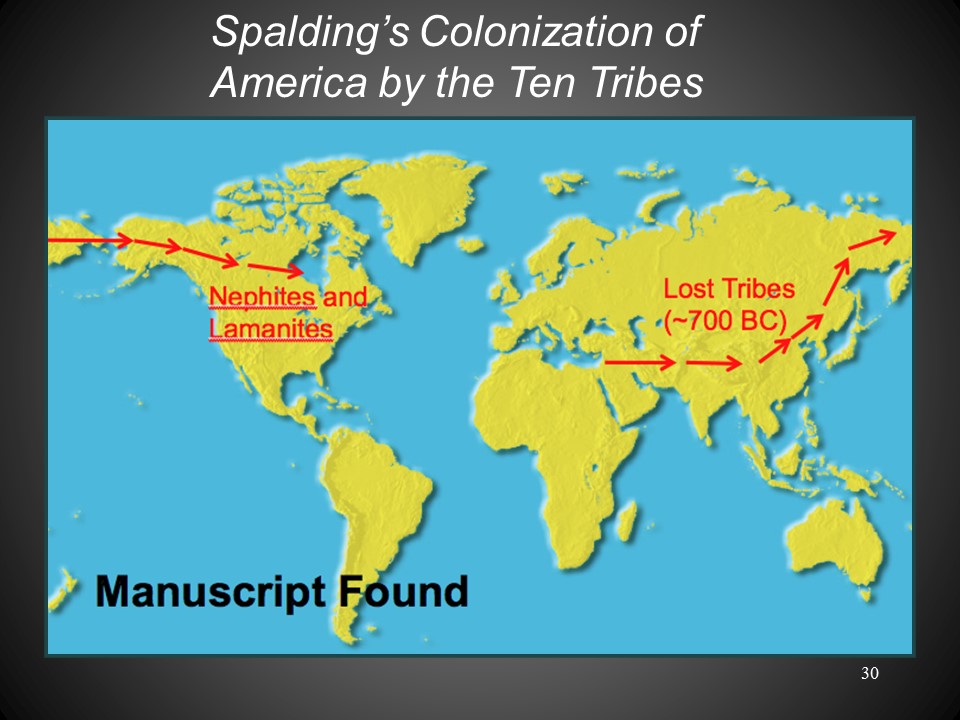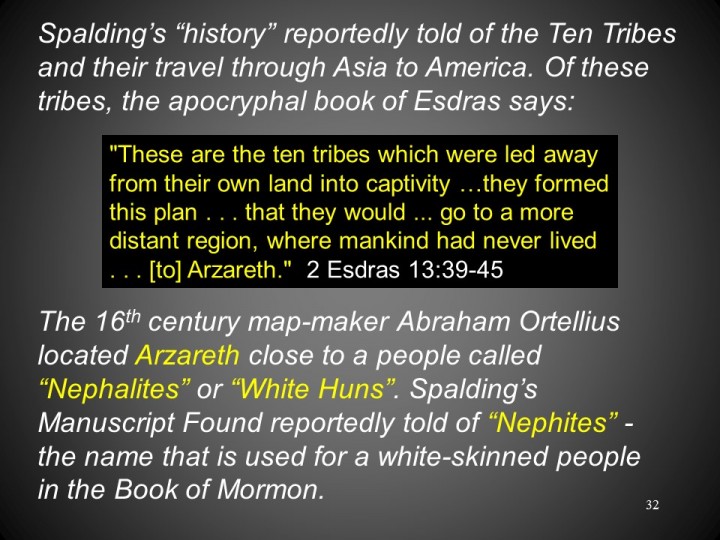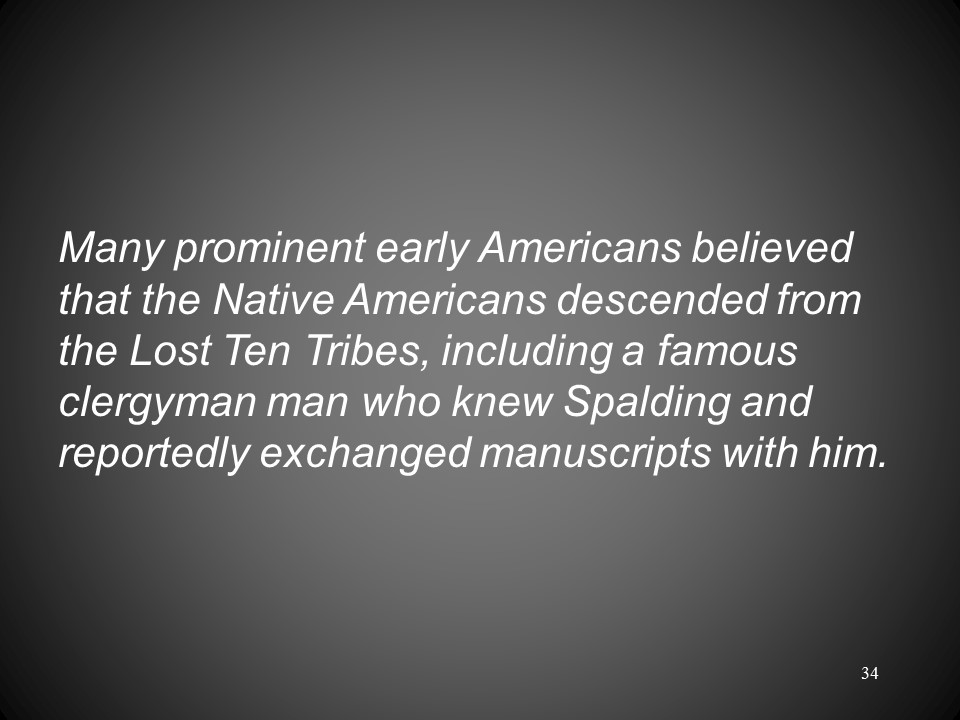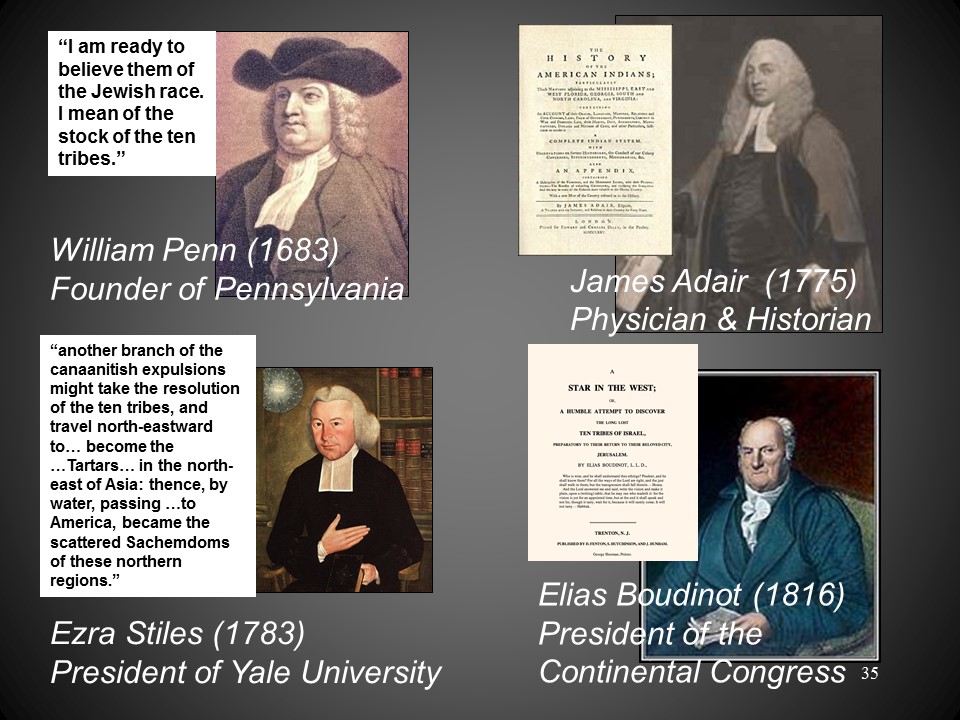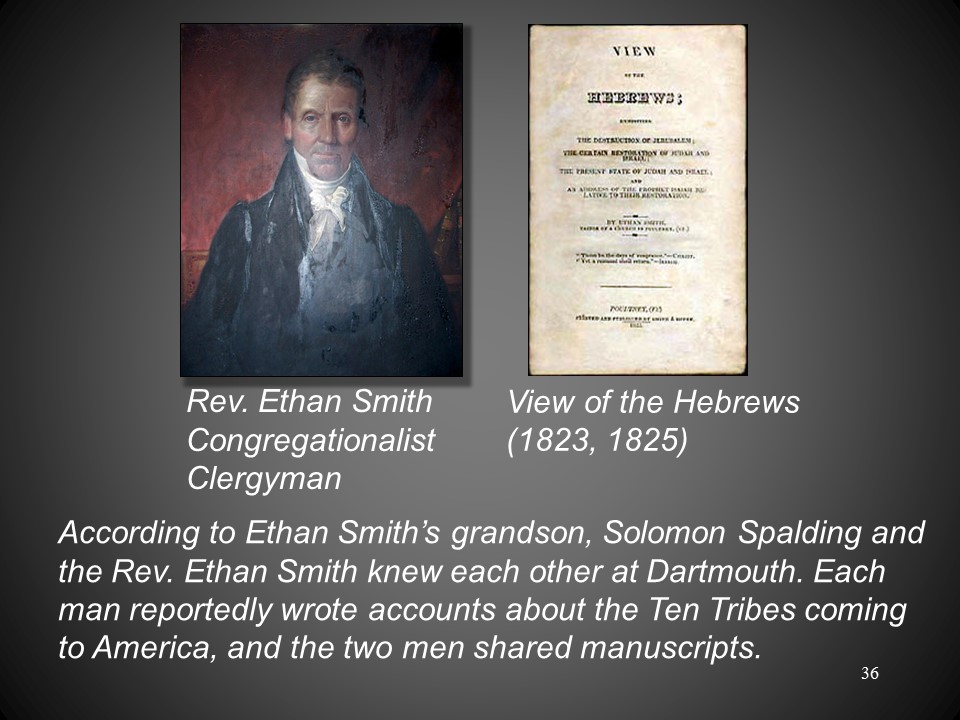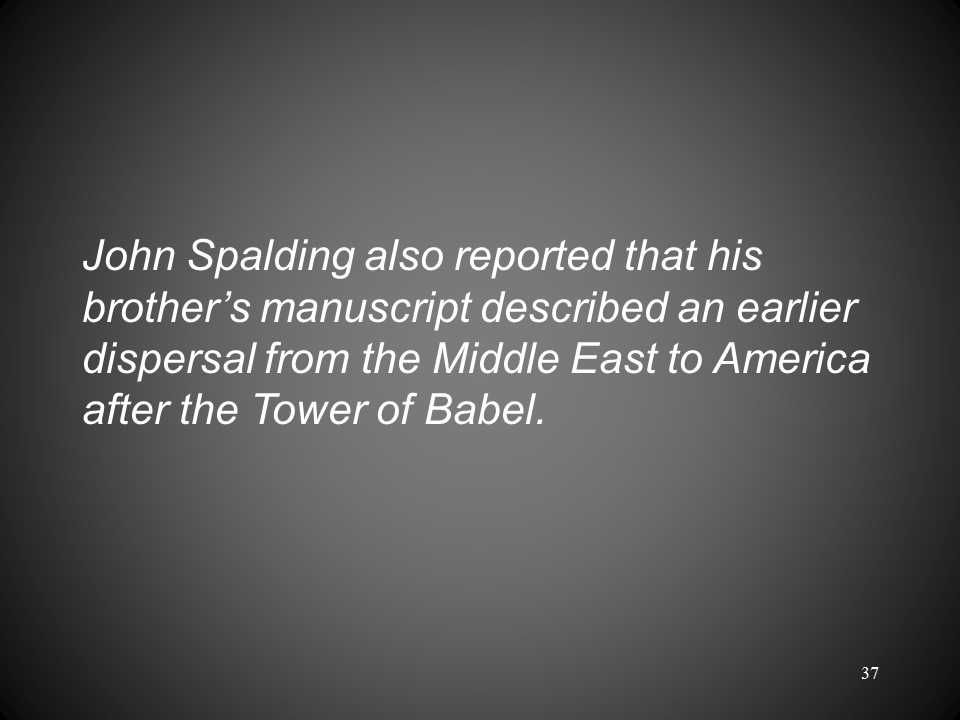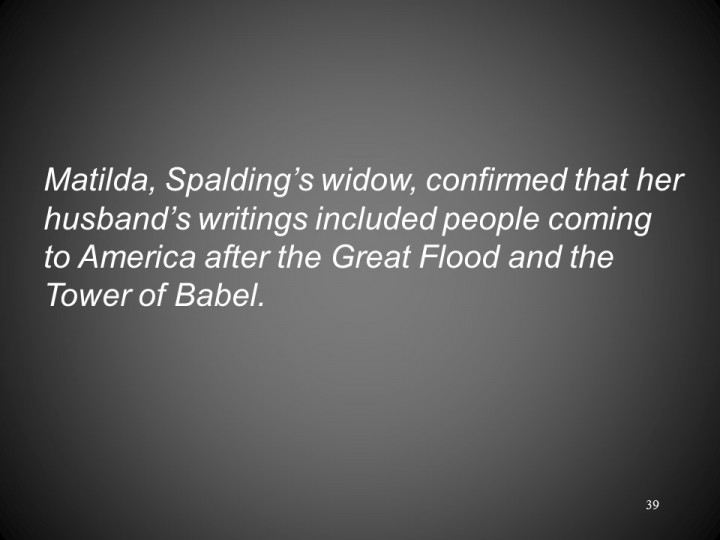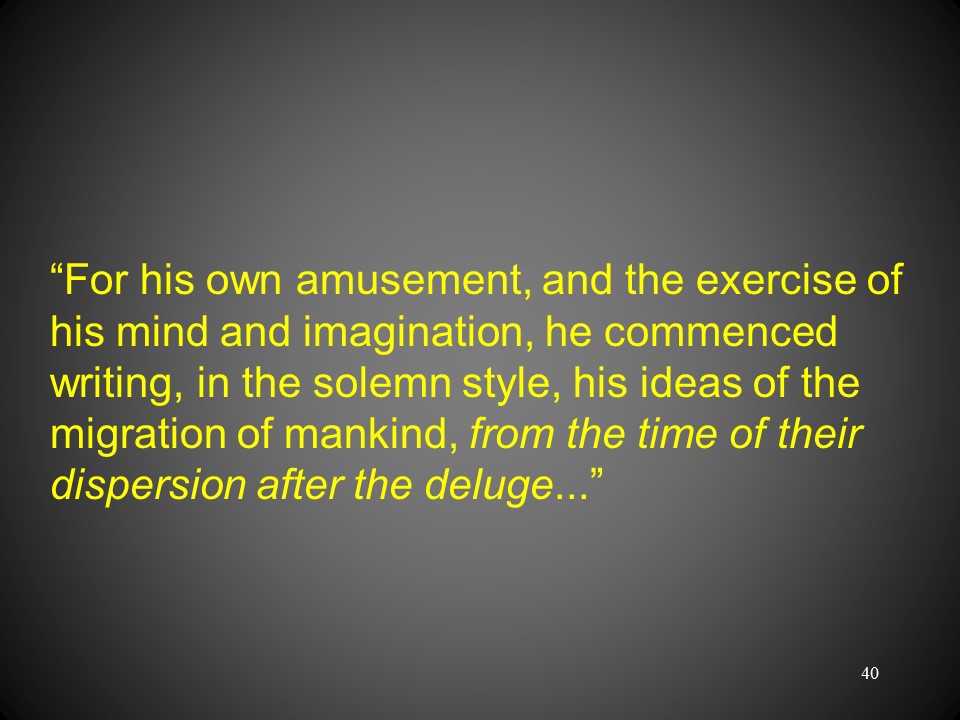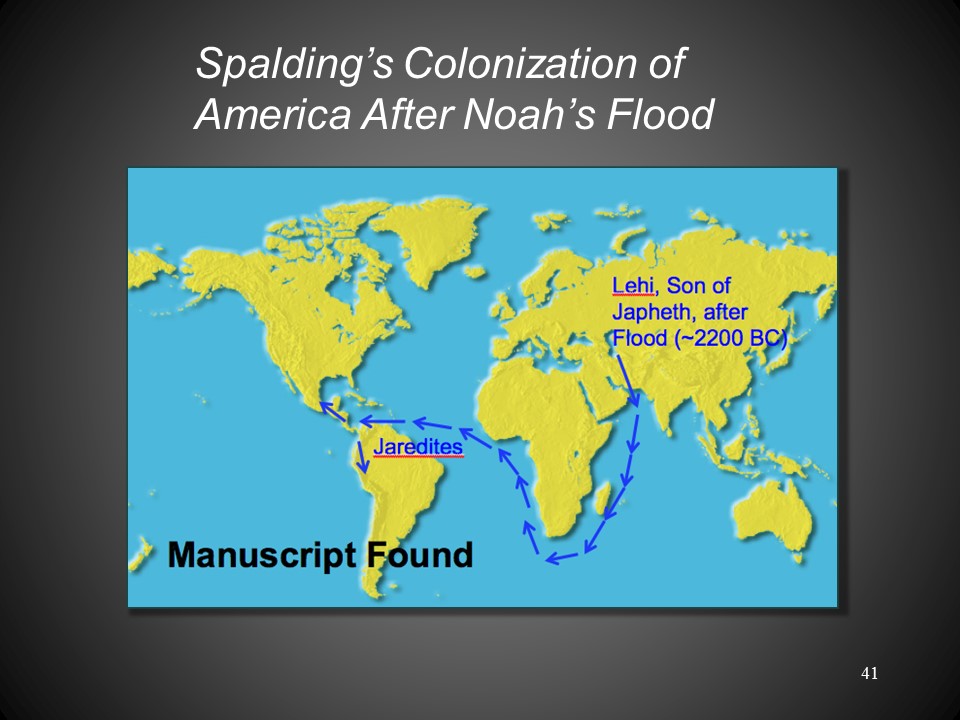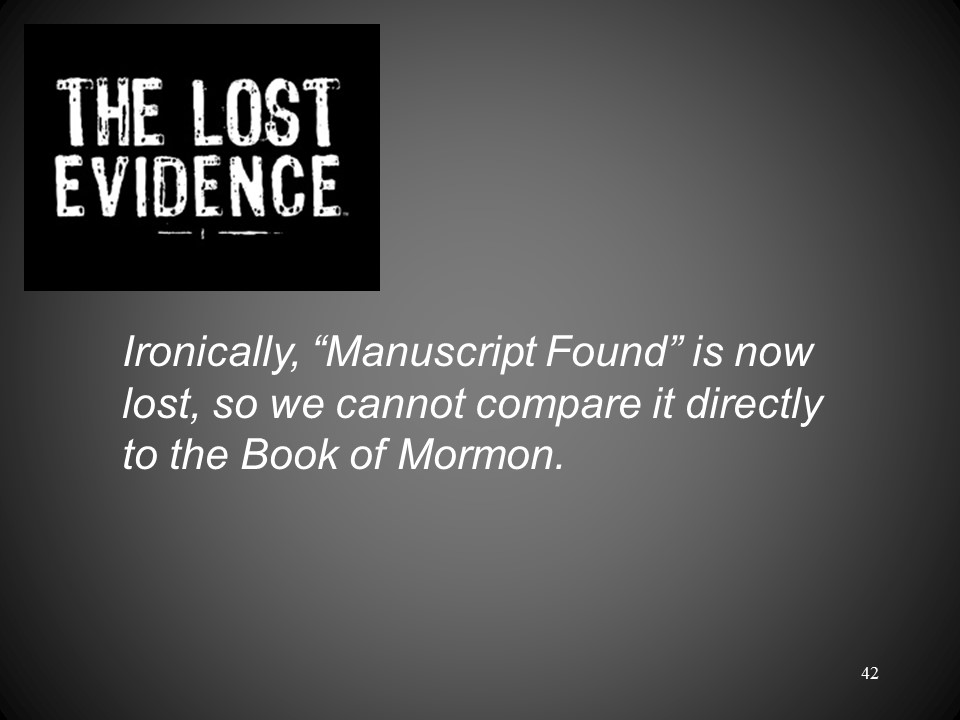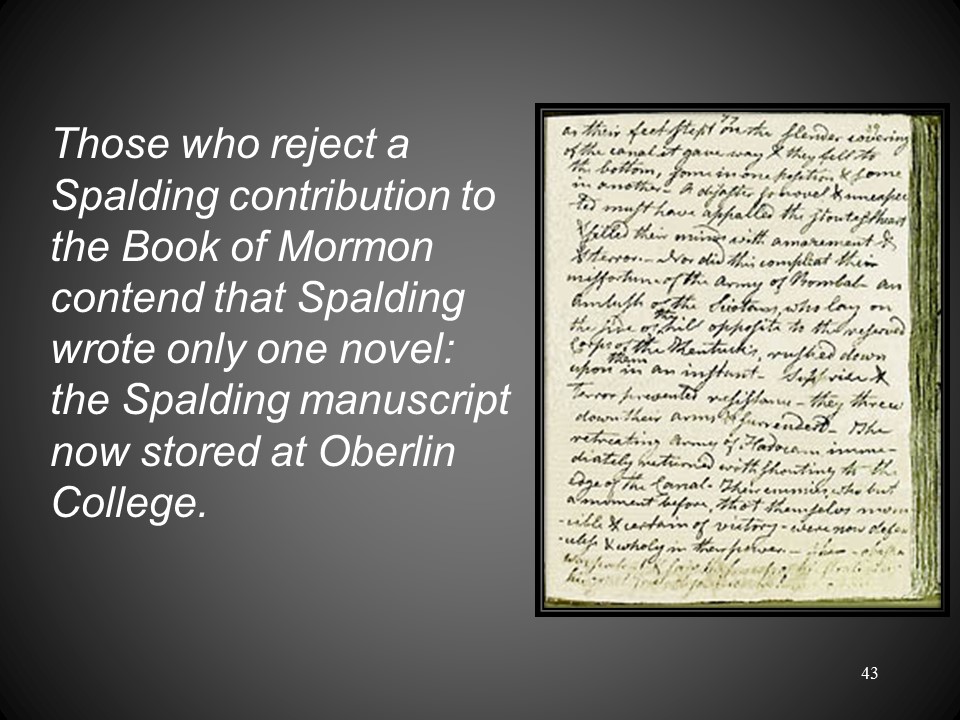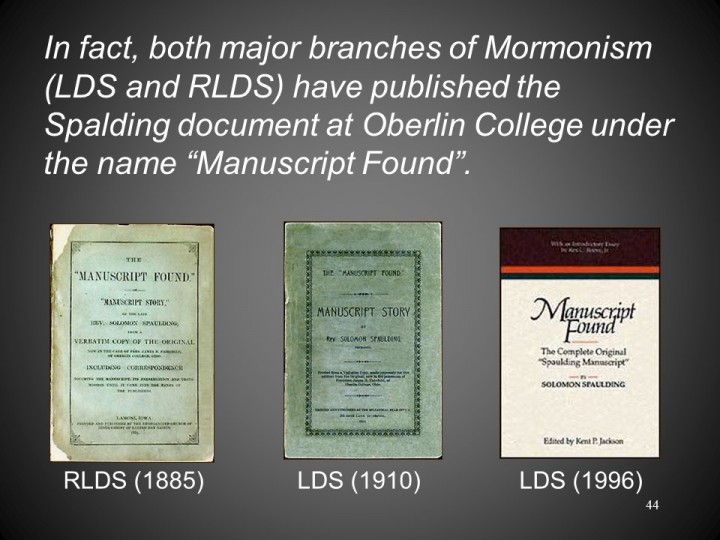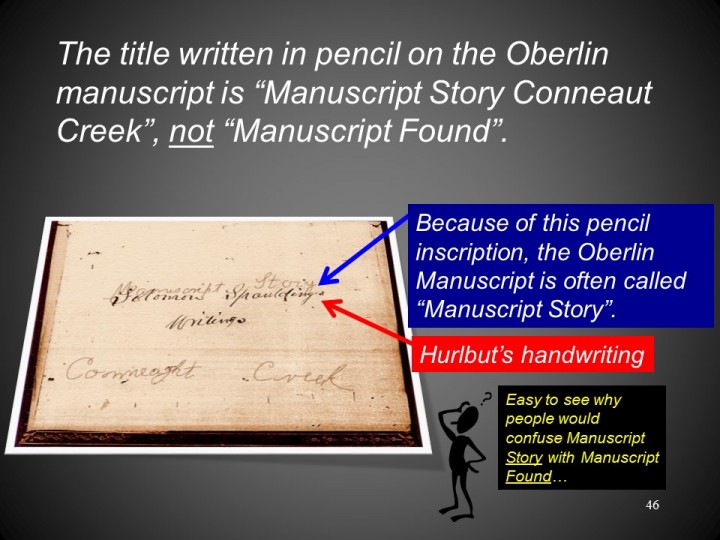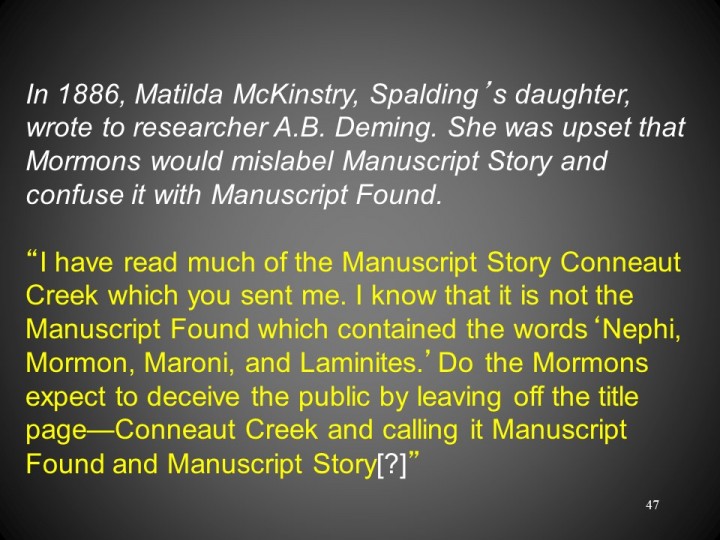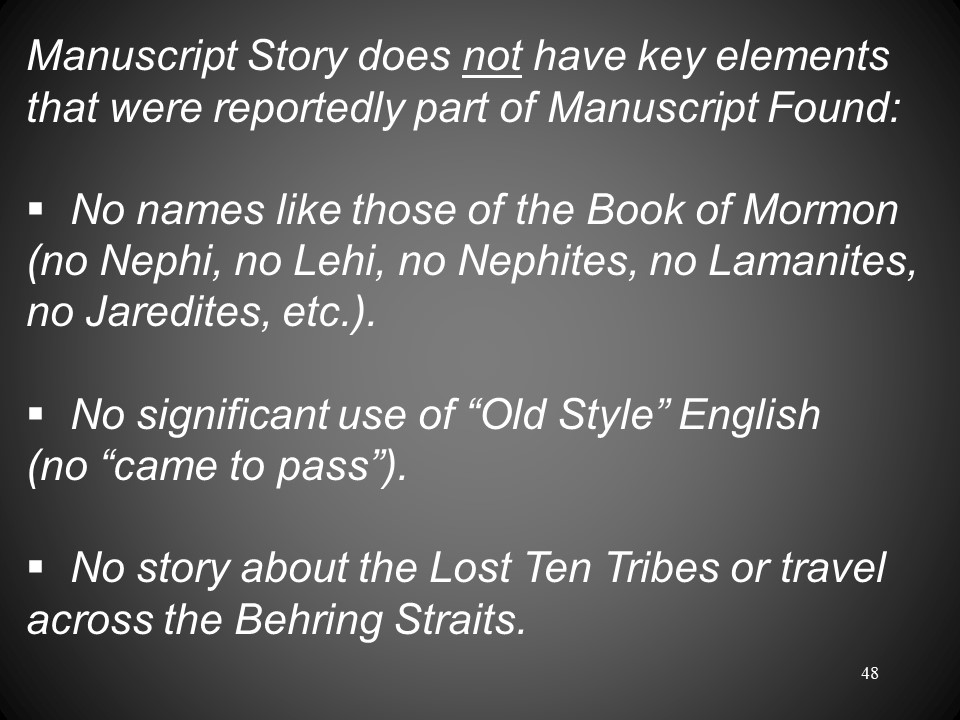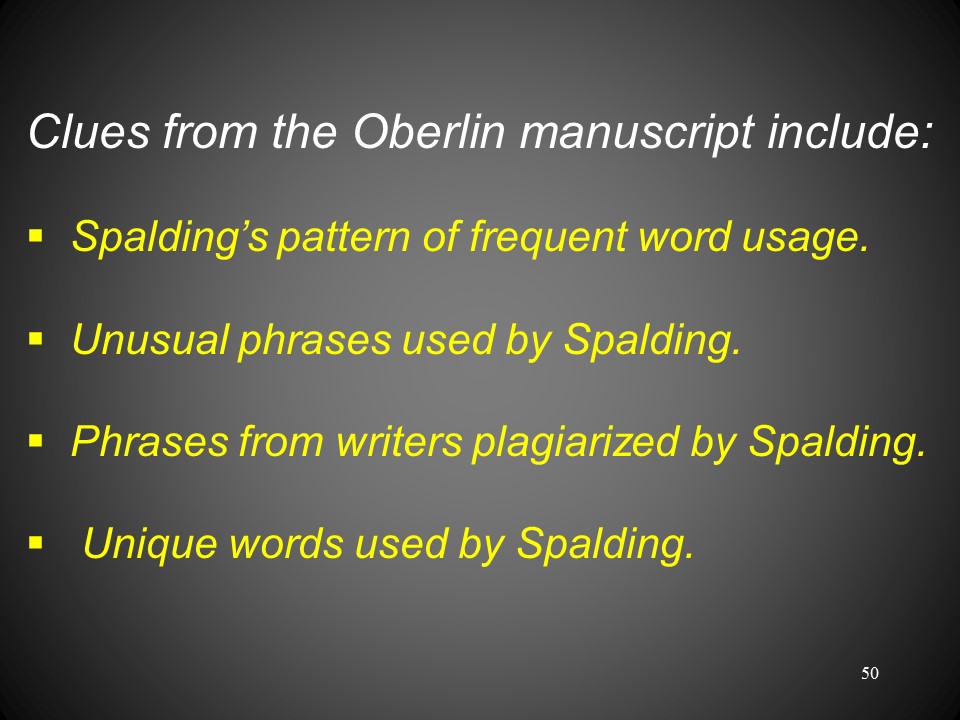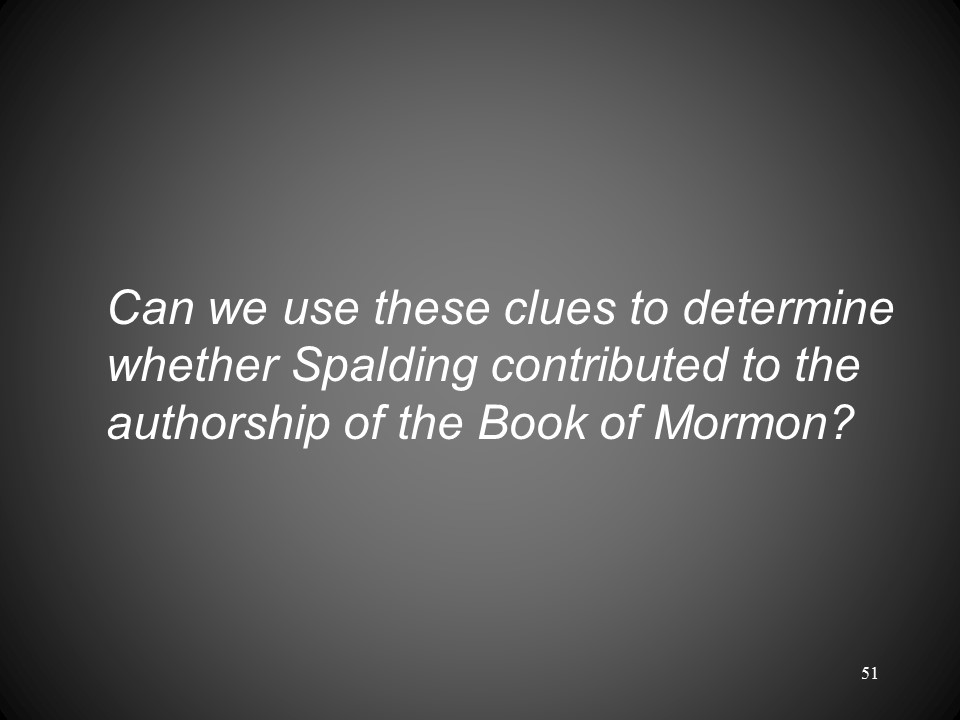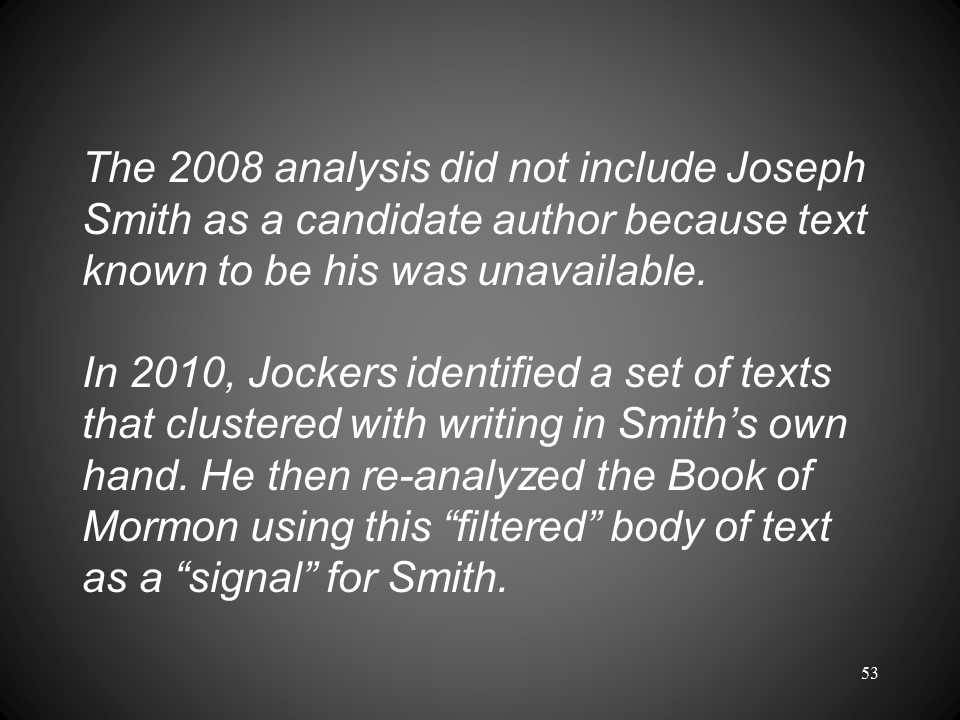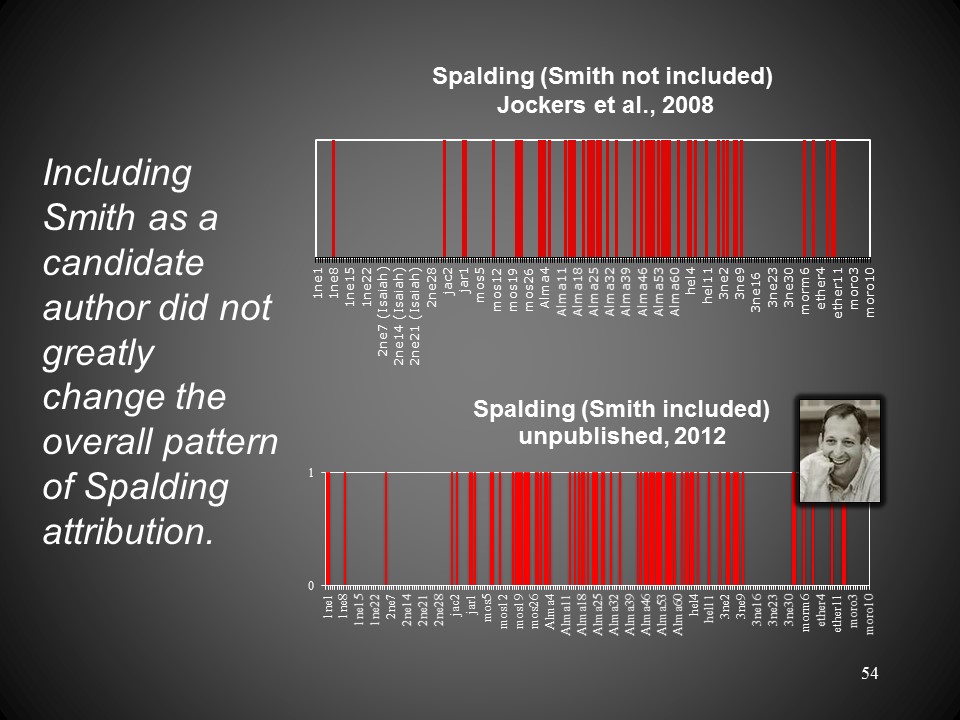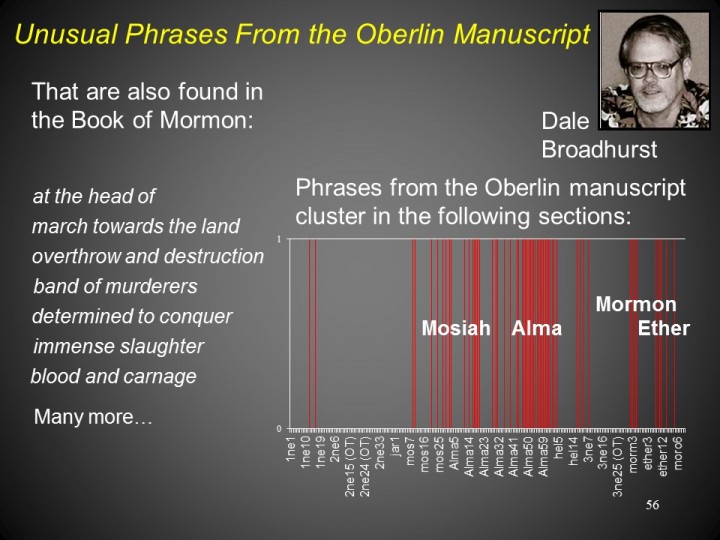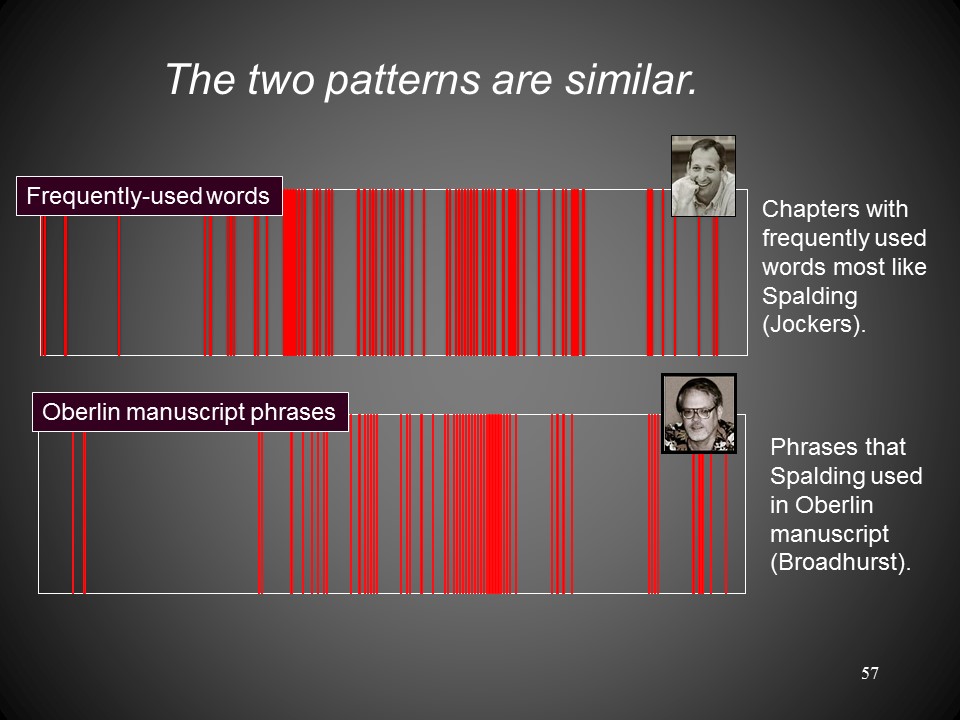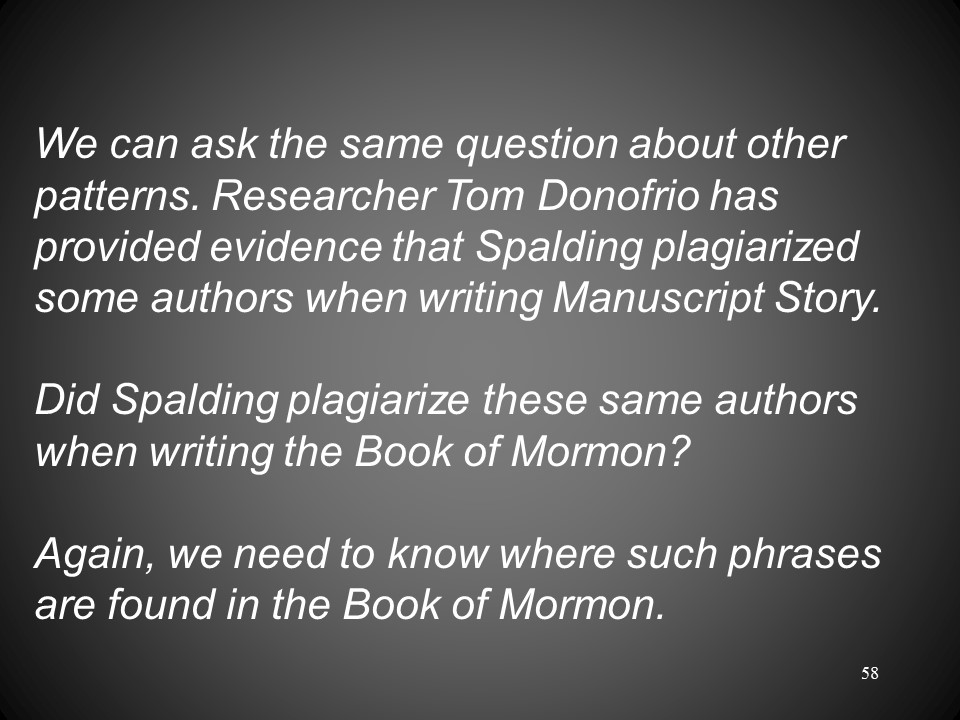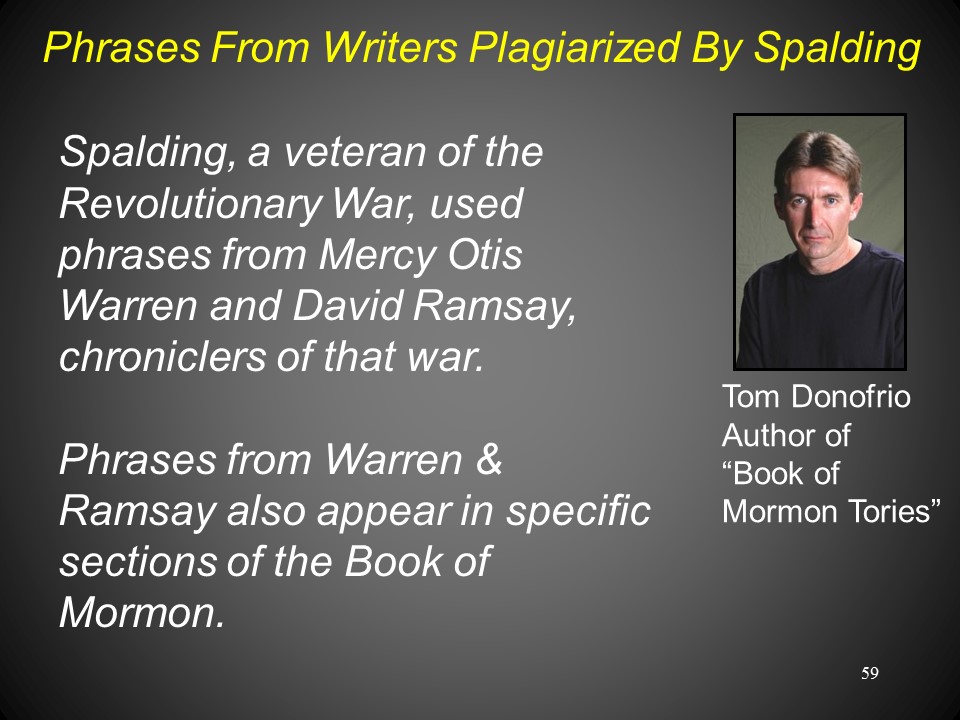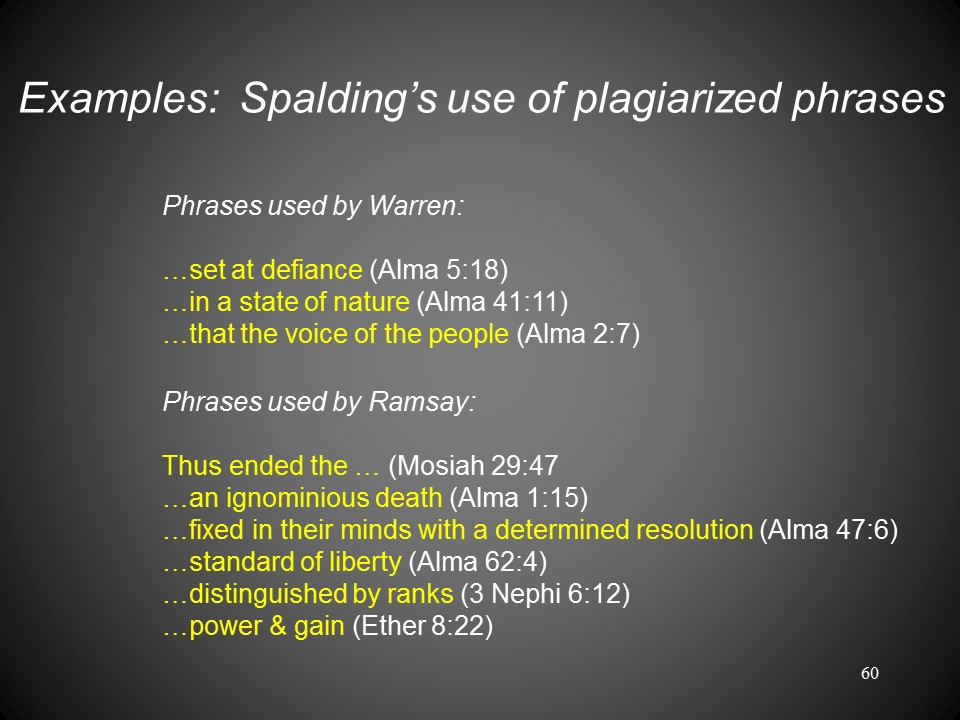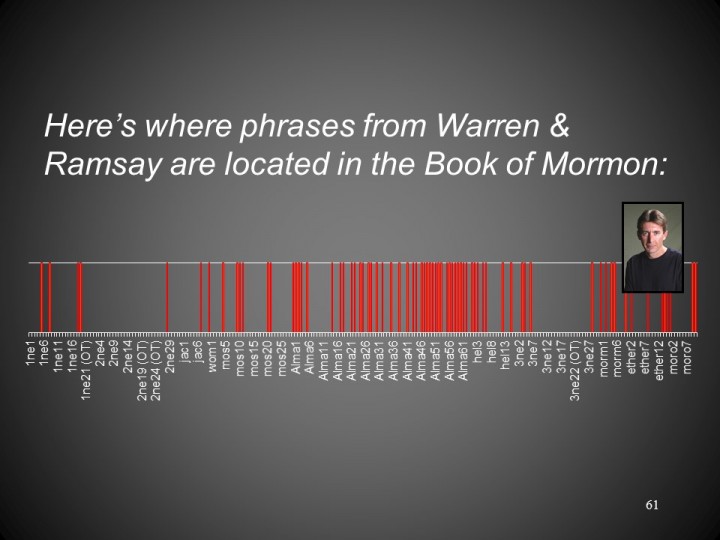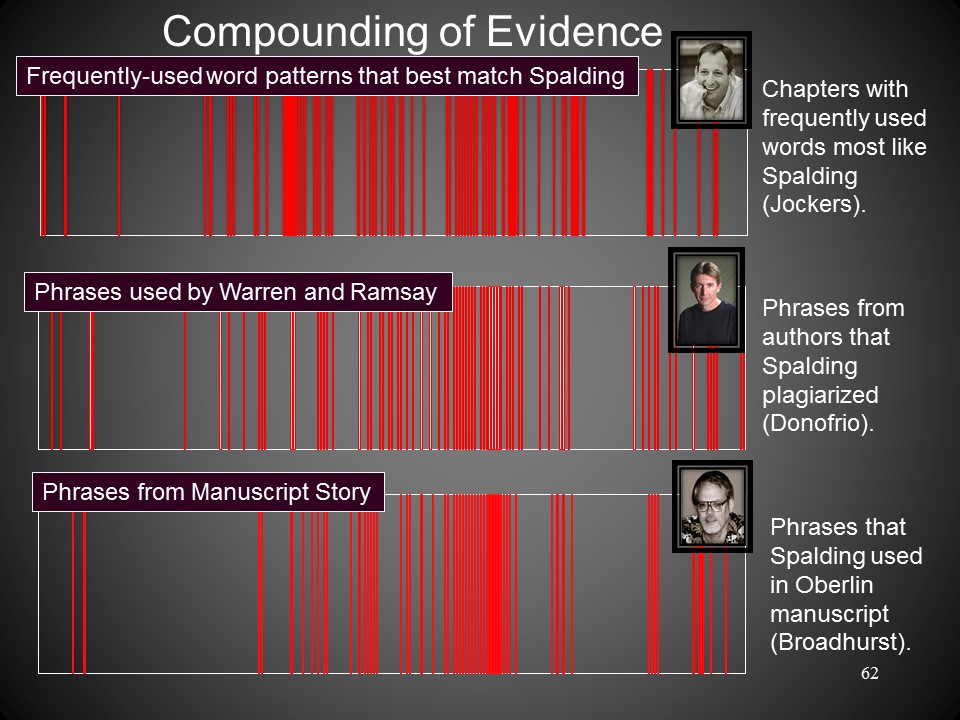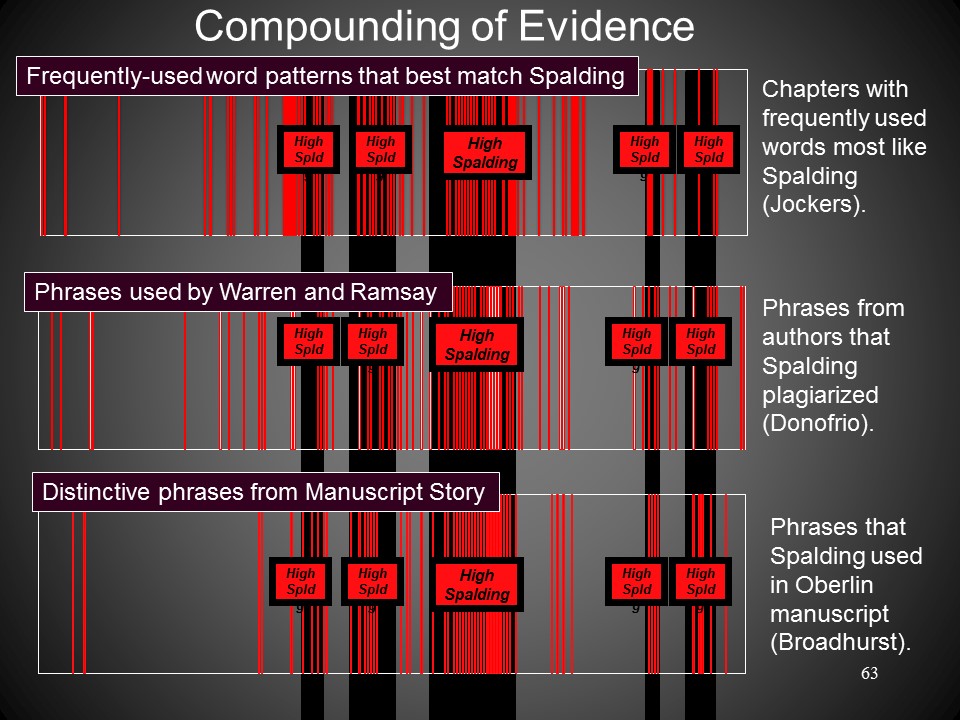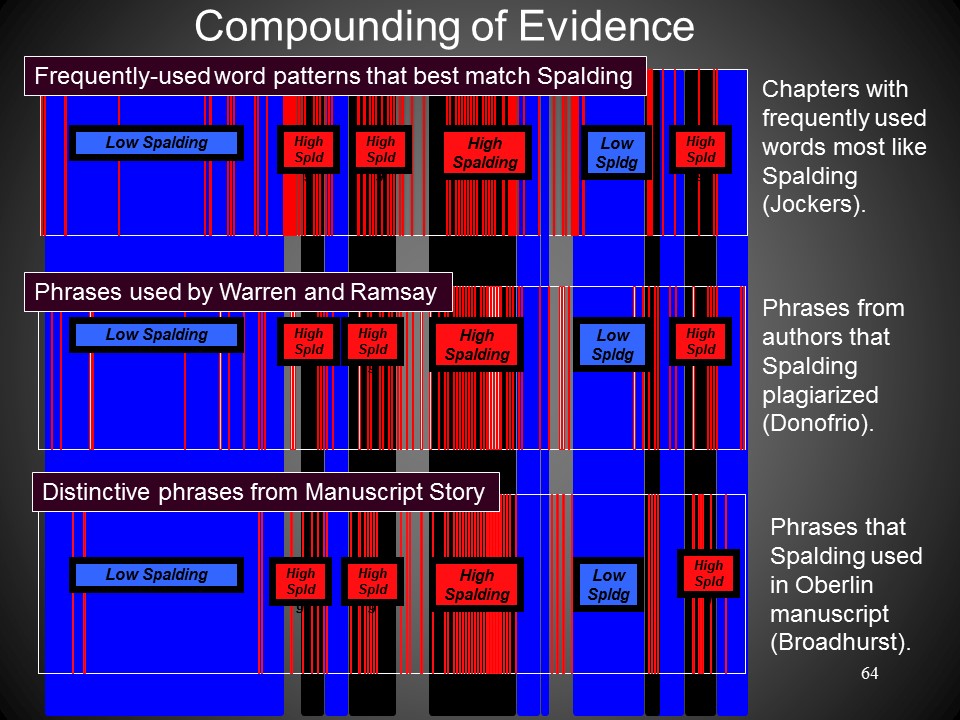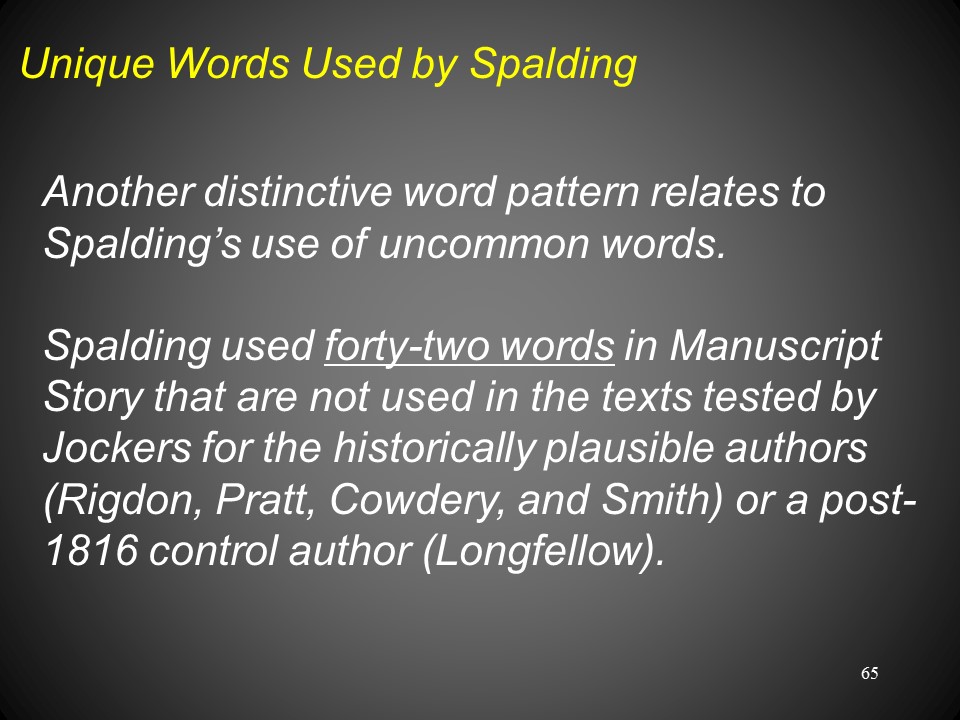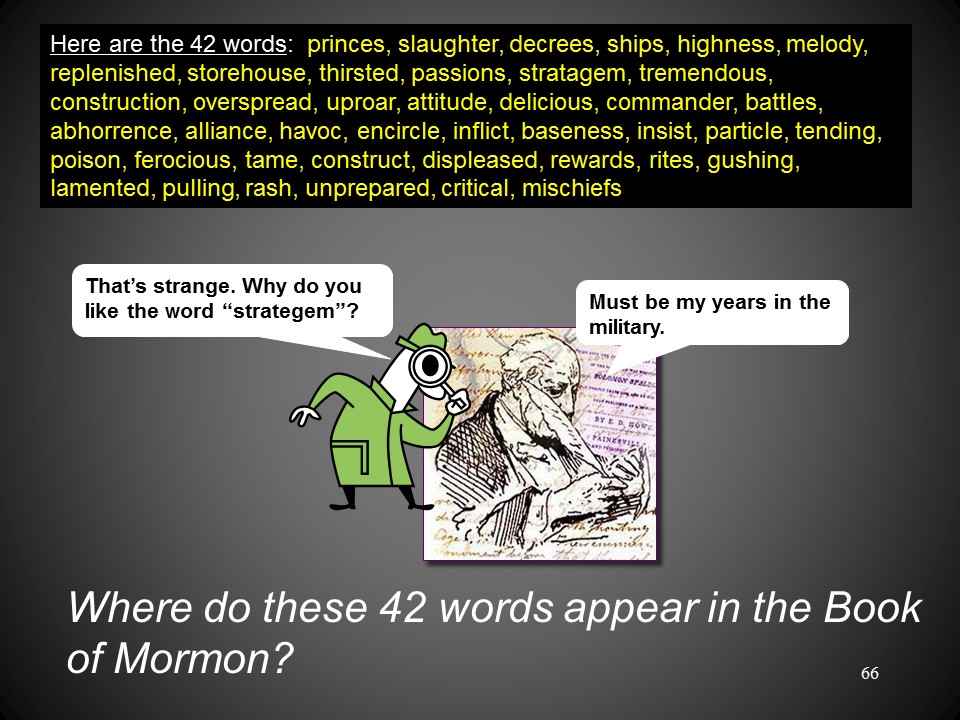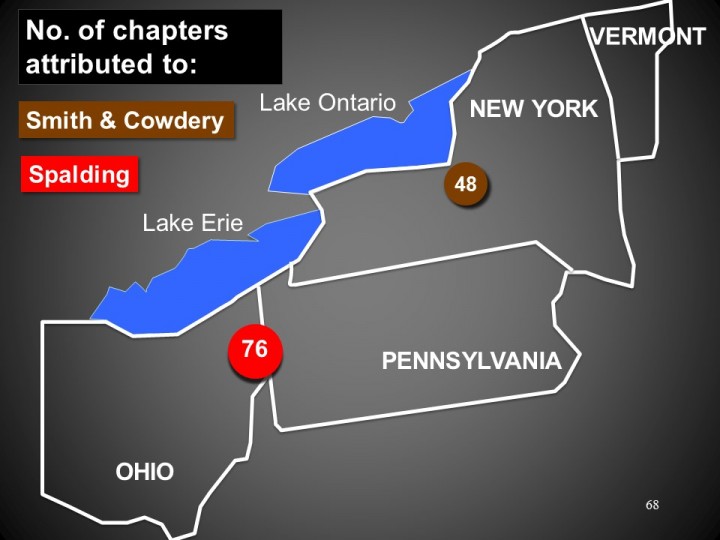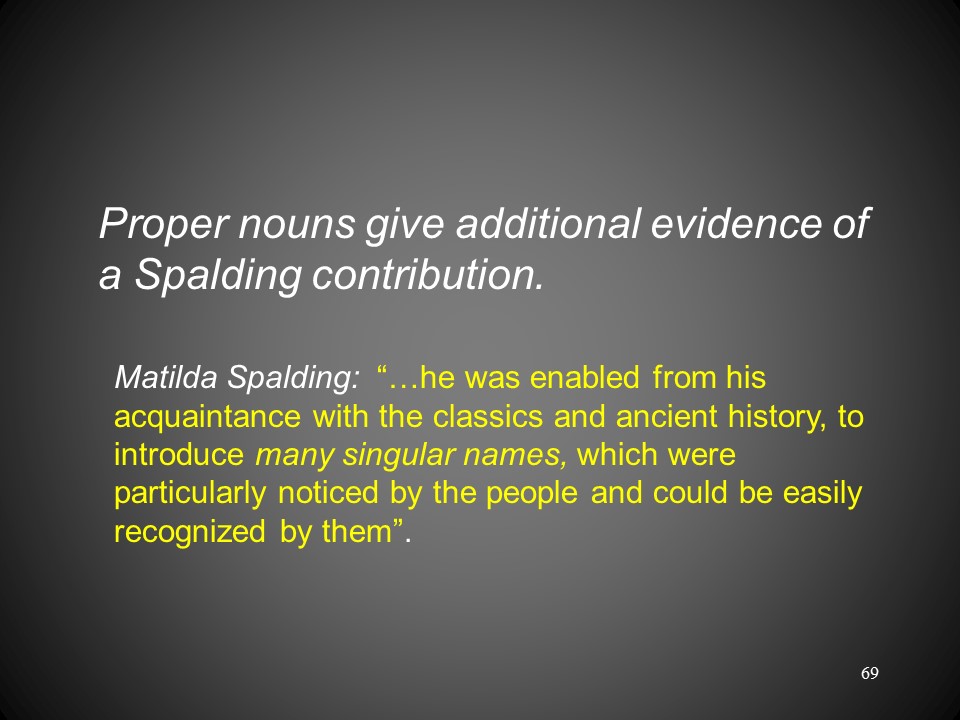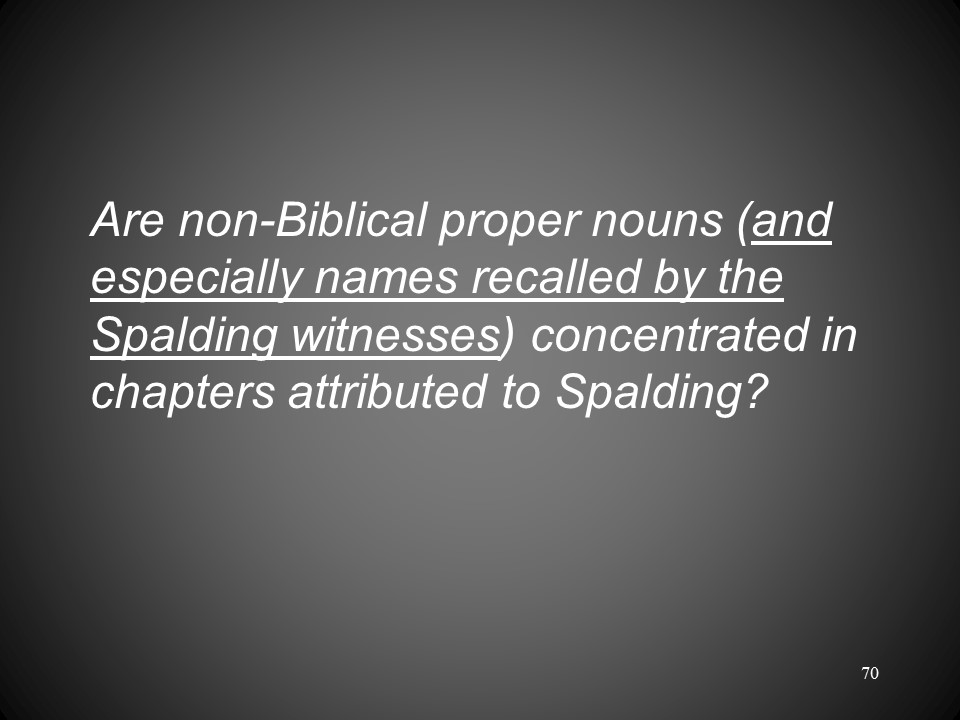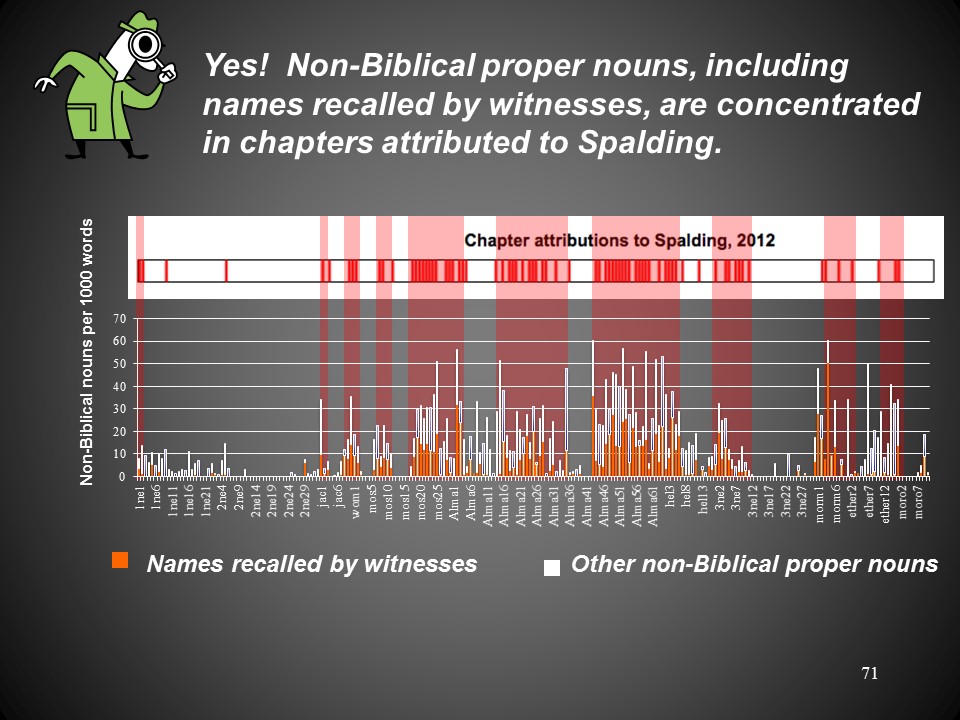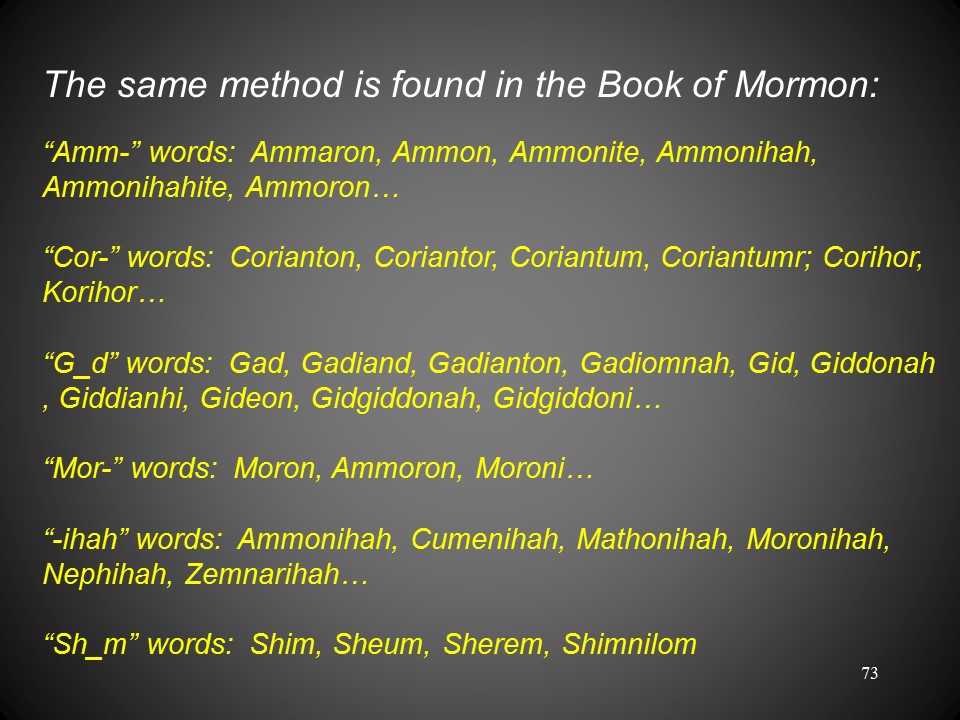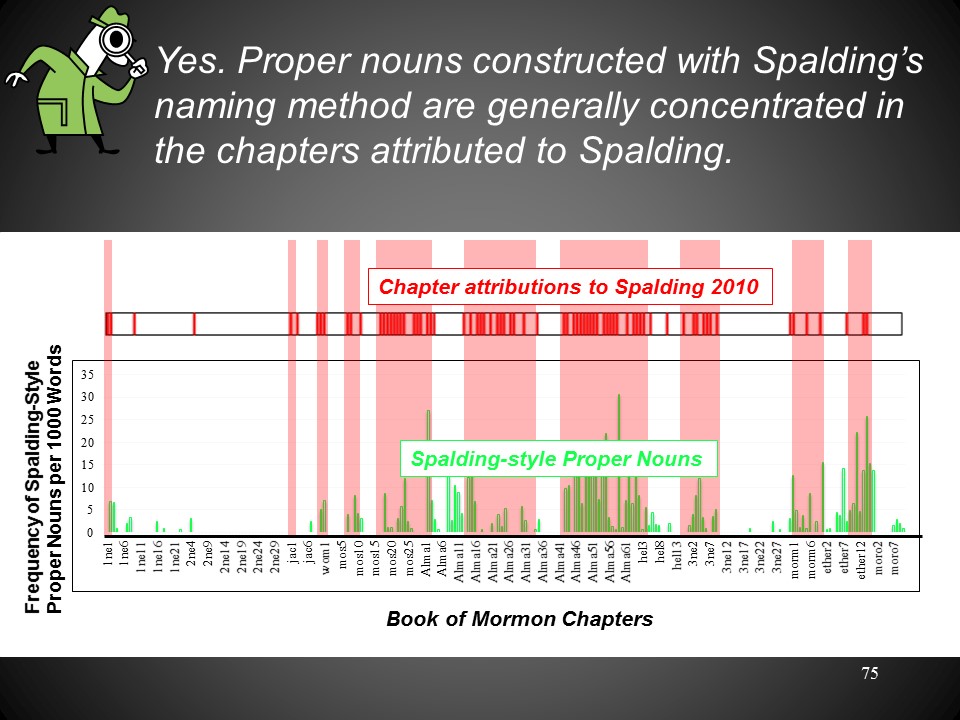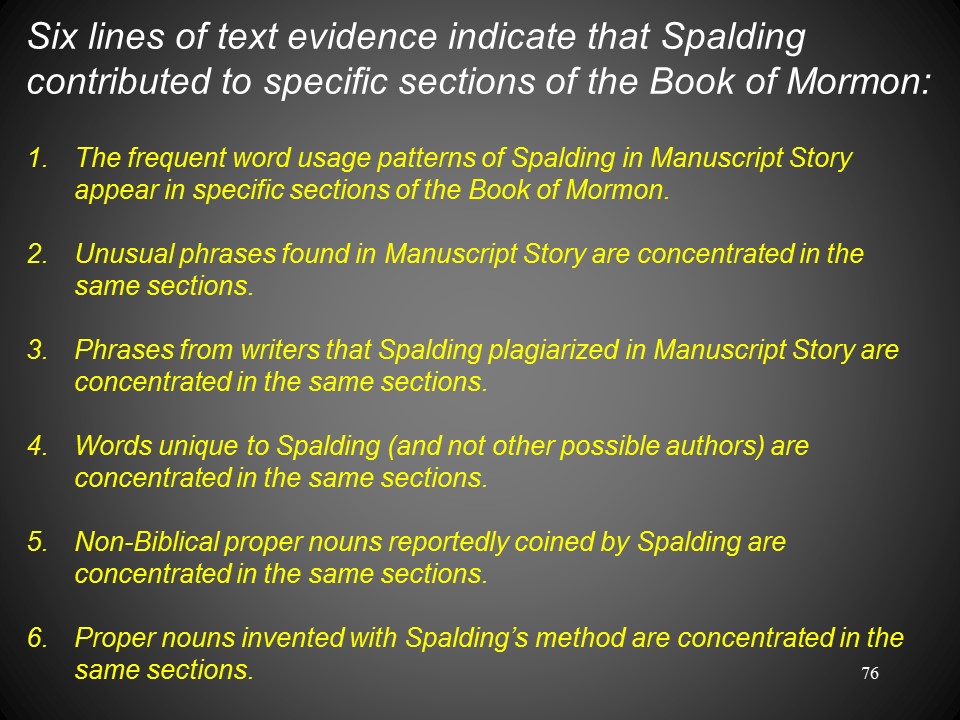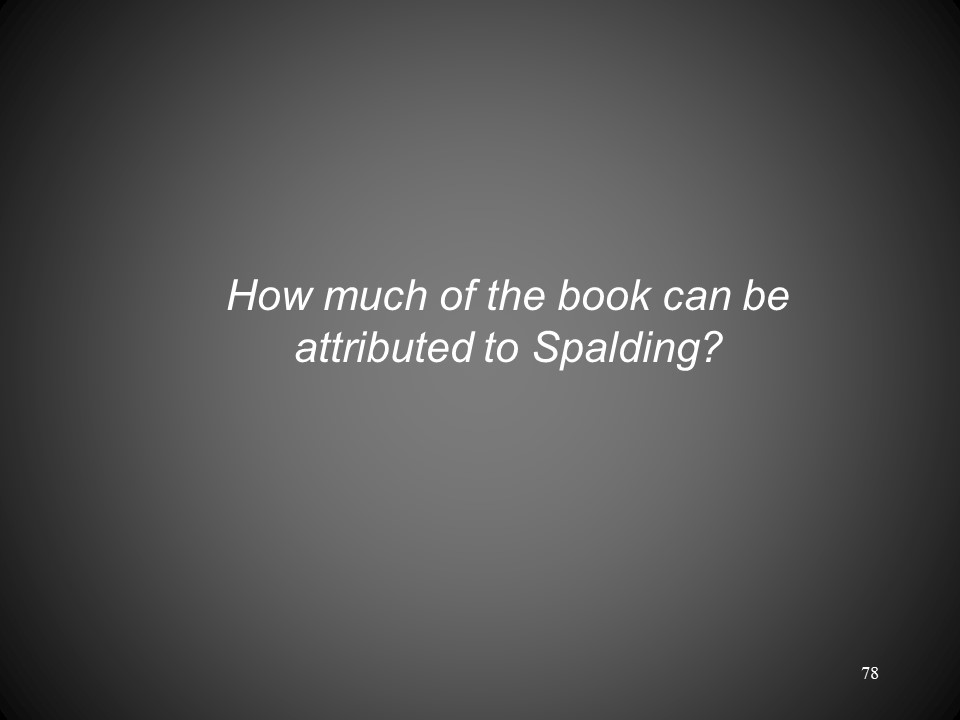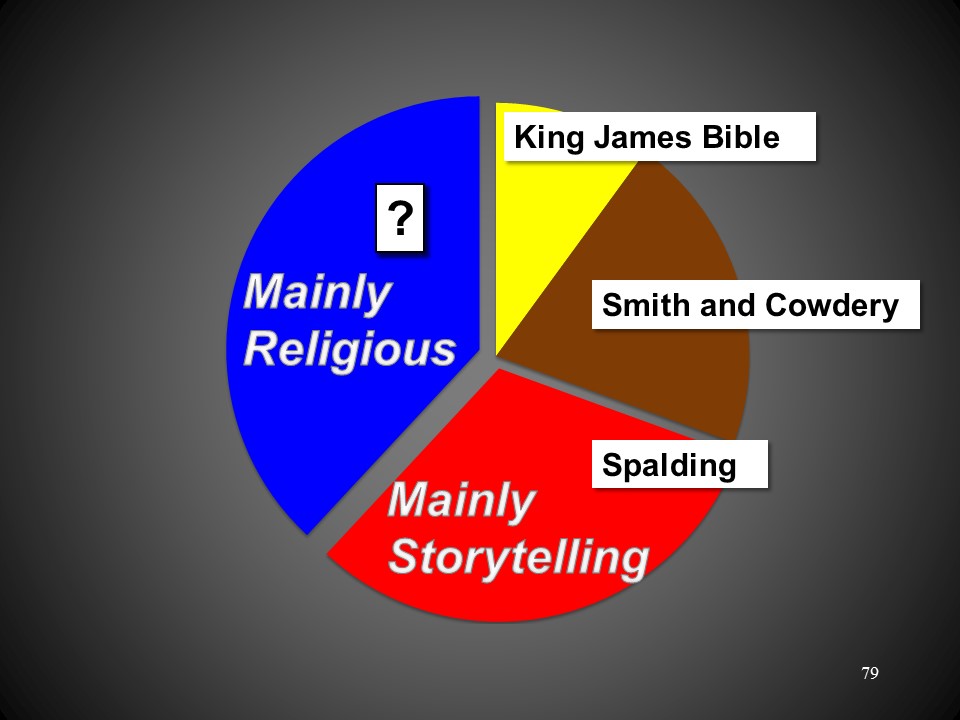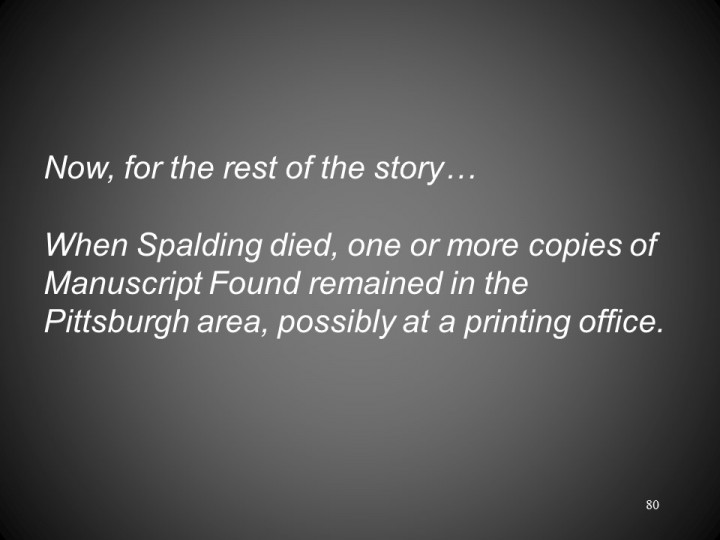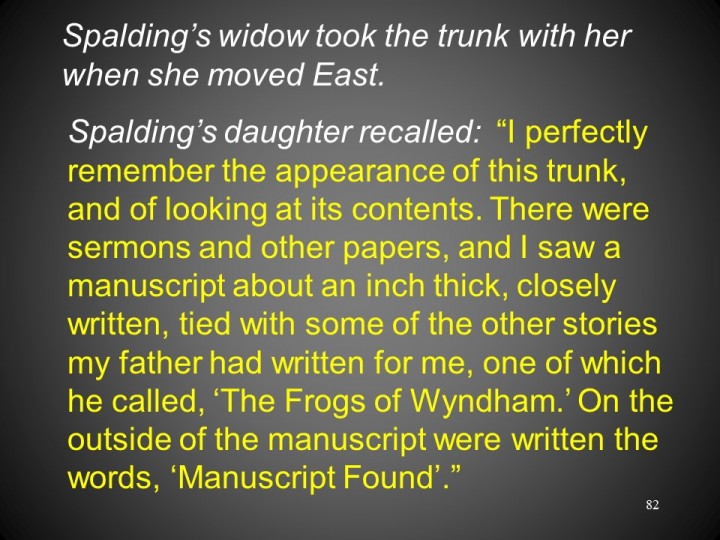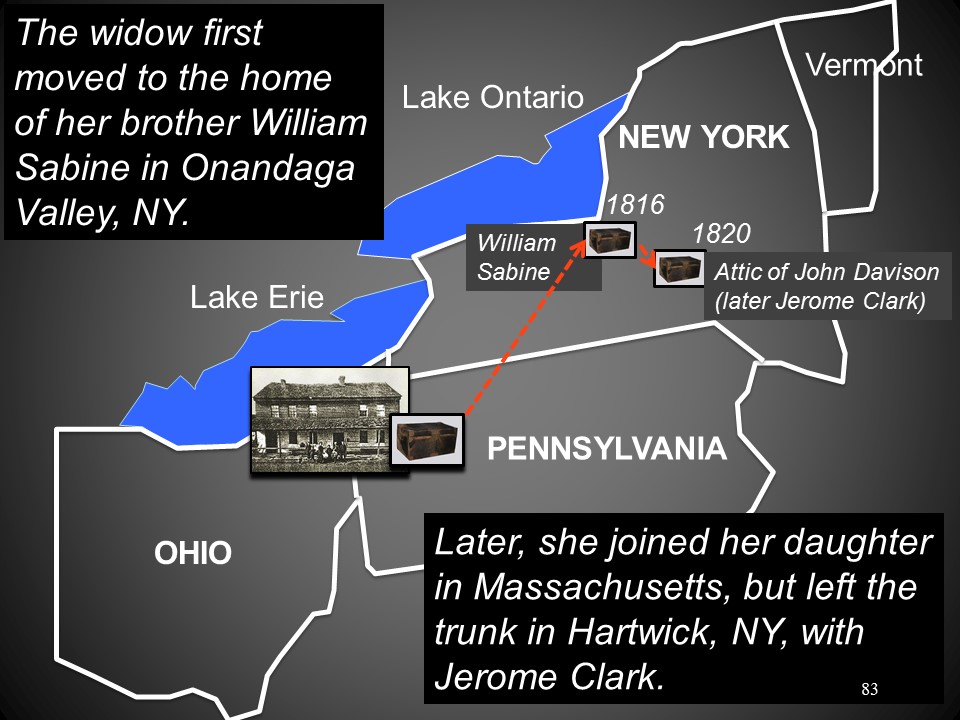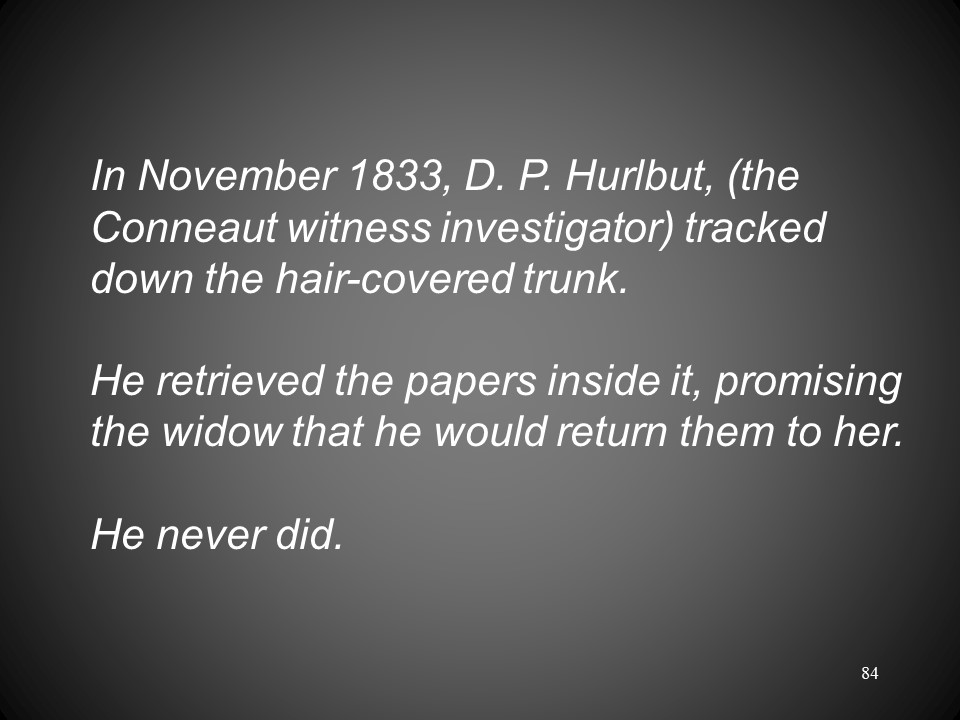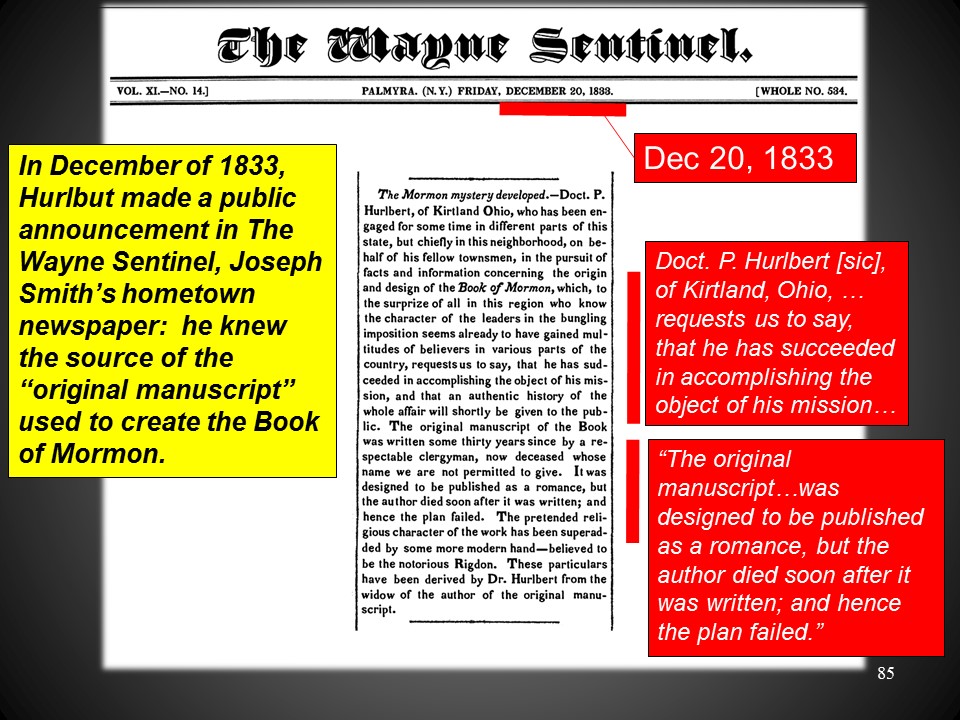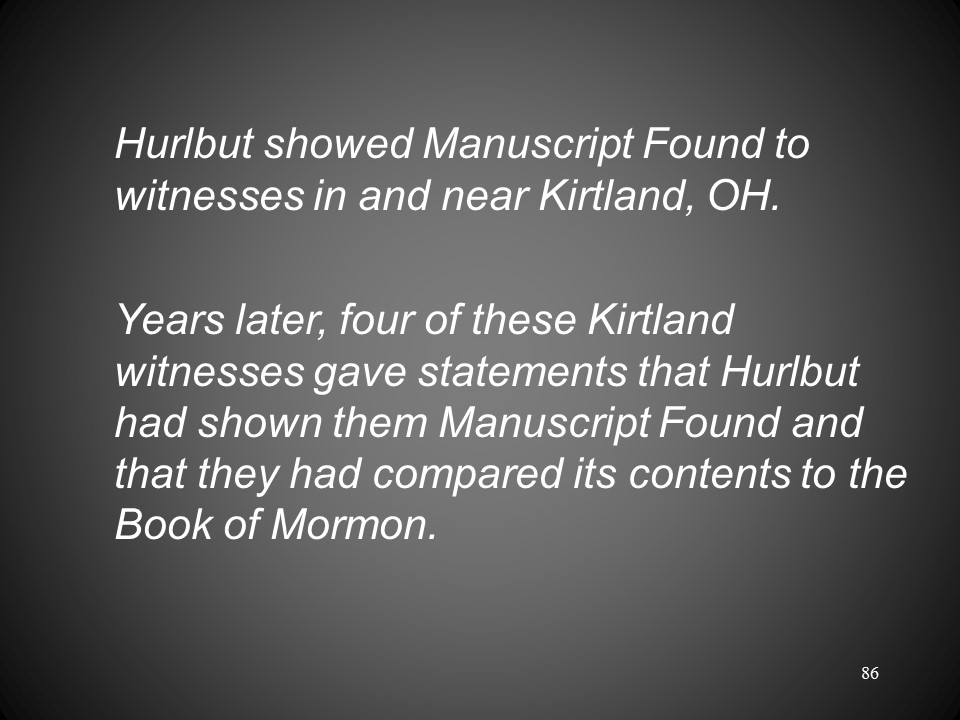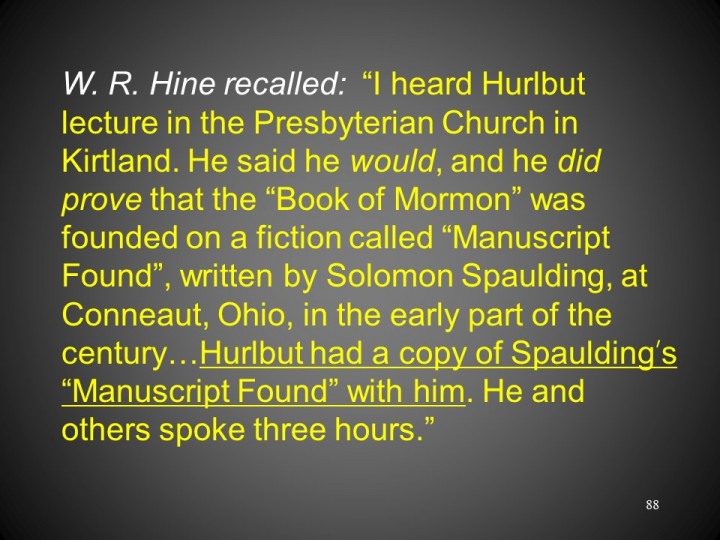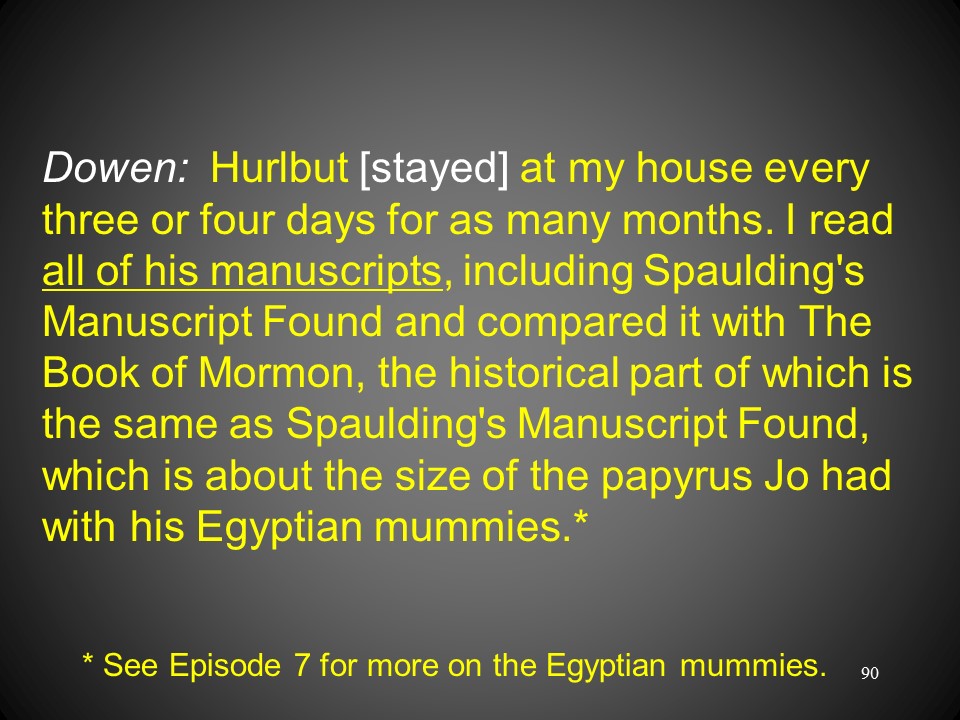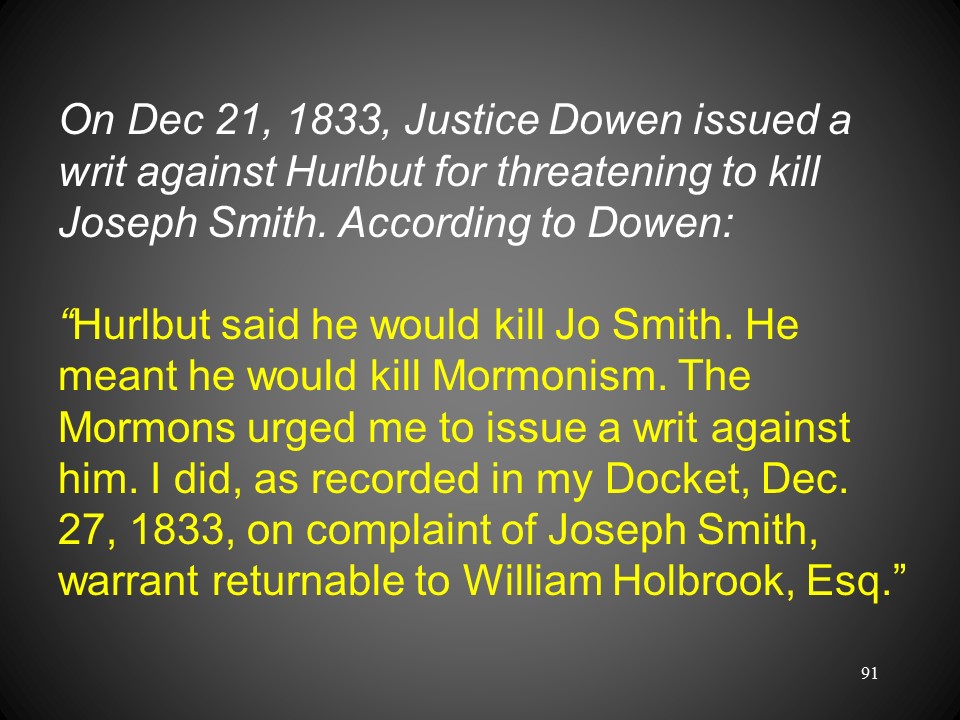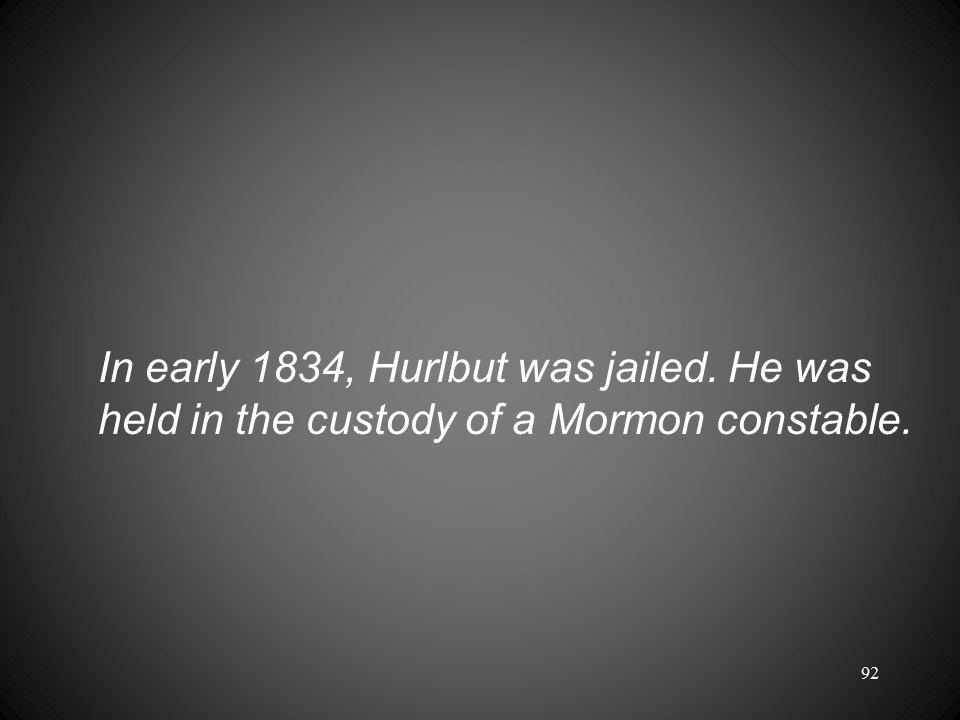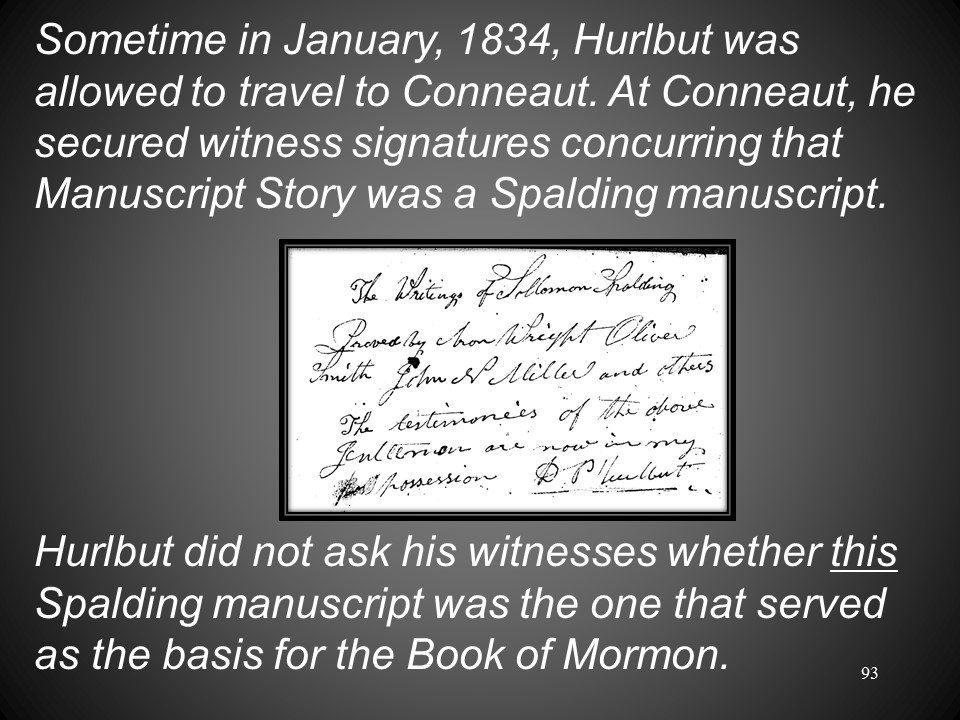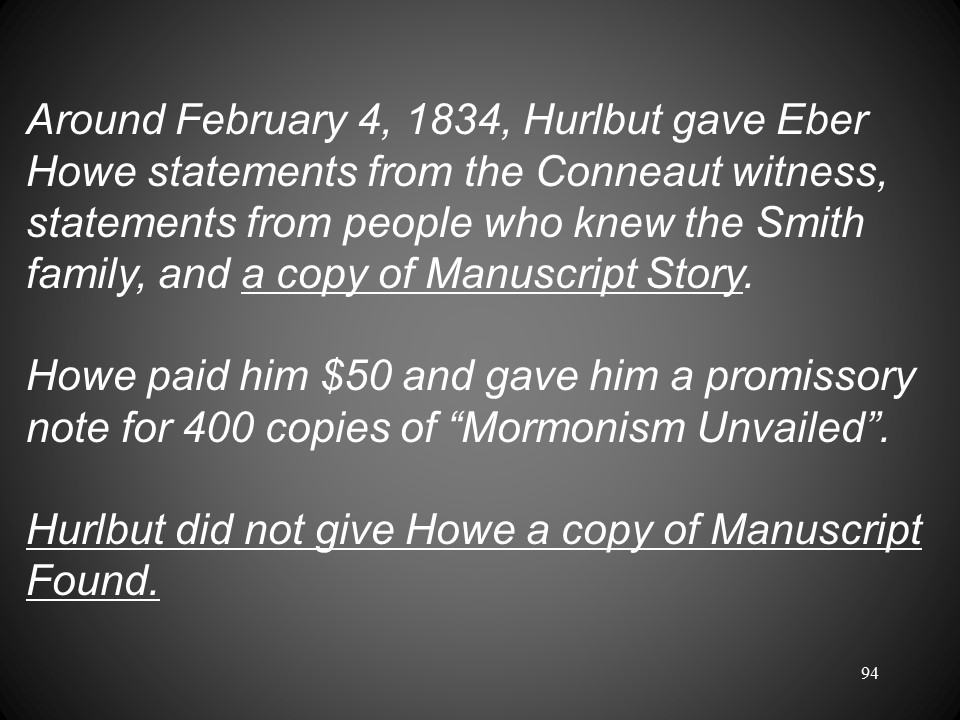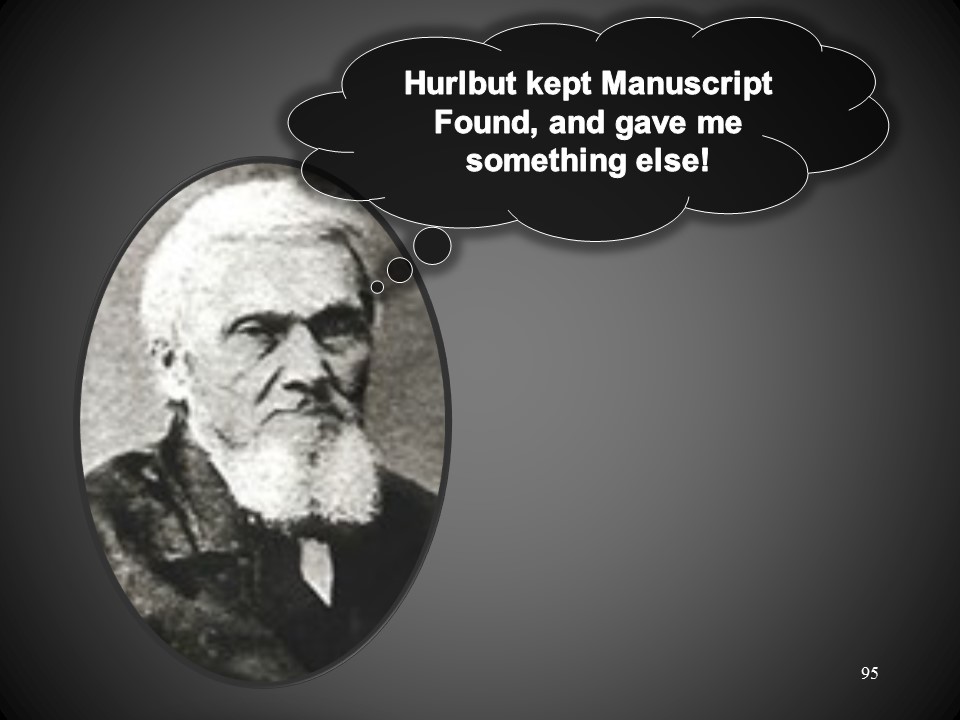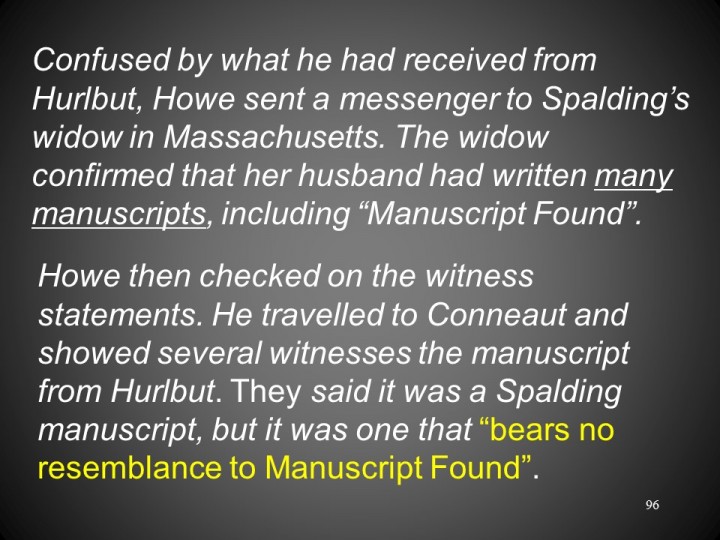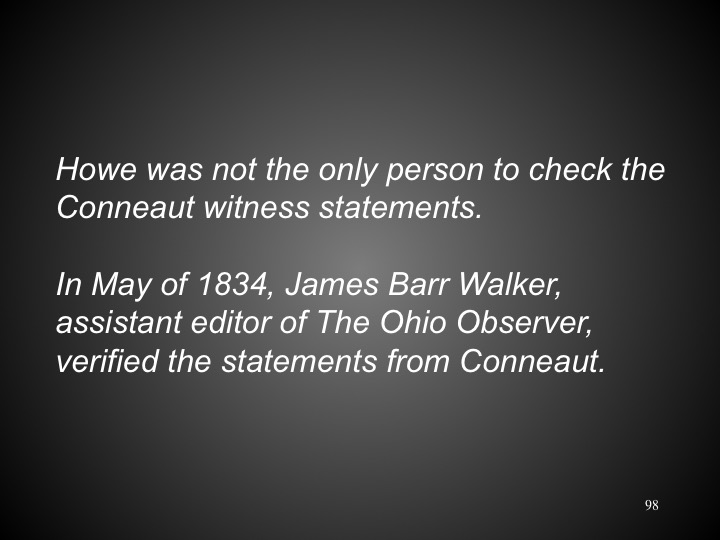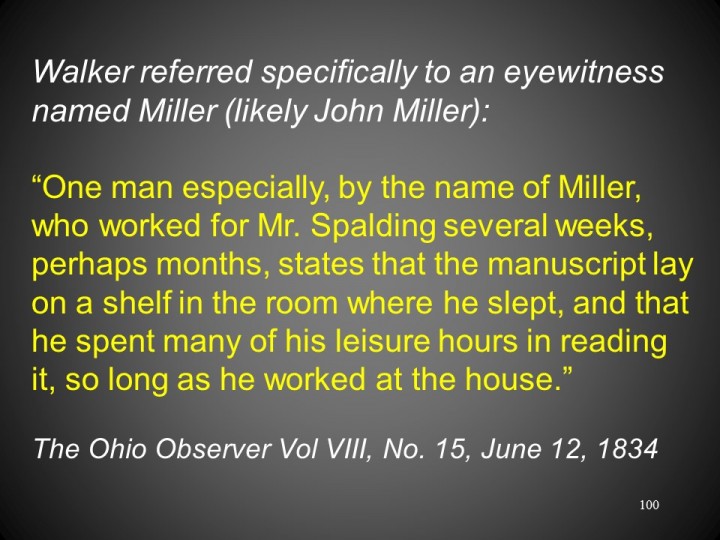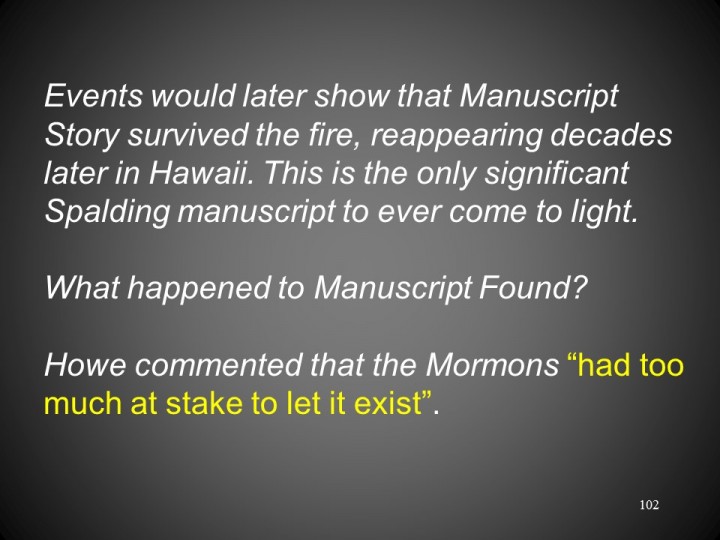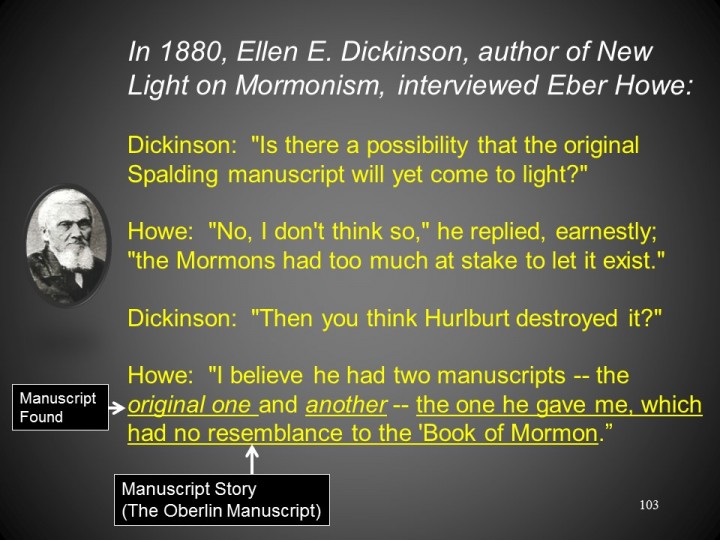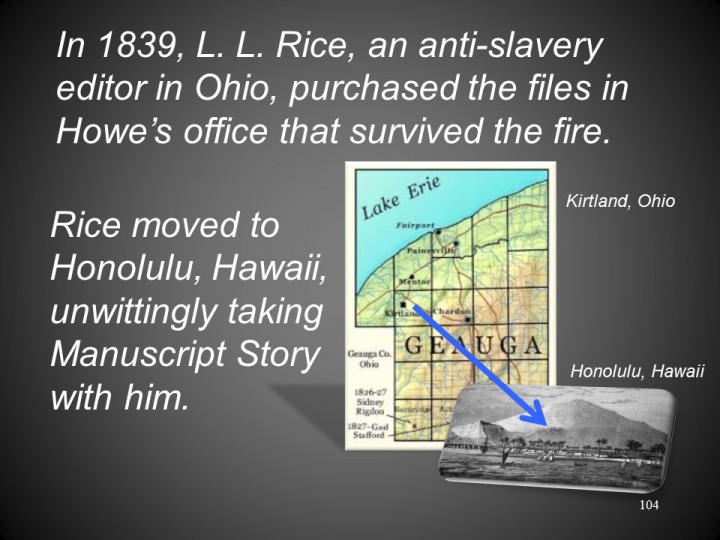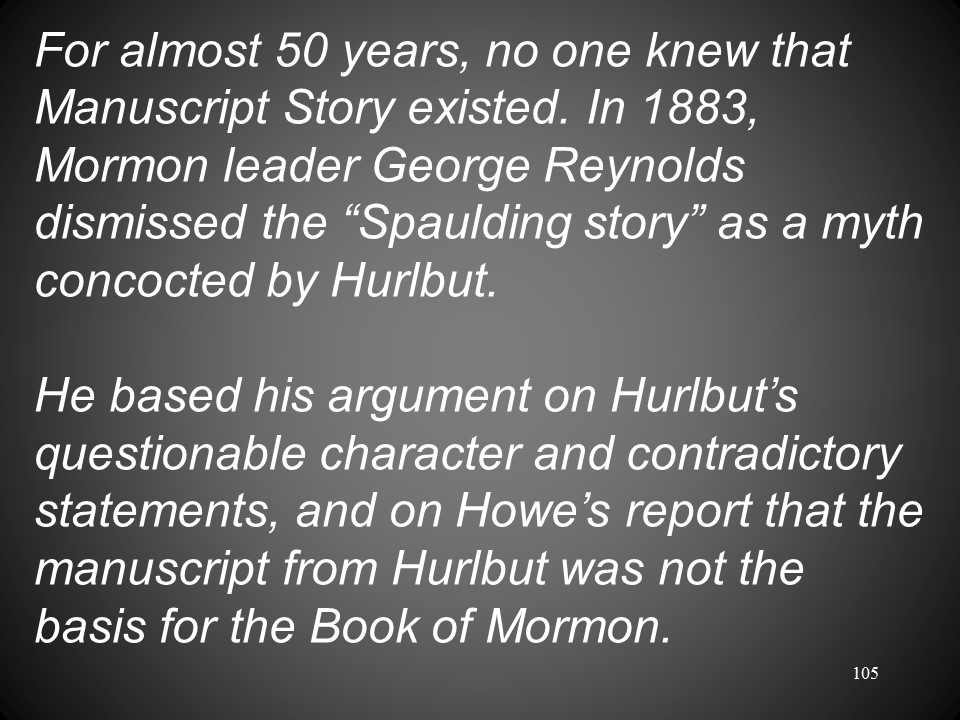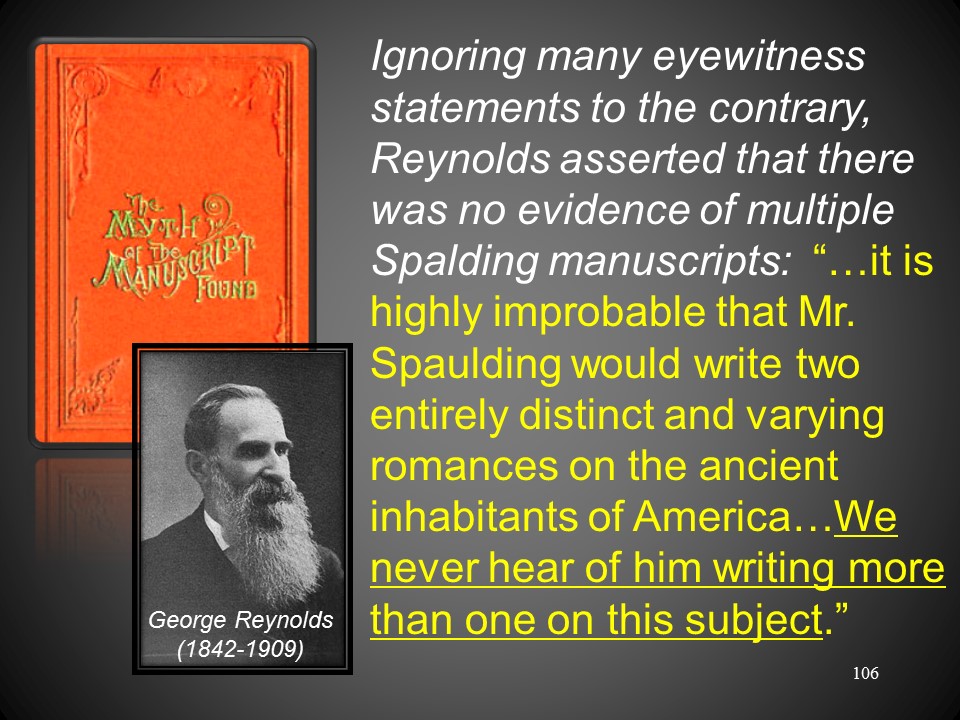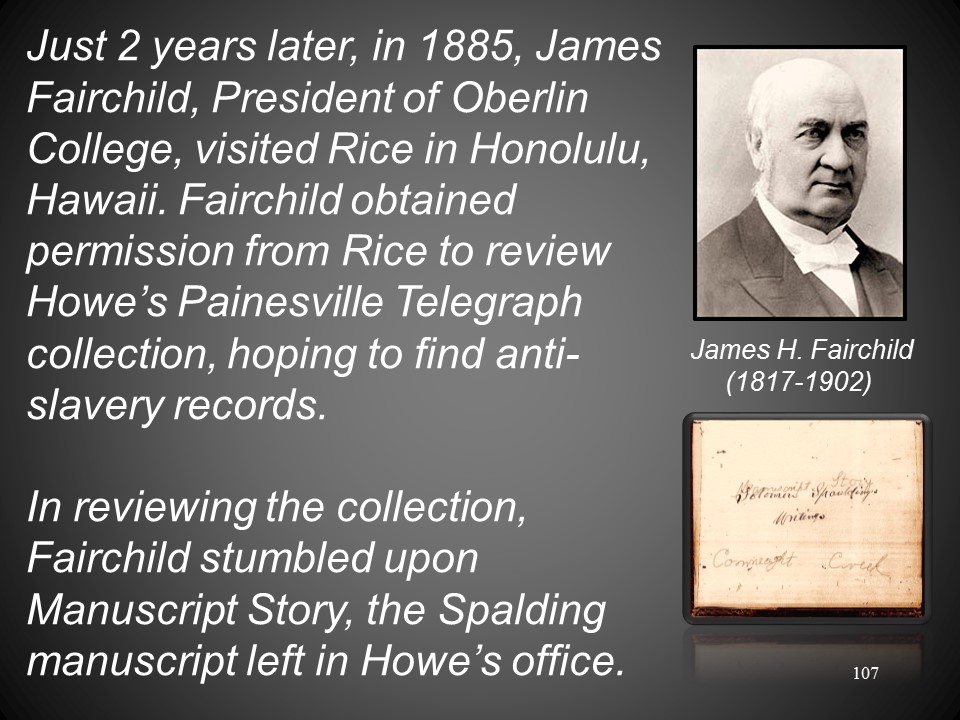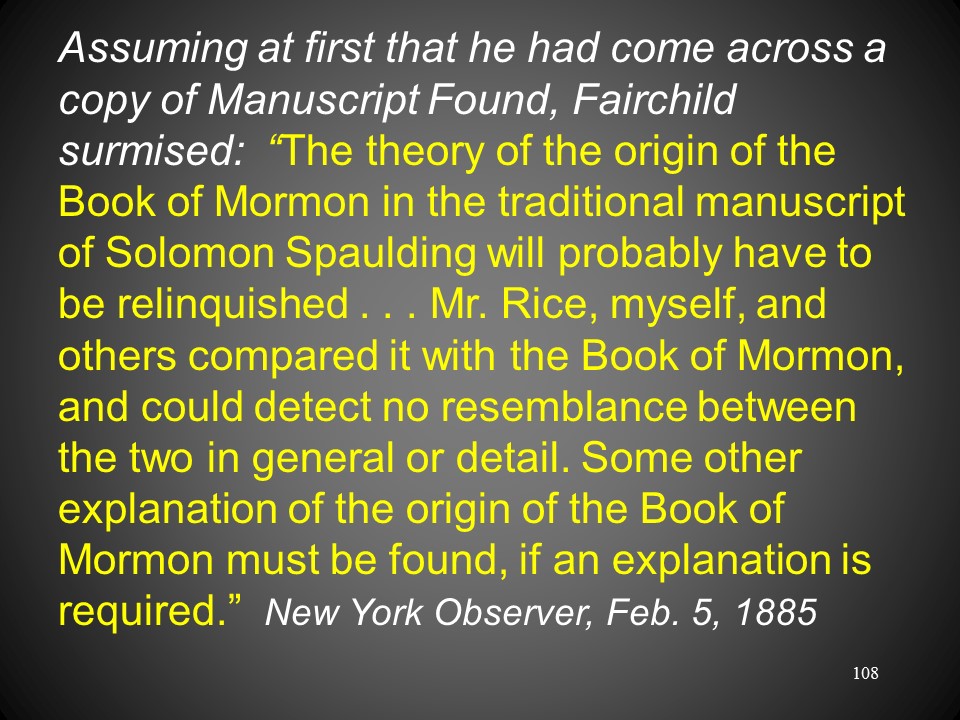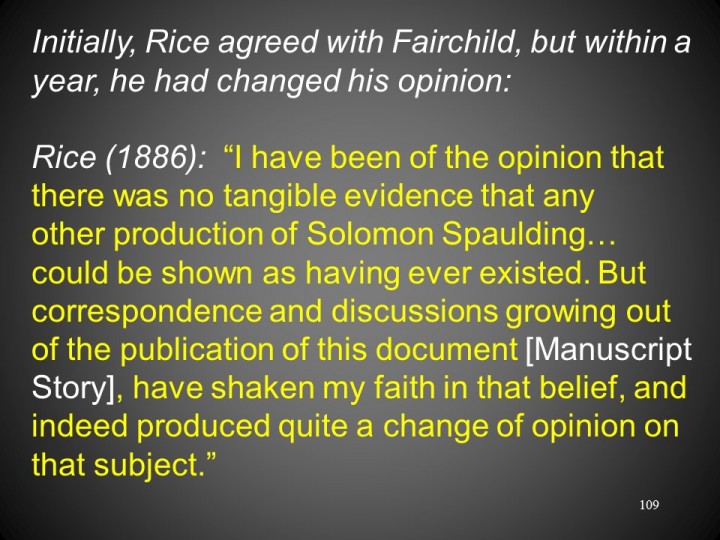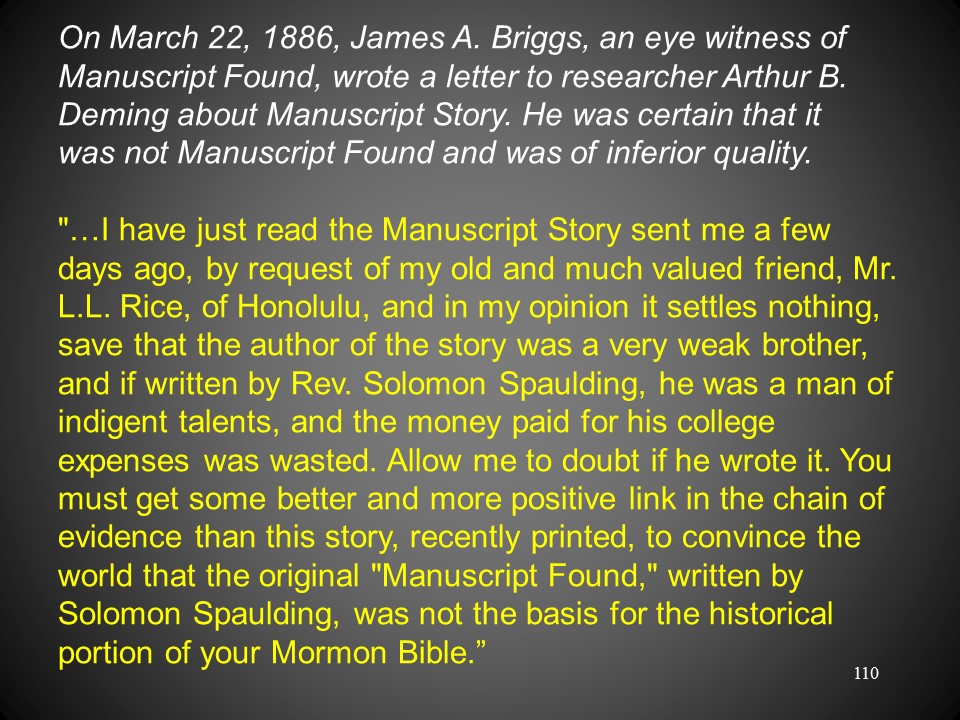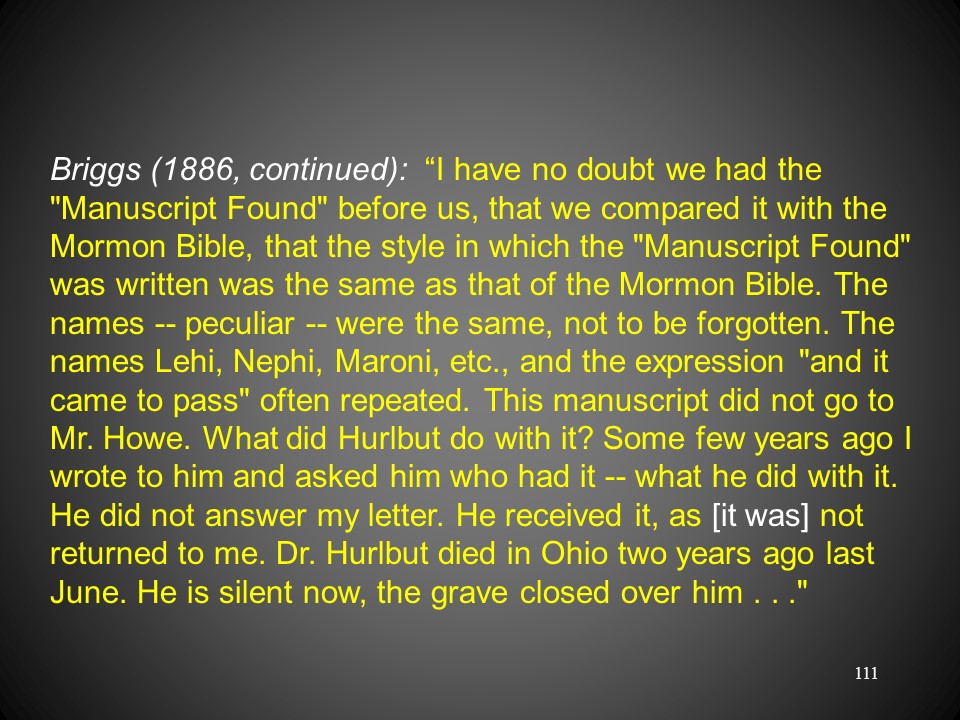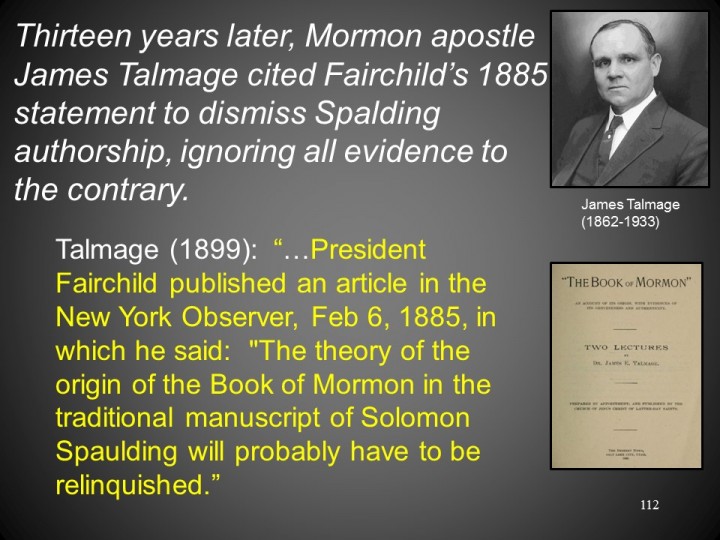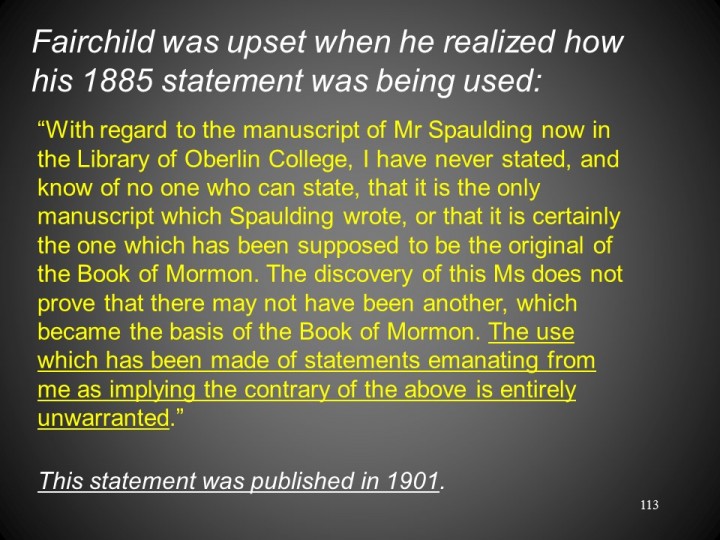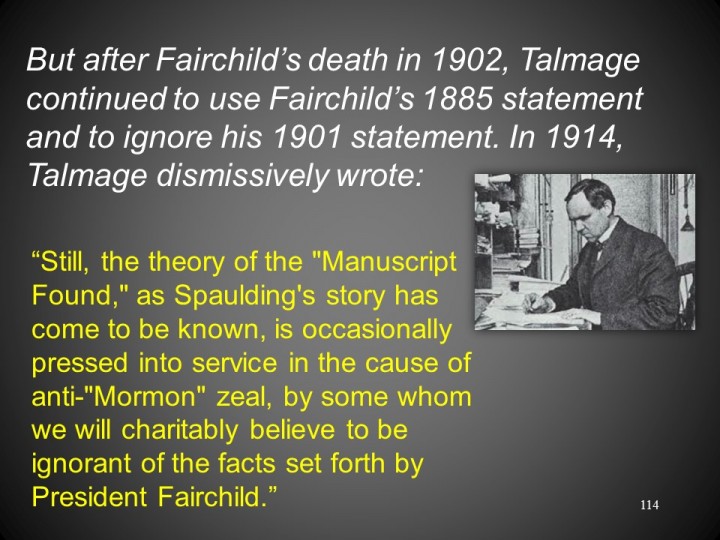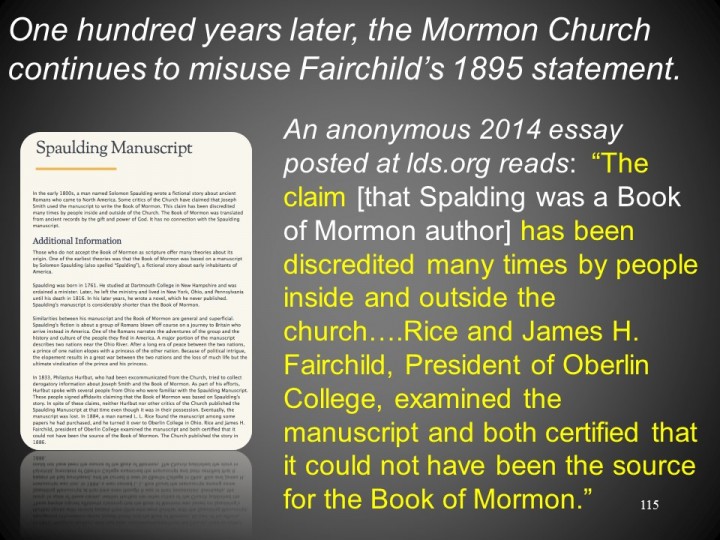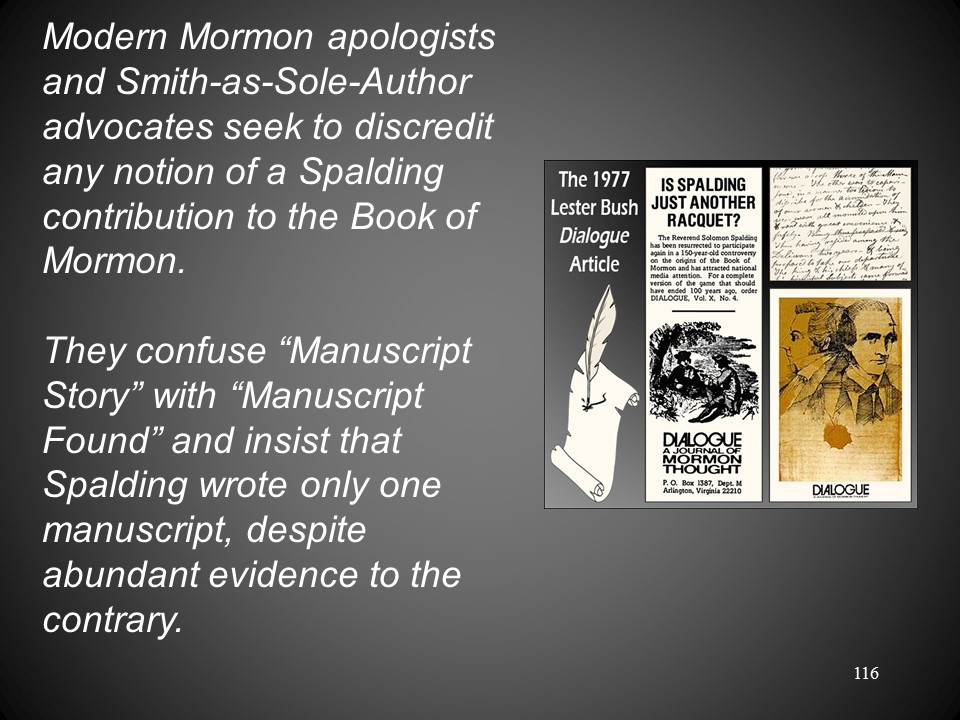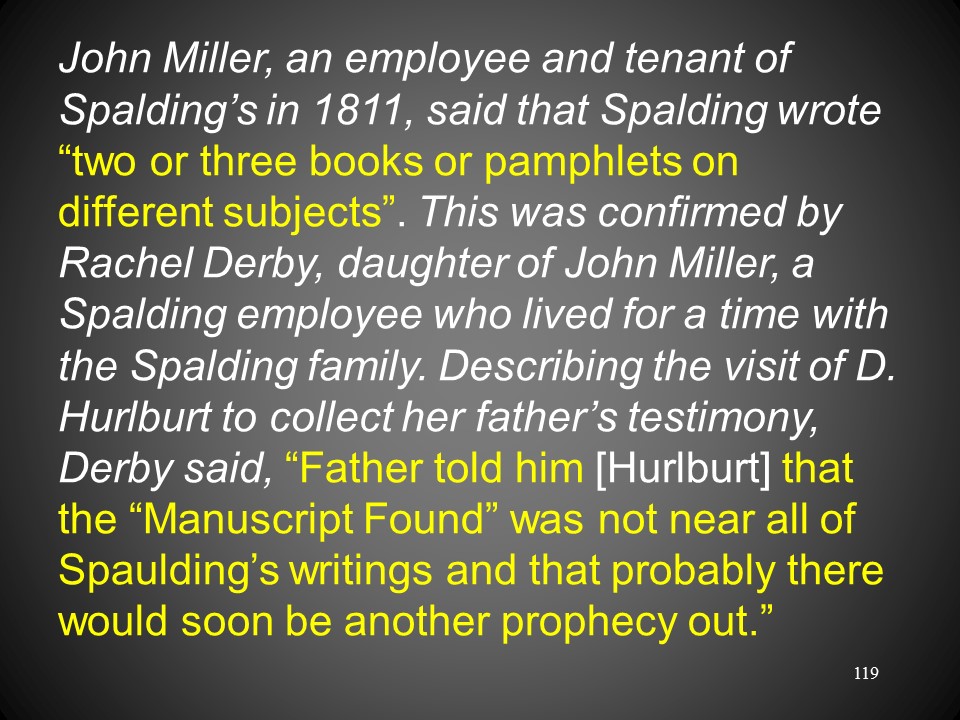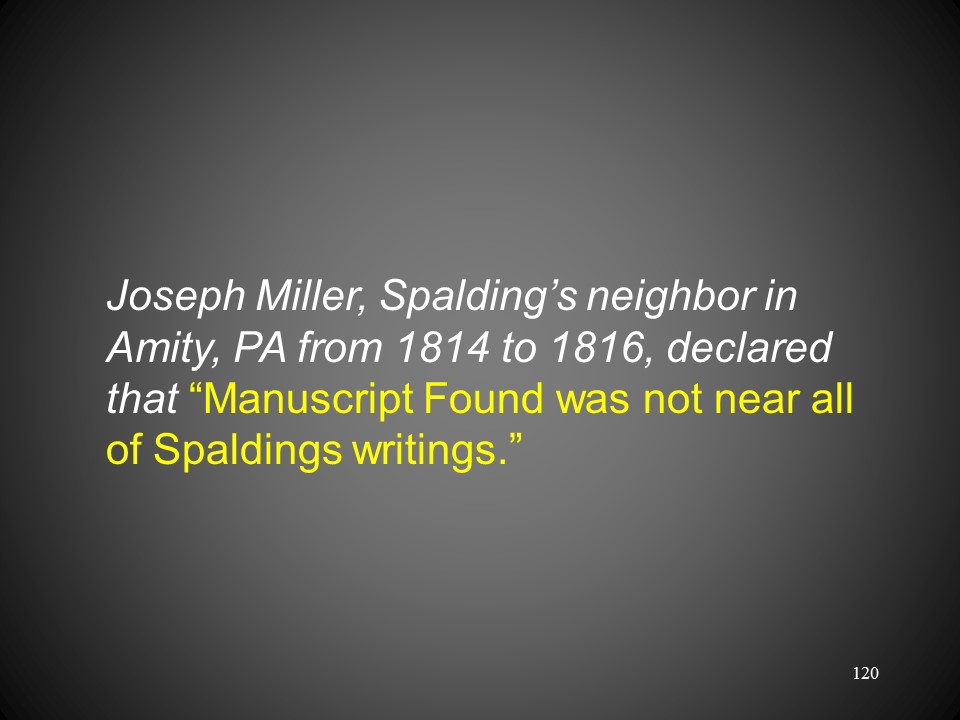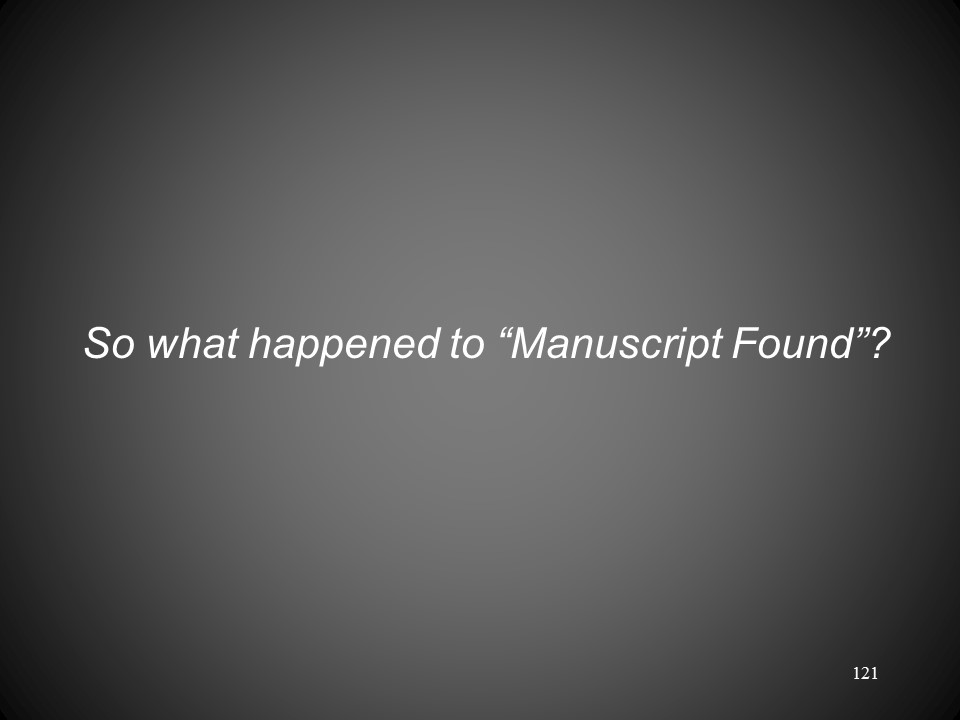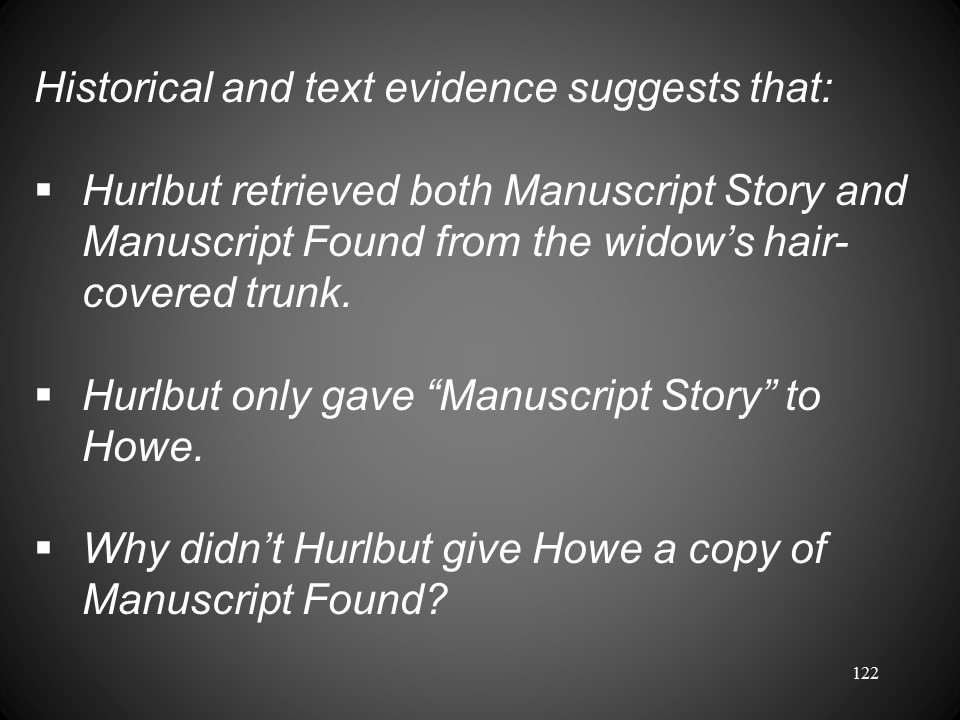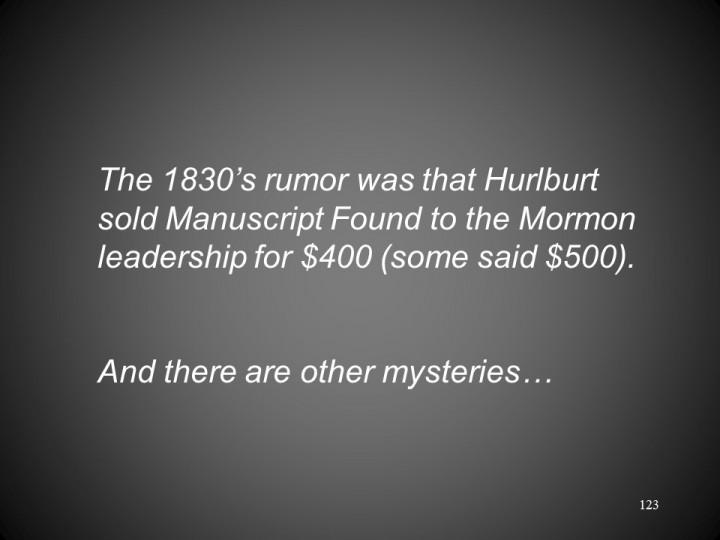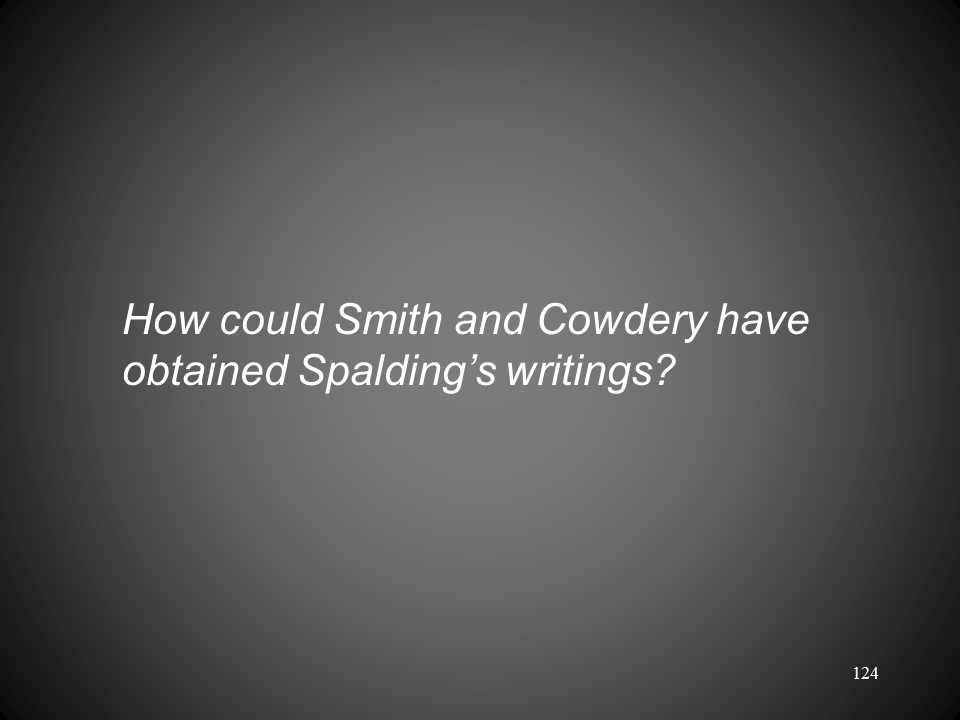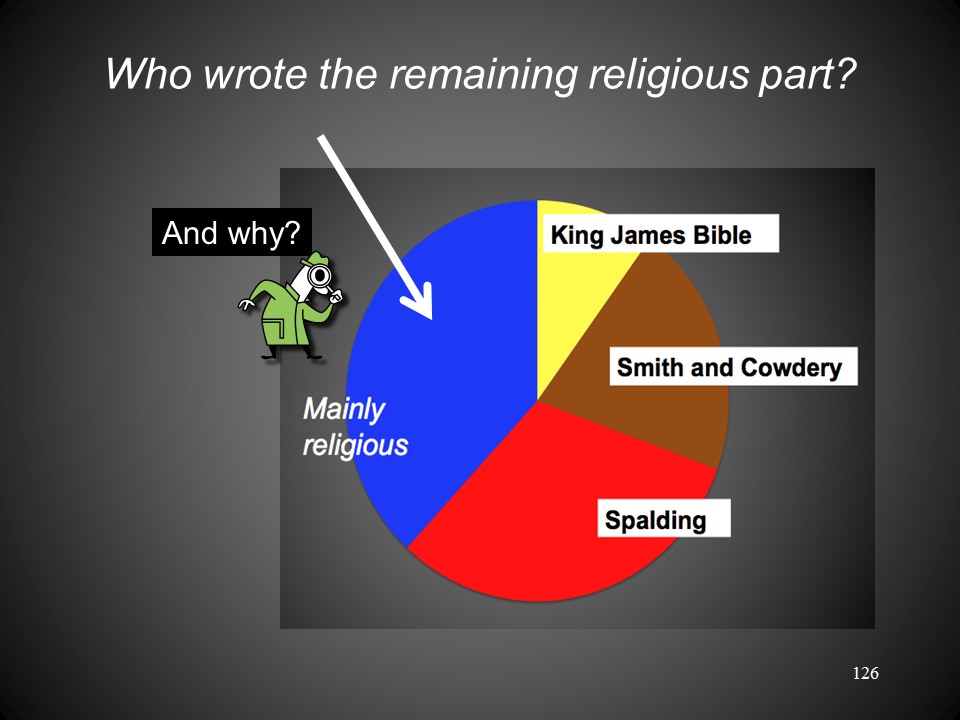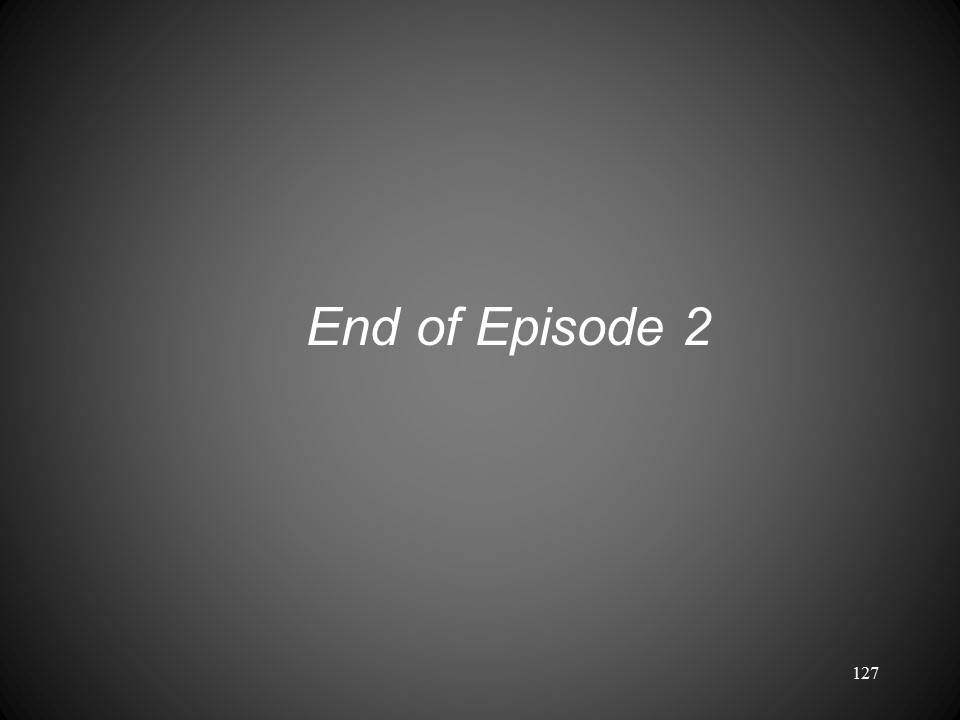Episode 02
Episode 02 – Slide 3
Expected interactions based on geography: (1) Rigdon, Spalding, Pratt and (2) Cowdery and Smith.
Authorship assignments in chronological sequence:
1. Joseph Smith — Joseph Smith, Jr. was published as the “author” of the 1830 Book of Mormon.
2. Joseph Smith, Jr. and Oliver Cowdery — The Cleveland Herald (Nov. 25, 1830) stated: “Mr. Cowdry and Mr. Smith the reputed author, have taken the old Bible to keep up a train of circumstances, and by altering names and language have produced the string of Jargon called the “Book of Mormon”… http://www.sidneyrigdon.com/dbroadhu/OH/miscohio.htm#112530. Painesville Telegraph Nov. 16, 1830: “About two weeks since some persons came along here with the book, one of whom pretends to have seen Angels, and assisted in translating the plates… The name of the person here, who pretends to have a divine mission, and to have seen and conversed with Angels, is Cowdray…” “ Mr. Cowdry and Mr. Smith the reputed author, have taken the old Bible to keep up a train of circumstances, and by altering names and language have produced the string of Jargon called the “Book of Mormon”…Cleveland Herald Nov. 25, 1830. http://www.sidneyrigdon.com/dbroadhu/OH/miscohio.htm#112530 In 1849, Orsamus Turner alleged that Oliver Cowdery was the main contributor: “the book itself is without doubt a production of the Smith family, aided by Oliver Cowdery, who was school teacher on Stafford street, an intimate of the Smith family, and identified with the whole matter”. Orsamus Turner was a neighbor of the Smith’s in Palmyra, and a childhood friend of Joseph Smith’s.
3. Joseph Smith, Jr. — On February 7, 1831, Alexander Campbell named Smith as likely author in the Millenial Harbinger: “Joseph Smith, Junior, Author and Proprieter… Smith, its real author, as ignorant and impudent a knave as ever wrote a book, betrays the cloven foot in basing his whole book upon a false fact…”. By January, 1835, after reading Mormonism Unvailed, Campbell had changed his mind in favor of the Spalding-Rigdon Theory as first proposed by Eber Howe in Mormonism Unvailed (1834).
4. Sidney Rigdon — The Cleveland Advertiser named Rigdon as likely author on February 15, 1831: “Rigdon was formerly a disciple of Campbell’s and who it is said was sent out to make proselytes, but is probable he thought he should find it more advantageous to operate on his own capital, and therefore wrote, as it is believed the Book of Mormon, and commenced his pilgrimage in the town of Kirtland, which was represented as one of the extreme points of the Holy Land” Anon. (1831). Mormonism – or Grand Pugilistic Debate. Cleveland Advertiser, February 15, 1831.
5. Solomon Spalding — In Feb 14 or 15, 1832, Mormon missionaries Orson Hyde and Samuel Smith read passages from the Book of Mormon at a schoolhouse in Conneaut (New Salem), Ohio. Nehemiah King, who was present at these readings, claimed that Hyde ‘had preached from the writings of Solomon Spalding’ (Wright, 1833). In December 1833, the Wayne Sentinel of Palmyra, New York, credited authorship of the Book of Mormon to “a respectable clergyman now dead”. Subsequent reports identified the clergyman as the late Reverend Solomon Spalding.
6. Solomon Spalding and Sidney Rigdon — Eber Howe published the Spalding allegations in Mormonism Unvailed (1834), including 8 statements from Conneaut witnesses collected in late 1833 by Ex-Mormon D. P. Hurlbut. In 1834, Howe linked Rigdon to the Patterson bookshop in Pittsburgh, where Spalding allegedly submitted his manuscript for publication in 1813, and where Rigdon contributed book bindings through his work as a tanner. By the end of the 19th century, at least 16 witnesses had made claims that a Spalding manuscript served as the narrative basis for the Book of Mormon, with many identical names and frequent usage of the phrase “came to pass”. In the Millenial Harbinger No. I, Vol. VI (January, 1835), Campbell said: “No man, not already duped, who has the half of five grains of common sense, can read this narrative of Mormonism without being converted to the belief that Joseph Smith and his colleagues in the plot are a band of the most unprincipled deceivers that ever disgraced any age or nation, and that his followers are a set of superlative fanatics”. In the Millenial Harbinger No. III (June 1839), Campbell said: “Since reading “Mormonism Unveiled” we had but little doubt that Sidney Rigdon is the leading conjuror in this diabolical affair; and that the widow of Solomon Spaulding, if found, could give some authentic and satisfactory information on the subject of the Book of Mormon — so far at least as the romance of Mr. Spaulding, the real basis of the fraud, was concerned. It would seem that she has been found in the wife of a second husband, Mrs. Davison, and that the whole affair is now at length fairly divulged. Much pains ought to be taken to send this document through the length and breadth of the land — as the emissaries of Smith, Rigdon, and Co., like the father of lies, are ever on the alert to beguile unstable souls, and continually lying in wait to deceive. The gullability of the present generation has not, in the memory of history, been often equaled — never surpassed. A people ignorant of one Bible are always an easy prey to the ministers of delusion and error”. http://www.sidneyrigdon.com/dbroadhu/OH/evan1832.htm
7. Parley P. Pratt — In 1842, the Rev. Samuel Williams named Pratt as Rigdon’s probable accomplice and connection to Smith (Mormonism Exposed, Pittsburgh, 1842 pp. 5-6). Samuel Williams (1802-1887) was Pastor of the First Baptist Church of Pittsburgh from 1827 to 1859. Rigdon was its pastor from 1822-23.
Episode 02 – Slide 4
Expected interactions based on geography: (1) Rigdon, Spalding, Pratt and (2) Cowdery and Smith.
Authorship attributions and allegations:
1. Joseph Smith — Joseph Smith, Jr. was published as the “author” of the 1830 Book of Mormon.
2. Joseph Smith, Jr. and Oliver Cowdery — The Cleveland Herald (Nov. 25, 1830) stated: “Mr. Cowdry and Mr. Smith the reputed author, have taken the old Bible to keep up a train of circumstances, and by altering names and language have produced the string of Jargon called the “Book of Mormon”… http://www.sidneyrigdon.com/dbroadhu/OH/miscohio.htm#112530. Painesville Telegraph Nov. 16, 1830: “About two weeks since some persons came along here with the book, one of whom pretends to have seen Angels, and assisted in translating the plates… The name of the person here, who pretends to have a divine mission, and to have seen and conversed with Angels, is Cowdray…” “Mr. Cowdry and Mr. Smith the reputed author, have taken the old Bible to keep up a train of circumstances, and by altering names and language have produced the string of Jargon called the “Book of Mormon”…Cleveland Herald Nov. 25, 1830. http://www.sidneyrigdon.com/dbroadhu/OH/miscohio.htm#112530 In 1849, Orsamus Turner alleged that Oliver Cowdery was the main contributor: “the book itself is without doubt a production of the Smith family, aided by Oliver Cowdery, who was school teacher on Stafford street, an intimate of the Smith family, and identified with the whole matter”. Orsamus Turner was a neighbor of the Smith’s in Palmyra, and a childhood friend of Joseph Smith’s.
3. Joseph Smith, Jr. — On February 7, 1831, Alexander Campbell named Smith as likely author in the Millenial Harbinger : “Joseph Smith, Junior, Author and Proprieter… Smith, its real author, as ignorant and impudent a knave as ever wrote a book, betrays the cloven foot in basing his whole book upon a false fact…”. By January 1835, after reading Mormonism Unvailed, Campbell had changed his mind in favor of the Spalding-Rigdon Theory as first proposed by Eber Howe in Mormonism Unvailed (1834).
4. Sidney Rigdon — The Cleveland Advertiser named Rigdon as likely author on February 15, 1831: “Rigdon was formerly a disciple of Campbell’s and who it is said was sent out to make proselytes, but is probable he thought he should find it more advantageous to operate on his own capital, and therefore wrote, as it is believed the Book of Mormon, and commenced his pilgrimage in the town of Kirtland, which was represented as one of the extreme points of the Holy Land” Anon. (1831). Mormonism – or Grand Pugilistic Debate. Cleveland Advertiser, February 15, 1831.
5. Solomon Spalding — In Feb 14 or 15, 1832, Mormon missionaries Orson Hyde and Samuel Smith read passages from the Book of Mormon at a schoolhouse in Conneaut (New Salem), Ohio. Nehemiah King, who was present at these readings, claimed that Hyde ‘had preached from the writings of Solomon Spalding’ (Wright, 1833). In December 1833, the Wayne Sentinel of Palmyra, New York, credited authorship of the Book of Mormon to “a respectable clergyman now dead”. Subsequent reports identified the clergyman as the late Reverend Solomon Spalding.
6. Solomon Spalding and Sidney Rigdon — Eber Howe published the Spalding allegations in Mormonism Unvailed (1834), including 8 statements from Conneaut witnesses collected in late 1833 by Ex-Mormon, D. P. Hurlbut. In 1834, Howe linked Rigdon to the Patterson bookshop in Pittsburgh, where Spalding allegedly submitted his manuscript for publication in 1813, and where Rigdon contributed book bindings through his work as a tanner. By the end of the 19th century, at least 16 witnesses had made claims that a Spalding manuscript served as the narrative basis for the Book of Mormon, with many identical names and frequent usage of the phrase “came to pass”. In the Millenial Harbinger No. I, Vol. VI (January 1835), Campbell said: “No man, not already duped, who has the half of five grains of common sense, can read this narrative of Mormonism without being converted to the belief that Joseph Smith and his colleagues in the plot are a band of the most unprincipled deceivers that ever disgraced any age or nation, and that his followers are a set of superlative fanatics”. In the Millenial Harbinger No. III (June 1839), Campbell said: “Since reading “Mormonism Unveiled” we had but little doubt that Sidney Rigdon is the leading conjuror in this diabolical affair; and that the widow of Solomon Spaulding, if found, could give some authentic and satisfactory information on the subject of the Book of Mormon — so far at least as the romance of Mr. Spaulding, the real basis of the fraud, was concerned. It would seem that she has been found in the wife of a second husband, Mrs. Davison, and that the whole affair is now at length fairly divulged. Much pains ought to be taken to send this document through the length and breadth of the land — as the emissaries of Smith, Rigdon, and Co., like the father of lies, are ever on the alert to beguile unstable souls, and continually lying in wait to deceive. The gullability of the present generation has not, in the memory of history, been often equaled — never surpassed. A people ignorant of one Bible are always an easy prey to the ministers of delusion and error”. http://www.sidneyrigdon.com/dbroadhu/OH/evan1832.htm
7. Parley P. Pratt — In 1842, the Rev. Samuel Williams named Pratt as Rigdon’s probable accomplice and connection to Smith (Mormonism Exposed, Pittsburgh, 1842 pp. 5-6). Samuel Williams (1802-1887) was Pastor of the First Baptist Church of Pittsburgh from 1827 to 1859. Rigdon was its pastor from 1822-23.
Episode 02 – Slide 7
Episode 02 – Slide 9
Matilda Spalding Davison’s Letter to the Boston Daily Advertiser. ORIGIN OF THE “BOOK OF MORMON”, OR “GOLDEN BIBLE”. April 1, 1839.
Other witness statements:
• • • • • •
Artemus Cunningham (1833):
“Before showing me his [Spalding’s] manuscripts, he went into a verbal relation of its outlines, saying that it was a fabulous or romantic history of the first settlement of this country, and as it purported to have been a record found buried in the earth, or in a cave, he had adopted the ancient or scripture style of writing. He then presented his manuscripts , when we sat down and spent a good share of the night, in reading them, and conversing upon them.”
• • • • • •
Excerpts from John Spalding (Solomon’s brother, 1833):
“…The book was entitled the “Manuscript Found”
“…historical romance of the first settlers of America”
“…American Indians are the descendants of the Jews, or the lost tribes”
“…account of their journey from Jerusalem”
“…under the command of Nephi and Lehi”
“…Nephites and the other Lamanites. Cruel and bloody wars ensued, in which great multitudes were slain.”
“….mounds”
“…nearly the same historical matter, names, &c.”
“…he wrote in the old style, and commenced about every sentence with “and it came to pass,” or “now it came to pass,” the same as in the Book of Mormon”
• • • • • •
Excerpts from Oliver Smith – landlord (Aug 1833):
“…historical novel, founded upon the first settlers of this country”
“…journey from Jerusalem, by land and sea, till their arrival in America”
“…mounds”
“… Nephi and Lehi were… leading characters, when they first started for America”
“… no religious matter was introduced”
“….when it is printed, it will bring me a fine sum of money”
“…When I heard the historical part … I at once said it was the writings of old Solomon Spalding”
• • • • • •
Aaron Wright – neighbor (August 1833):
“….the lost tribes of Israel…were the first settlers of America”
“…the Indians were their descendants”
“….journey from Jerusalem to America, as it is given in the Book of Mormon, excepting the religious matter”
“…the names more especially are the same without any alteration
“…Spalding had many other manuscripts, which I expect to see when Smith translates his other plates”
• • • • • •
Abner Jackson (son of a friend, 1880):
In response to a solicitation from lawyer John Aiken, Jackson gave a lengthy statement in December of 1880 which was published in The Daily Evening Reporter (Washington, PA) on Jan 7, 1881. Jackson was the son of a friend of Spalding’s. Here is an excerpt:
“Spaulding read much of his manuscript to my father, and in conversation with him, explained his views of the old fortifications in this country, and told his romance. A note in Morse’s Geography suggested it as a possibility that our Indians were descendents of the lost tribes of Israel…. the old fortifications and earth mounds…convinced him that they were a…more enlightened and civilized than are found among the Indians among us at this day. These facts and reflections prompted him to write his Romance, purporting to be a history of the lost tribes of Israel. He begins with their departure from Palestine, or Judea, then up through Asia, points out their exposures, hardships and sufferings, also their disputes and quarrels, especially when they built their craft for passing over the straits. Then after their landing, he gave an account of their divisions and subdivisions under different leaders, but two parties controlled the balance.”
• • • • • •
Witnesses mentioning the Behring Straits:
Abner Jackson, 1855, 1880 – “over the Straits”
Daniel Tyler, 1878 – “across Behring Straits”
Matilda McKinstry, 1886 – “across Behring Straits”
Redick McKee, 1869, 1886 – “China, across Behring Straits”
These late-period statements do not indicate an attempt to describe the contents of the Book of Mormon, as it does not contain any mention of the Behring Straits.
• • • • • •
Other likely elements in Manuscript Found:
Spalding likely introduced racial themes into Manuscript Found. In Spalding’s day the extinct mound-builders were generally thought of as having originally been light-skinned people from the Old World. Spalding indulged in this same racism in his Manuscript Story when he provided his fictional “Ohians” with a light “olive” skin, and his fictional family of Lobaska with lighter skins. Presumably he also gave his Romans, the culturally superior group in the story, the whitest skins of all.
Episode 02 – Slide 11
‘On February 12th, 1832 Elders Samuel H. Smith and Orson Hyde approached the outskirts of what Hyde, in his missionary journal, calls “Salem Village”. Although Mormon missionaries had no doubt passed through this part of northern Ashtabula Co. prior to Smith and Hyde’s visit, they were the first Mormons who are known to have lingered in the area long enough to preach and search out potential converts. According to Elder Hyde’s journal, the two missionaries “Tarried all night with a Mr. Sawtril” and at his house were “kindly entertained”. Quite likely this was the home of Mr. Daniel Sawtelle, an old Ashtabula pioneer who had lived in New Salem back in the days when Solomon Spalding was a resident there.
On the next day Smith and Hyde “Visited two or three families in the vicinity of Salem” preaching Mormonism and attempting to locate possible candidates for baptism. They generated enough interest in the village that they were able to hold a meeting that evening and announce the Mormon gospel to “a large and attentive congregation”. Hyde also stayed that the preaching elders “sold two Books of Mormon” that day. Then they “Tarried all night with Col. Fifield”, probably Edward Fifield — another old pioneer from Spalding’s time.
Samuel H. Smith also kept a missionary journal and his account says that the two elders “went into the village again”, where they “held a meeting in the school house”. This latter “meeting” appears to have been conducted in the evening on February 14th. The only “village” of any size in the immediate vicinity was Salem itself. Here is where Aaron Wright said (in 1833) that Orson Hyde “preached” in “the school house” and was heard by Nehemiah King, another local resident who had known Solomon Spalding. Orson Hyde said himself (in 1841): “In the spring of 1832 I preached in New Salem, Ohio the place where Rev. Mr. Spaulding resided at the time he wrote his romance”.
If it was on the 14th that Nehemiah King attended the missionaries’ preaching service — and was there reminded of Solomon Spalding’s tales, when he heard the Book of Mormon read — then Orson Hyde’s sales of the book on the previous day were probably made to genuinely interested persons and not to residents merely curious to see if the Book of Mormon read like Spalding’s old fiction. Henry Lake (yet another of Spalding’s old friends in the village) did not have a copy of the book and was forced to borrow one in order to peruse its contents. He said (in 1833): “Some months ago I borrowed the Golden Bible… About a week after, my wife…commenced reading it aloud… I was astonished to find the same passages in it that Spalding had read to me, more than twenty years before, from his ‘Manuscript Found’. Since that, I have more fully examined the said Golden Bible”. Probably Mr. Lake “borrowed” one of the two copies of the book Orson Hyde sold in the village on Feb. 13, 1832. A question that might be asked here is, why did Lake obtain the Book of Mormon and from whom did he get the copy he read “some months” before the summer of 1833? Although it is by no means provable at this late date, it is possible that Henry Lake was loaned that particular book by the Hon. Aaron Wright. At the very least, it can be said that Aaron Wright owned an 1830 edition of the Book of Mormon and that he may have purchased it from Orson Hyde (or from Hyde’s original buyer) early in 1832.’
Episode 02 – Slide 19
Eber Howe in Mormonism Unvailed (1834):
Aaron Wright (1833): “the names more especially are the same without any alteration”
John Miller (1833): “The names of Nephi, Lehi, Moroni, and in fact all the principal names, are bro’t fresh to my recollection, by the Gold Bible.”
John Spalding (1833): “I have recently read the Book of Mormon, and to my great surprise I find nearly the same historical matter, names, &c. as they were in my brother’s writings.”
Episode 02 – Slide 20
Henry Lake (1833): “the so frequent use of the words ‘And it came to pass,’ ‘Now it came to pass,’ rendered it ridiculous.”
Martha Spalding (1833): “The old, obsolete style, and the phrases of ‘and it came to pass,’ &c. are the same.”
John Spalding (1833): “I well remember that he wrote in the old style, and commenced about every sentence with ‘and it came to pass,’ or ‘now it came to pass,’ the same as in the Book of Mormon.”
Howe, E., 1834, Mormonism Unvailed.
Episode 02 – Slide 21
Members of the LDS Church continue today to use pronouns from Early Modern English in their prayers in reference to Diety (“thee, “thy”, “thine”, “thou art”, etc.)
Erin Shalev (2010):
“The language of the King James Bible was as strange and foreign to late eighteenth-century and nineteenth-century Anglophones as it is to twenty first-century English-speakers. The staccato rhythms confined in short and numbered verses, the repetitive use of phrases such as “and it came to pass,” and the use of verbs with suffixes such as “-eth,” had been long gone from the spoken language by the second half of the eighteenth century… American authors and commentators used this ontologically privileged language as a means to establish their claims for truth, as well as their authority and legitimacy in public discourse.” “Written in the Style of Antiquity”: Pseudo-Biblicism and the Early American Republic, 1770-1830.
Dec 1, 2010.
Episode 02 – Slide 23
Bubble area is proportional to the number of times that the word is used in the Book of Mormon.
A stylistic goal of the Book of Mormon was to imitate the sound of the Old Testament. John H. Gilbert, the man who helped to print the Book of Mormon, claimed that those who brought him the manuscript did not want him to correct the grammatical errors because they wanted it to be like the Old Testament:
“When the printer was ready to commence work, Harris was notified, and Hyrum Smith brought the first installment of manuscript…On the second day – Harris and Smith being in the office – I called their attention to a grammatical error, and asked whether I should correct it? Harris consulted with Smith a short time, and turned to me and said: ‘The Old Testament is ungrammatical, set it as it is written.’…”Cowdery held and looked over the manuscript when most of the proofs were read. Martin Harris once or twice, and Hyrum Smith once, Grandin supposing these men could read their own writing as well, if not better, than any one else; and if there are any discrepancies between the Palmyra edition and the manuscript these men should be held responsible.” (Memorandum, made by John H. Gilbert, Esq., September 8, 1892, Palmyra, N.Y., printed in Joseph Smith Begins His Work, Vol. 1, Introduction).
BYU Professor Royal Skousen has noted:
“The original vocabulary of the Book of Mormon appears to derive from the 1500s and 1600s, not from the 1800s. This last finding is quite remarkable. Lexical evidence suggests that the original text contained a number of expressions and words with meanings that were lost from the English language by 1700.
On the other hand, I have not been able thus far to find word meanings and expressions in the text that are known to have entered the English language after the early 1700s.
In the following sampling, I list some of the clearest examples in the Book of Mormon of this archaic vocabulary from the 1500s and 1600s. (In this discussion, I exclude, of course, archaic words such as besom ‘broom’ that are found in direct quotations from the King James Bible.) For each word and its meaning, I provide citations from the original text of the Book of Mormon, corresponding citations from the Oxford English Dictionary (OED), and a range of dates for citations in the OED with that same meaning (except for citations from the King James Bible, original spellings are provided). In some instances, the word can be found with that meaning in the 1611 King James Bible. But some of these words predate 1611 by a few decades at least. The difficulty of these archaic words has sometimes resulted in accidental changes during the early transmission of the Book of Mormon text. At other times, editors and typesetters have replaced such words with more recognizable alternatives.
Some examples found in the King James Bible:
To require, meaning ‘to request’.
Enos 1:18 reads: “and the Lord said unto me: thy fathers have also required of me this thing.” It may seem unusual that Enos’s ancestral fathers (Lehi, Nephi, and Jacob) required the Lord to preserve their records. Notice that the word also in verse 18 implies that Enos too is “requiring” the Lord to preserve these records, yet previously (in verses 15—17) Enos simply asks the Lord to do so. But the passage makes perfectly good sense when we observe that earlier in English the verb require had the meaning ‘to ask, request, or desire someone to do something’ (see definition 3 for this verb in the OED). The OED provides citations of require with the meaning of ‘to request’ dating from 1375 to 1665, including this example from William Shakespeare’s Henry VIII (1613): “In humblest manner I require your Highnes, That it shall please you.” We have a similar example in the King James Bible: “For I was ashamed to require of the king a band of soldiers and horsemen to help us against the enemy in the way” (Ezra 8:22).
To cast arrows, meaning ‘to shoot arrows’. Alma 49:4 reads: “the Lamanites could not cast their stones and their arrows at them”. Similarly, verse 19 reads “and thus were the Nephites prepared to destroy all such as should attempt to climb up to enter the fort by any other way by casting over stones and arrows at them”. For us today, it seems strange to cast arrows. Yet the OED gives the following comment for definition 2 under the verb cast: “Formerly said also of military engines, bows, and the like, which throw or shoot projectiles”. OED citations date from about 1300 to 1609, including the following biblical one in John Wycliffe’s 1382 translation of 2 Kings 13:17: “Helise seyde, kast an arowe; and he kest”. The King James Bible uses the verb shoot in translating this same passage: “Then Elisha said, Shoot. And he shot”. But there is one place in the King James Bible where the verb cast does occur with arrows: “As a mad man who casteth firebrands, arrows, and death” (Proverbs 26:18).For examples like these, one could claim that Joseph Smith picked up such vocabulary usage from intensive Bible reading.
But there are words and expressions in the original Book of Mormon text that never appear, at least with their archaic meanings, in the King James Bible yet were common in Early Modern English.
Some Examples Not Found in the King James:
To counsel, meaning ‘to counsel with’.
In the original text of the Book of Mormon we have two cases where the verb counsel is used without the expected preposition with: “counsel the Lord in all thy doings” (Alma 37:37) all thy doings” (Alma 37:37) and “take it upon you to counsel your elder brothers in your undertakings” (Alma 39:10). In the first case, Alma is speaking to Helaman; in the second, to Corianton, the wayward missionary son. In no way is Alma advocating that Helaman counsel the Lord or that Corianton counsel his two righteous brothers. The editors for the 1920 LDS edition recognized that the preposition with was necessary in those two passages so that readers would not misinterpret the language; thus in both cases counsel was emended to counsel with. One could assume that somehow the preposition with was accidentally lost during the early transmission of these two passages. Yet the OED, under definition 4, lists the now obsolete meaning ‘to ask counsel of; to consult’ for the verb counsel. Citations date from 1382 to 1547, the last one coming from John Hooper: “Moses . . . counselled the Lord and thereupon advised his subjects what was to be done”. Clearly, Moses is counseling with the Lord, not giving counsel to the Lord.
“But if”, meaning “unless” in the original text, Mosiah 3:19 reads “for the natural man is an enemy to God and has been from the fall of Adam and will be forever and ever but if he yieldeth to the enticings of the Holy Spirit.”
This strange use of ‘but if” was replaced in the 1920 LDS edition with “unless” since the latter seems to be the appropriate meaning. And indeed it is: the OED gives the following definition for the now obsolete “but if” (under definition 10b for the conjunction “but”): ‘if not, unless, except.’ Citations of this usage in the OED date from about 1200 to 1596, including this one from Philip Sidney’s Arcadia (1580): “He did not like that maides should once stir out of their fathers houses, but if it were to milke a cow”. The OED also states that this meaning of “but if” was “very common” from the 1300s through the 1500s.
To depart, meaning ‘to part, divide, separate’. In the printer’s manuscript for Helaman 8:11, the text reads “God gave power unto one man even Moses to smite upon the waters of the Red Sea and they departed hither and thither.” The 1830 typesetter thought departed must be an error, so he replaced it with the expected parted. Yet the OED explains that the verb depart once had the now obsolete meaning of ‘to put asunder, sunder, separate, part’ (see definitions 3a—3d), with citations from 1297 through 1677. Many of the citations in the OED for this meaning are religious ones. For instance, John Wycliffe’s 1388 translation of Isaiah 59:2 reads “youre wickednesses han departid bitwixe you and youre God” (which the King James Bible translates as “But your iniquities have separated between you and your God”). There is John Maundeville’s reference (about 1400) to Moses’s rod: “þe ʒerde of Moyses, with þe whilk he departid þe Reed See,” meaning ‘the rod [yard] of Moses with which he parted the Red Sea.’ When the King James Bible refers to Moses using his rod to part the Red Sea, the verb is divide: “But lift thou up thy rod and stretch out thine hand over the sea and divide it” (Exodus 14:16). William Tyndale, in his 1526 translation of Romans 8:39, uses depart: “To departe us from Goddes love.” The King James Bible, on the other hand, uses the verb separate: “to separate us from the love of God.” The 1557 Geneva Bible translates John 19:24 as “They departed my rayment among them.” But the King James Bible once more circumvents this use of depart, in this instance by selecting the verb part: “They parted my raiment among them.” Finally, there is this example from the 1548—49 Book of Common Prayer: “Till death vs departe”. In 1662 this reading was changed to “Till death us do part” because by then the meaning of ‘to part’ for depart was obsolete. Note, however, that the change in the very familiar phraseology was minimal: the de- was replaced with the helping verb do, thus maintaining the cadence and sound of the original language.
Extinct, referring to an individual’s deathAlma 44:7 reads “and I will command my men that they shall fall upon you and inflict the wounds of death in your bodies that ye may become extinct.” Such usage seems very odd today since, as the OED explains under definition 4 for this past participial adjective, we now use extinct to refer to a family, race, or species as having died out or come to an end. But in Early Modern English, extinct could refer to a person’s death. The OED, under definition 3, lists citations from 1483 through 1675, the last one from an English translation of Machiavelli’s The Prince: “The Pope being dead and Valentine extinct”.
We should note that the text does not consistently use the archaic meaning for every instance of these words. For example, the verb require has its expected meaning in Alma 34:12: “but the law requireth the life of him who hath murdered.” One can shoot as well as cast arrows: “and they cast stones at him upon the wall and also many shot arrows at him” (Helaman 16:2). There is also one case of “to counsel with someone” in the earliest text, in Mosiah 17:6: “having counseled with his priests”; and there are two instances that refer to counseling the Lord: “seek not to counsel the Lord” (Jacob 4:10) and “counsel me not” (Jacob 5:22). The conjunctive but if occurs only once in the text with the meaning ‘unless.’ In seven other places, the text uses unless, as in Mosiah 17:8: “for this cause thou shalt be put to death unless thou wilt recall all the words which thou hast spoken evil concerning me and my people.” Similarly, depart otherwise means ‘to leave’ in the Book of Mormon rather than ‘to part.’ There are two other references to Moses’s parting of the Red Sea (1 Nephi 4:2 and 1 Nephi 17:26), and they have the verb divide, just as the King James Bible does. Four instances of extinct refer to the death of individuals in a single military engagement (Alma 45:14, Helaman 11:10, and 3 Nephi 3:8 as well as Alma 44:7), but there is one that refers to the permanent extinction of an entire race of people: “even until the people of Nephi shall become extinct” (Alma 45:11). Yet even with all these examples where the words take on their more familiar uses, we find that those meanings are also found in Early Modern English. In any event, examples of variant meaning are not unexpected in a text of this size since language itself is inherently variant. We cannot expect the text to have no variation at all. The critical text will accept these earliest readings as the original text, despite their archaic meanings and their inconsistent usage.
One could argue that all these examples are actually errors that entered the Book of Mormon text in the early transmission of the text: for example, require looks like request, the preposition with after counsel could have been accidentally omitted, and part could have been miswritten as depart. But the other examples seem fully intended: arrows are cast along with stones, the highly unusual but if cannot be an error for unless, and the word extinct refers to the death of individuals in four out of five cases in the Book of Mormon. Another argument against this analysis would be that all these archaic meanings might have still existed in Joseph Smith’s upstate New York dialect. Thus far there is no evidence to support such a hypothesis. Lexical studies consistently show that the archaic meanings for these words did indeed become obsolete in England prior to 1700. Nor have any vestiges of their use in the American colonies been found as of yet.
Conjectural Emendations If the original vocabulary of the Book of Mormon text dates from Early Modern English, one might wonder if there are any archaic words or expressions that were unrecognizable to Joseph Smith and his scribes, thus leading them to misinterpret and change the language during the early transmission of the text. Two possibilities have arisen thus far. The first one deals with the word ceremony in Mosiah 19:24: “and it came to pass that after they had ended the ceremony that they returned to the land of Nephi”. The problem with this passage is that the word ceremony seems out of place. The larger context implies that their discourse was simply over:and it came to pass that they were about to return to the land of Nephi and they met the men of Gideon and the men of Gideon told them of all that had happened to their wives and their children and that the Lamanites had granted unto them that they might possess the land by paying a tribute to the Lamanites of one half of all they possessed and the people told the men of Gideon that they had slain the king and his priests had fled from them farther into the wilderness and it came to pass that after they had ended the ceremony that they returned to the land of Nephi rejoicing because their wives and their children were not slain and they told Gideon what they had done to the king (Mosiah 19:22—24) The OED lists no meaning for ceremony that would work reasonably well for this passage except to assume that the conversation itself is a ceremony or that it involved some kind of ceremonial aspect in recounting the execution of King Noah.I have had a number of my students and research assistants try to find another word that might work better in Mosiah 19:22—24, one that would perhaps sound or look like ceremony. The idea behind this approach is that such a word might have been miscopied or misheard as ceremony. The only plausible suggestion proposed thus far comes from Renee Bangerter in her 1998 BYU master’s thesis (“Since Joseph Smith’s Time: Lexical Semantic Shifts in the Book of Mormon,” pp. 16—18), where she proposes that the original word in Mosiah 19:24 might have been sermon. Although the current meanings for this word will not work in this passage, Bangerter notes that the OED gives the earliest meaning for sermon as ‘something that is said; talk, discourse,’ which would exactly fit the context described in Mosiah 19:22—24. This meaning is, however, obsolete; the last citation in the OED with this meaning dates from 1594: “Desiring Don Infeligo with very mild sermon to be friends with Medesimo again.” The last citation found on Literature Online
In part 3 of volume 4 of the critical text, Analysis of Textual Variants of the Book of Mormon (this part will be published in the summer of 2006), I discuss under Mosiah 19:24 how sermon could have accidentally been replaced by ceremony. Basically, I propose the following: the scribe for the original manuscript (which is unfortunately not extant here) spelled sermon as ‘cermon’, which was then misread as ‘ceremony’ (and spelled as cerimony) when Oliver Cowdery copied the word from the original manuscript into the printer’s manuscript. Such a conjectural emendation is possible once we recognize that the vocabulary for the original Book of Mormon text dates from the 1500s and 1600s. A second possible misinterpretation deals with the expression “the pleasing bar of God,” as found in Jacob 6:13 (and similarly in Moroni 10:34 as “the pleasing bar of the great Jehovah”). In part 2 of volume 4 of the critical text (this part was published in August of this year), under Jacob 6:13, I argue that the pleasing bar is actually a mistake for the pleading bar. An abbreviated description of the evidence for emending the text to the pleading bar was initially presented in 2004 and can be found in a previous issue of the FARMS publication Insights (vol. 24, no. 4, pp. 2—3). This conjectural emendation was first proposed by Christian Gellinek in 2003. There are no uses of the term pleasing bar anywhere on the Internet except in reference to the Book of Mormon, yet there is clear evidence that the legal term pleading bar was used in the 1600s. And as might be expected, no instances of pleading bar have thus far been found during the 1800s, in either England or the United States. But such a conjectural emendation is consistent with the hypothesis that the vocabulary of the Book of Mormon dates from Early Modern English. These new findings argue that Joseph Smith was not the author of the English-language translation of the Book of Mormon. Not only was the text revealed to him word for word, but the words themselves sometimes had meanings that he and his scribes would not have known, which occasionally led to misinterpretation. The Book of Mormon is not a 19th-century text, nor is it Joseph Smith’s. The English-language text was revealed through him, but it was not precisely in his language or ours.”
Episode 02 – Slide 24
Erin Shalev (2010): “Written in the Style of Antiquity”: Pseudo-Biblicism and the Early American Republic, 1770-1830. Church History 79:4 (December 2010), 800–826. doi:10.1017/S0009640710001034. Source. (Thanks to Dale Broadhurst.)
“The year 1744 witnessed the publication of the “most successful of English works” in America and represents a turning point in the history of American biblical-style writing. Chronicle of the Kings of England, Written in the Manner of the Ancient Jewish Historians, which would eventually be published in America in at least seven editions during the following half century, represented a major step forward in the elaboration and sophistication of what was to become a vital tradition in American letters and consciousness. Said to be written by Nathan Ben Saddi “a priest of the Jews,” and attributed to Robert Dodsley, the 1744 edition of The Chronicle of the Kings dressed British history in the recognizable biblical style, from the reign of William the Conqueror until Queen Elizabeth.” The Chronicle opened in a known biblical format: “Now it came to pass in the Year One thousand sixty and six, in the Month of September, on the eighth Day of the Month, that William of Normandy, surnamed the Bastard, landed in England, and pitched his Tent in a Field near the Town of Hastings.” The language, style, and grammar were biblical, the tone ironic, and the text abundant with anachronisms. The traits of a genre were established….”
Episode 02 – Slide 25
Independent Source Separation Score:
http://askreality.com/hidden-in-plain-sight/#ISS
http://i.imgur.com/1TUxAZX.png
Episode 02 – Slide 26
Eber Howe in Mormonism Unvailed (1834):
Henry Lake (1833): “the so frequent use of the words “And it came to pass,” “Now it came to pass” rendered it ridiculous.”
Martha Spalding (1833): “The old, obsolete style, and the phrases of “and it came to pass,” &c. are the same.”
John Spalding (1833): “I have recently read the Book of Mormon, and to my great surprise I find nearly the same historical matter, names, &c. as they were in my brother’s writings. I well remember that he wrote in the old style, and commenced about every sentence with “and it came to pass,” or “now it came to pass,” the same as in the Book of Mormon”
In 1880 Abner Jackson said that when the Book of Mormon “was brought to Conneaut and read there in public, old Esq. Wright heard it, and exclaimed, ‘Old Come to Pass has come to life again’” (Davis, Scales, and Cowdrey 1977, 64). In 1882 Joseph Miller wrote: “The words ‘Moreover,’ ‘And it came to pass,’ occurred so often that the boys about the village called him ‘Old Came to Pass’ ” (Davis, Scales, and Cowdrey 1977, 72).
Episode 02 – Slide 29
John Spalding’s 1851 statement is important because in it, he indicates that his brother’s work described two migrations from the Middle East to America.
In the first:
“the American continent was colonized by Lehi, the son of Japheth, who sailed from Chaldea soon after the great dispersion, and landed near the isthmus of Darien. Lehi’s descendants, who were styled Jaredites, spread gradually to the north, bearing with them the remains of antediluvian science, and building those cities the ruins of which we see in Central America, and the fortifications which are scattered along the Cordilleras.”
In the second:
Long after this, Nephi, of the tribe of Joseph, emigrated to America with a large portion of the ten tribes whom Shalmanezer led away from Palestine, and scattered among the Midian cities. This remnant of Joseph was soon after its arrival divided into two nations, the Nephites and the Lamanites. These nations made war constantly against each other, and in the year A. D. 420, a great battle was fought in western New-York, which terminated in the destruction of the armies of both the belligerent parties, and the annihilation of their power. One man only was left; Mo[r]oni, the son of Mormon, who hid the records of the Nephites near Conneaut, Ohio, previously at his death. http://www.solomonspalding.com/docs/1851Whig.htm#pg554a
Daniel Tyler (Jan 16, 1878) indicated that after moving to Conneaut in 1823, he learned about Spalding’s writing from Erastus Rudd. Spalding reportedly wrote some of the manuscript in Rudd’s home. Tyler referred to Manuscript Found as a story about how the “ten tribes crossed from the eastern hemisphere via the Behring Straits to this continent, and that said mounds were built by a portion of them, to bury the dead after some hard fighting.” Tyler appears to have been the first witness to claim that Manuscript Found included an account about a passage across the Behring Straits. Abner Jackson made the same claim in 1880 as did Matilda McKinstry in 1885. Tyler was a devout Mormon and thus cannot be characterized as biased against the Church.
http://www.sidneyrigdon.com/dbroadhu/CA/natruths.htm#010088-1g
http://www.solomonspalding.com/docs/1880Dick.htm#1881
http://www.sidneyrigdon.com/dbroadhu/LDS/ldsnews2.htm#011678
The most significant additional testimony for the Conneaut time period is that of Abner Jackson, the son of a friend of Spalding’s, who stated:
“This romance, Mr. Spaulding brought with him on a visit to my father, a short time before he moved from Conneaut to Pittsburgh. At that time I was confined to the house with a lame knee, and so I was in company with them and heard the conversation that passed between them. Spaulding read much of his manuscript to my father, and in conversation with him, explained his views of the old fortifications in this country, and told his Romance. A note in Morse’s Geography suggested it as a possibility that our Indians were descendants of the lost tribes of Israel. Said Morse, they might have wandered through Asia up to Behring’s Strait, and across the Strait to this continent. Besides there were habits and ceremonies among them that resembled some habits and ceremonies among the Israelites of that day. Then the old fortifications and earth mounds, containing so many kinds of relics and human bones, and some of them so large, altogether convinced him that they were a larger race and more enlightened and civilized than are found among the Indians among us at this day. These facts and reflections prompted him to write his Romance, purporting to be a history of the lost tribes of Israel.
He begins with their departure from Palestine or Judea, then up through Asia, points out their exposures, hardships, and sufferings, also their disputes and quarrels. Especially when they built their craft for passing over the Straits. Then after their landing he gave an account of their divisions and subdivisions under different leaders, but two parties controlled the balance. One of them was called the Righteous, worshipers and servants of God. These organized with prophets, priests, and teachers, for the education of their children, and settled down to cultivate the soil, and to a life of civilization. The others were Idolaters. They contended for a life of idleness; in short, a wild, wicked, savage life.
They soon quarreled, and then commenced war anew, and continued to fight, except at very short intervals. Sometimes one party was successful and sometimes the other, until finally a terrible battle was fought, which was conclusive. All the Righteous were slain, except one, and he was Chief Prophet and Recorder. He was notified of the defeat in time by Divine authority; told where, when and how to conceal the record, and He would take care that it should be preserved, and brought to light again at the proper time, for the benefit of mankind. So the Recorder professed to do, and then submitted to his fate. I do not remember what that fate was. He was left alone of his party. I do not remember that anything more was said of him.
Spaulding’s Romance professed to find the Record where the Recorder concealed it, in one of those mounds, one of which was but a few rods from Spaulding’s residence. Soon after this visit, Spaulding moved to Pittsburgh, and took his manuscript to the Pittsburgh Gazette office, intending to have it printed, but in this he failed. My brother, J. J. Jackson, was a recruiting officer in the U. S. Army, and stationed at Pittsburgh at that time. Being well acquainted with Spaulding and his lady he soon found them, and in his letters home would inform us how they were getting along. The last account he gave us of them was that he was selling pictures and she was sewing up clothing for the soldiers. The next we heard of them was by report. Spaulding moved to Amity, Washington County, Pa., and soon after died and was buried there….”
Spaulding frequently read his manuscript to the neighbors and amused them as he progressed with his work. He wrote it in Bible style, “And it came to pass” occurred so often that some called him “old come to pass.”
In her old age, Spalding’s daughter Matilda McKinstry was asked about her father’s work. She responded: “When I was about twelve years old I used to read it for diversion.” http://mormonstudies.com/matilda2.htm. Since her father died when she was 10, Matilda would have been reading a copy stored in the family trunk, which may not have been the final version that her father left at the print shop.
Matilda recalled that her father wrote two manuscripts. After her father had worked for some time on the Oberlin manuscript
“…he… set about writing a more probable story founded on the history of the ten lost tribes of Israel. She thought her father must have had wonderful powers of imagination and memory, great command of language and facility of description. Many of his descriptions were of a historical and religious character. Others were grotesque and ludicrous in the extreme.”
“She remembered that in one of them, touching the mode of warfare in that day, (being hand to hand or man to man) he represented one of the parties having streaks of red paint upon their cheeks and foreheads to distinguish them from enemies in battle. The story he called “The Manuscript Found.” It purported to give a history of the ten tribes, their disputes and dissentions concerning the religion of their fathers, their division into two parties; one called Nephites the other Lamanites; their bloody wars, followed by reunion and migration via the Red Sea to the Pacific Ocean; their residence for a long time in China; their crossing the ocean by Behrings Straits in North America, thus becoming the progenitors of the Indians who have inhabited or now live in this continent. This was the story which her uncle John, Mr. Lake, Mr. Miller and other neighbors heard him read at Conneaut on different occasions.
http://www.mormonstudies.com/matilda1.htm
Unlike John Spalding, Matilda McKinstry recalled a division of the Nephites and Lamanites in Asia, followed by a reunion and migration across the Behring straits to America. This differs from John Spalding’s recall of a division after arrival in America, though it is possible that in the original account, a division occurred in both places. Also unique to Matilda is her memory of a time period in China. Matilda’s son, John McKinstry (Aug 1877), provided a confirmation of his mother’s testimony.
http://solomonspalding.com/SRP/saga/saga10a.htm#trans
http://www.sidneyrigdon.com/dbroadhu/PA/penn1860.htm#020679
http://www.sidneyrigdon.com/dbroadhu/NE/miscne04.htm
According to the apocryphal Book of Esdras:
“These are the ten tribes which were led away from their own land into captivity …they formed this plan . . . that they would … go to a more distant region, where mankind had never lived . . . [to] Arzareth.”
Medieval mapmaker Abraham Ortellius (1564, 1567, 1571) “found” the Lost Ten Tribes close to a tribe in Tartaria named “Nephalites”:
“Here the ten tribes retreated, and changed from the Tartar or Tartar area to Scythia. Since then they are called Gauths or Gauthens, confirming Gods highest glory, and here lies the splendid Kingdom of Cathai”. Of the Nephthalites, Ortelius writes: “The Nephthalites are named Neptali after one of the 10 tribes with a Hebrew name”. Also referred to as the White Huns.
Perhaps the first account of the Ten Tribes coming to America is from Menasseh ben Israel (London, 1650) 21:
“The first ground of the opinion is taken from 2 Esdras 13 v. 40 etc. (which we quote as ancient, though it be Apocryphall) where it is said that the 10 Tribes which Salamanazar carried captive in the raigne of Hoseas, beyond Euphrates, determined to goe into countries farre remote, in which none dwelt, whereby they passed over, and that country is called Arsareth. From whence we may gather, that the 10 Tribes went to New Spaine, and Peru, and possessed there 2 Kingdomes, till then without inhabitants. Genebrardus, quoting Esdras concerning that wandering of the 10 Tribes, saith, that Arsareth is Tartaria the greater, and from thence they went to Greenland; because that America is lately found compassed with it….”
Episode 02 – Slide 31
Eber Howe in Mormonism Unvailed (1834):
Nahum Howard (1833): “He told me that he intended to get his writings published in Pittsburgh, and he thought that in one century from that time, it would be believed as much as any other history.”
John Miller (1833): “He said that he designed it as a historical novel, and that in after years it would be believed by many people as much as the history of England.”
Episode 02 – Slide 35
In 1783, Ezra Stiles, President of Yale University, proposed that tribes from Tartary had entered America:
“…another branch of the canaanitish expulsions might take the resolution of the ten tribes, and travel north-eastward to where never man dwelt, become the …Tartars… in the north-east of Asia: thence, by water, passing over from island to island through the northern Archipelago to America, became the scattered Sachemdoms of these northern regions.”
Episode 02 – Slide 36
Title: Ethan Smith, Rev., (painting).
Other Titles: Rev. Ethan Smith (1762-1849 ?), (painting).
Owner: Boylston Historical Society and Museum, 7 Central Street, P.O. Box 459, Boylston, Massachusetts 01505
Provenance: Formerly in the collection of Boylston Public Library, Main Street, Boylston, Massachusetts 01505 until late 1970s.
Remarks: In the 1970s, the portrait was transferred from the Boylston Public Library to the Boyston Historical Society.
References: Central Massachusetts Biap Survey, 1975.Massachusetts Historical Records Survey, “American Portraits. Found in Massachusetts 1620-1825, Vol.ii” Boston, 1939.Hillenbrand, Richard, 2010.
Spalding’s writing career evidently began not long after his tenure at Dartmouth College. At Dartmouth, Spalding studied under Dr. John Smith, a professor of Biblical Languages and”Natural Philosophy”. Smith advocated several theories regarding Indian origins. Spalding’s time at Dartmouth briefly overlapped that of Ethan Smith – the man who would later become known for his 1823 publication View of the Hebrews, and they apparently knew each other. http://solomonspalding.com/SRP/spld0a.htm. Between 1790 and 1800, both Smith and Spalding reportedly penned accounts about the Ten Tribes coming to America.
See: http://solomonspalding.com/SRP/SRP13p1.htm.
Ethan Smith’s View of the Hebrews contains unique phrases found in The Book of Mormon (“curious workmanship” in 1 Ne 16:10, 1 Ne 18:1, Ether 10:27; “land of liberty” in 2 Ne 1:7, 2 Ne 10:11, Mos 29:32, Alma 46:17; “reckoning of time” – 3 Ne 8:10). See: http://www.lds-mormon.com/voh1.shtml.
Such phrases and thematic parallels have led some to conclude that View of the Hebrews was a source for The Book of Mormon. An alternative explanation is that Ethan Smith and Spalding shared material. There is some evidence for an exchange of manuscripts between Spalding and Ethan Smith is found in the Cleveland Plain Dealer, April 24, 1887.
An anonymous writer reported:
Ethan S. Smith [grandson of Rev. Ethan Smith] recalled that his grandfather wrote a “semi-historical romance” in which “the North American Indians were descended from the lost tribes of Israel, who came over to this continent several hundred years before Christ, built great cities and reached a very high state of civilization.” The story had “as its foundation the migration of the lost tribes of Israel to the western continent,” and “described the hegira from Palestine, the establishment of the Jews in what is now Central America and Mexico, the founding of a great empire and its gradual decline and fall. It told of magnificent cities inhabited by an enlightened and Christian people.” Ethan S. Smith said that his grandfather knew Solomon Spalding, and “granted him a perusal of his unpublished book.” According to the younger Smith, “Spaulding was deeply impressed with the truth of this theory and pursued his investigations even farther than Dr. Smith had ventured”. http://solomonspalding.com/Lib/Smth1887.htm
Salmon S. Osborn claimed to have seen a Spalding manuscript fitting the description of Manuscript Found in Middleton, VT, in 1871:
In September, 1871, I spent some little time in Middleton, Vt., with my wife and her sister, who were both invalids. We had rooms and board at Hezekiah Haynes’. When he learned we were from the vicinity of Kirtland, O., inquiries were made about the Mormons, and I was then told about what they termed the Wood scrape, and that Mormonism undoubtedly originated in that town, and that Mr. Woodard (I think the name was), the Town Clerk, had a “Manuscript” written by Spaulding, which might throw some light on the subject, as he believed Spaulding’s writings and the religious fanaticism of the Woods’ gave rise to Mormonism. From him I learned also, that the Hon. Reuben Wood, late of Cleveland, Ohio, one of the clearest headed lawyers and best of Ohio’s Judges, was a descendant of the same Wood, of Middleton, and himself read law there. I then became interested to know more about it. Soon afterwards I had occasion to call on the Town Clerk, who was also a shoemaker, for a little of his mechanical skill, and procured from him a sight of the manuscript and the rather reluctant loan of it on my promise to use it carefully and return it to him. As I now remember it was written in a fair, plain hand, upon foolscap; short-cap I think, and there may have been one quire or more or less of it stitched together: it purported to be an account of the journeyings of the ten lost tribes of Israel to America, and what they did and became on this continent, by Solomon Spaulding. I had abundance of leisure in Middleton and kept the document a week or more, and returned it to Mr. Woodard. I did not read all of it. It did not interest me much, and I have no distinct recollection of the story, nor had I then the “Book of Mormon”: having lost mine soon after I used it in Chardon, as before stated. I practiced law in Chardon from 1828 to 1833 or ’34 and afterwards in Painesville until 1849.
See: http://www.sidneyrigdon.com/dbroadhu/CA/natruths.htm#010088-1g
Episode 02 – Slide 44
The Reorganized Mormon Church published the following false statement in the preface to their 1885 version of “The Manuscript Found”:
Herewith we present to the reader the notorious “Manuscript Story” (“Manuscript Found”) of the late Rev. Solomon Spalding. What gives this document prominence is the fact that, for the past fifty years, it has been made to do duty by the opposers of the Book of Mormon and the Church of Jesus Christ of Latter Day Saints, as the source, the root, and the inspiration, by and from which Joseph Smith and Sydney Rigdon wrote said Book of Mormon and organized said Church… This seeming huge hindrance and insurmountable obstacle which is always thrown in the way of the investigator with all the skill and power that craft and cunning and malice and rear and blind zeal can invent and command, vanishes from the presence of this original witness in the case; for when it speaks it reveals the flimsiness and falsity of the claim that it was in any way or in any sense the origin of the Book of Mormon, or that there is the least likeness between the two. This newly found “missing link” complete the chain of evidence which proves that the “Manuscript Found” never was and never could be made the occasion, cause or germ of the Book of Mormon.
Shook, C. A., The True Origins of The Book of Mormon, Cincinnati, OH, page. 73.
Episode 02 – Slide 45
Some of the witnesses (Hiram Lake, Matilda Spalding, Jason Briggs) who claimed to be familiar with Manuscript Found were also familiar with the Oberlin manuscript. In 1914 Mrs. Hiram Lake, daughter-in-law of Henry Lake, donated two documents to the New York Public Library. One of these is a draft copy of an unsigned statement, dated 31 December 1833, which reads:
“this is therefore to inform you that I have made a statement to D P Hurlbut relative to Writings of S Spalding Esq. SD Hurlbut is now at my store I have examined the writings which he has obtained from SD Spaldings widowe I recognize them to be the writings handwriting of SD Spalding but not the Manuscript I had refferance to in my statement before alluded to as he informed me he wrote in the first place he wrote for his own amusement and then altered his plan and commenced writing a history of the first Settlement of America the particulars you will find in my testimony.” Dated Sept 18 August 1833. (Cowdrey et al. 2000).
From its context, it is clear that Hurlbut showed Henry Lake a Spalding manuscript in 1833, and that Lake also recognized that it was not the manuscript used as a basis for the Book of Mormon.
A similar statement is found in an unsigned letter attributed to Aaron Wright, another of the Conneaut witnesses:
“Dear Sir, Whereas I have been informed that you have been appointed with others to investigate the subject of mormonism and a resolution has been past to ascertain the real orrigin of the sd Book this is therefore to inform you that I have made a statement to D P Hurlbut relative to writings of S Spalding Esq sd Hurlbut is now at my store I have examined the writings which he has obtained from sd Spaldings widowe I recognise them to be the writings hand writing of sd Spalding but not the manuscript I had refferance to in my statement before alluded to as he informed me he wrote in the first place he wrote for his own amusement and then altered his plan and commenced writing a history of the first Settlement of America the particulars you will find in my testimony Dated Sept 1833 August 1833 — for years before he left this place I was quite intimate with sd S Spalding we had many private interviews the history he was writing was the topic of his conversation relating his progress and Contemplating the avails of the same I also contemplated reading his history but never saw it in print untill I saw the Book of Mormon where I find much of the history and the names verbatim the Book of mormon does not contain all the writings sd Spladings I expect to see them if Smith is permitted to go on and as he says get his other plates the first time that Mr Hyde a mormon Preacher from Kirtland preached in the centre School house in this place the Hon Nehmiah King attended as soon as Hyde had got through King left the house and said that Hide had preached from the writings of S Spalding. In conclusion I will observe that the names and most of the historical part of the Book of Mormon is as familiar to me as Most modern history if if is not Spaldings writings copied it is the same as he wrote and if Smith was inspired I think it was by the same Spirit that Spalding possessed which he confessed to be the love of money.”
Matilda Spalding McKinstry was 10 years old when her father (Solomon Spalding) died. After his death , she read through her father’s manuscripts in the hair-covered chest where he had stored his manuscripts. Matilda later recalled many details about the manuscripts, and many of these details have been confirmed. Among other things, she recalled that the Oberlin manuscript was a precursor to Manuscript Found:
“But touching these I will give below his daughter’s [Mrs. McKinstry’s] recollections, recently narrated by her to me [Redick McKee], which I think more full and explanatory than my own. This lady is still residing in Washington, D.C., with the family of her late son-in-law, Col. Seaton of the Census Bureau, in remarkably good health for a lady of her age. She corroborated her father’s statement about his removal to Conneaut in 1809, his examining the Indian mounds &c, and distinctly recollected that he wrote two or more stories in support of the theory that the Indians of North America were lineal descendants of the Jews from Palestine. In the first of these he brought the Jews from Palestine to America via Italy during the reign of Constantine, and set forth that at Rome they engaged shipping to convey them to some place in Great Britain, but encountered stormy weather and were finally wrecked somewhere on the coast of New England. What became of the manuscript of this story she did not know with certainty but understood that it was published in some Eastern review or magazine. This romance he afterwards abandoned and set about writing a more probable story founded on the history of the ten lost tribes of Israel. She thought her father must have had wonderful powers of imagination and memory, great command of language and facility of description. Many of his descriptions were of a historical and religious character. Others were grotesque and ludicrous in the extreme.
She remembered that in one of them, touching the mode of warfare in that day, (being hand to hand or man to man) he represented one of the parties having streaks of red paint upon their cheeks and foreheads to distinguish them from enemies in battle. The story he called “The Manuscript Found.”
On November 20, 1886, Deming obtained this statement from Matilda:
Mr. A. B. Deming,
Dear Sir,
I have read much of the Manuscript Story Conneaut Creek which you sent me. I know that it is not the Manuscript Found which contained the words “Nephi, Mormon, Maroni, and Lamanites.” Do the Mormons expect to deceive the public by leaving off the title page — Conneaut Creek and calling it Manuscript Found and Manuscript Story.
Mrs. M. S. McKinstry.
http://www.sidneyrigdon.com/dbroadhu/CA/natr1988.htm#120088-1c2
James A. Briggs, the lawyer for D. P. Hurlburt, claimed that Hurlbut recovered both Manuscript Found and the Oberlin Manuscript, and compared Manuscript Found to the Book of Mormon at the home of Warren Corning, Jr. in Mentor, in December 1833. On March 22, 1886, Briggs wrote to Arthur B. Deming to say that the Spalding manuscript at Oberlin College was not Manuscript Found, and was of inferior writing quality:
“…I have just read the Manuscript Story [The Oberlin Manuscript] sent me a few days ago, by request of my old and much valued friend, Mr. L.L. Rice, of Honolulu, and in my opinion it settles nothing, save that the author of the story was a very weak brother, and if written by Rev. Solomon Spaulding, he was a man of indigent talents, and the money paid for his college expenses was wasted. Allow me to doubt if he wrote it. You must get some better and more positive link in the chain of evidence than this story, recently printed, to convince the world that the original “Manuscript Found,” written by Solomon Spaulding, was not the basis for the historical portion of your Mormon Bible. I have no doubt we had the “Manuscript Found” before us, that we compared it with the Mormon Bible, that the style in which the “Manuscript Found” was written was the same as that of the Mormon Bible. The names — peculiar — were the same, not to be forgotten. The names Lehi, Nephi, Maroni, etc., and the expression “and it came to pass” often repeated. This manuscript did not go to Mr. Howe. What did Hurlbut do with it? Some few years ago I wrote to him and asked him who had it — what he did with it. He did not answer my letter. He received it, as [it was] not returned to me. Dr. Hurlbut died in Ohio two years ago last June. He is silent now, the grave closed over him . . .”
http://solomonspalding.com/SRP/SRP13p2.htm#Refs2
Episode 02 – Slide 47
Statement of Matilda Spalding McKinstry to Arthur Deming on November 2, 1886
(Summarized)
On pages 184-187 of “The True Origins of Mormonism” (1914), Charles A. Shook summarized evidence that Manuscript Story and Manuscript Found were 2 separate manuscripts:
Description of Manuscript Story
- About 1809, Solomon Spaulding, a retired Congregational or Presbyterian preacher … wrote a small manuscript which he claimed to have found written in the Latin language on twenty-eight rolls of parchment in an artificial cave on Conneaut Creek, and which purported to be the historical account of a party of Romans who were thrown upon our shores in the time of Constantine the Great.
- This manuscript he abandoned and placed in an ‘old hair trunk,’ which at his death in 1816 was taken to the home of his wife’s brother, W.H. Sabine, of Onondaga Valley, New York.
- The manuscript remained in the ‘old hair trunk’ until 1834, when Dr. Hurlburt, from Ohio, with the permission of Mrs. Spaulding-Davison, took it to Painesville, of that State, and turned it over to E.D. Howe, author of “Mormonism Unveiled.”
- It was in the possession of E.D. Howe until 1839 or 1840, when it was inadvertently transferred to L.L. Rice, who bought Howe’s printing establishment. Rice took it to Columbus, Ohio, where for years he was the State printer.
- After this, Rice removed to Honolulu, Hawaiian Islands, and, though unaware of it, carried this manuscript with him. In 1884 it was accidentally discovered by him, and later placed in the Oberlin College Library, Oberlin, Ohio.
- The Mormons have published copies of it, which they erroneously entitle “Manuscript Found.”
- In 1809, after he had thrown aside his “Manuscript Story,” Spaulding began a new romance in the Scriptural style, which he entitled “Manuscript Found.” This romance, which he often read to his neighbors, purported to be the history of a Jewish colony that came to our shores in early times under the leadership of Lehi and Nephi.
- In 1812, Spaulding removed to Pittsburgh, Pennsylvania, for the purpose of having this manuscript printed, and placed it in the printing establishment of Robert Patterson.
- In 1814, Spaulding left Pittsburgh and went to Amity, Pennsylvania, where he died in October, 1816.
- While Spaulding’s relations with Patterson existed, the latter had in his employ a young man by the name of J. Harrison Lambdin, who, in turn, had a friend by the name of Sidney Rigdon, who lived a few miles in the country on his mother’s farm, but who frequently lounged around the printing-office.
- Before Spaulding’s death, his manuscript came up missing, and he told two intimate acquaintances, Joseph Miller and Dr. Cephas Dodd, that he suspected Rigdon of the theft.
- In 1822 or 1823, and again in 1826 or 1827, Rigdon exhibited such a manuscript to Dr. John Winter and Mrs. Amos Dunlap, his wife’s niece, which he told the former had been written by a man by the name of Spaulding.
- Between the years 1826 and 1830 he told Adamson Bentley, Alexander Campbell, Darwin Atwater and Dr. Rosa a number of startling things, among them that a golden book had been dug up in New York which gave an account of the ancient inhabitants of this continent and stated that the Christian religion had been preached here in early times just as it was then being preached by Campbell and his coadjutors.
- During this time, Rigdon was seen at Palmyra, New York, or vicinity, at three different times: in March, 1827; in the fall of 1827, and again in the summer of 1828.
- In the late fall of 1830, Rigdon was converted to Mormonism, after only a few days’ investigation, and later became one of its most prominent leaders.
In 1820, this trunk, with the manuscript, was removed to Hartwick, New York, where it was later placed in the care of Jerome Clark, a cousin of Mrs. Spaulding, now Mrs. Davison.
Manuscript Found
Episode 02 – Slide 52
In 1979, Gordon B. Hinkley, a future Mormon Prophet, used BYU text analyses to support Mormon claims for the Book of Mormon:
“I have been fascinated with the recent studies of Dr. Alvin C. Rencher of this campus and Dr. Wayne A. Larsen of the Eyring Research Center on the “wordprints” of different authors in the Book of Mormon… Think of it. They [Larsen et al.,1979]…say: “All of our data point to one almost inescapable conclusion: No one man wrote the Book of Mormon. It seems impossible that Joseph Smith or any other writer, however brilliant, could have fabricated a work with 24 or more discernible wordprints.” Joseph Smith did not write the Book of Mormon. Rather, “by the gift and power of God” (Book of Mormon, title page) he translated the writings of many authors who wrote at different times and under various circumstances.”
https://speeches.byu.edu/talks/gordon-b-hinckley_joseph-smith-praise-man/
https://ojs.lib.byu.edu/spc/index.php/BYUStudies/article/view/5143
Jockers et al. (2008) provide a review of the work of Rencher and Larsen.
Episode 02 – Slide 61
Book of Mormon Tories.
http://www.postmormon.org/exp_e/index.php/magazine/pmm_article_full_text/211
Early American Influences on the Book of Mormon.
http://www.mormonthink.com/influences.htm
Episode 02 – Slide 68
AREA OF CIRCLE IS PROPORTIONAL TO NUMBER OF CHAPTER ATTRIBUTIONS WITH SPALDING AS MOST PROBABLE AUTHOR
% of non-Biblical chapters:
Smith & Cowdery = 48/215 * 100 = 22%
Spalding = 76/215 * 100 = 35%
% of Total = 57%
Episode 02 – Slide 80
Evidently, the print shop had a “corrected copy” and an uncorrected copy which was stored at the Spalding home at Amity (presumably in the hair-covered trunk described by Spalding’s daughter Matilda). Redick McKee reported that while he was boarding with the Spalding family in Amity, PA, he heard Spalding tell of “Manuscript Found,” but that “he [McKee] did not read a copy that was in the house because there was a corrected copy at Patterson’s Printing Office in Pittsburgh, Pa., and he intended to purchase a copy when published.”
http://www.sidneyrigdon.com/dbroadhu/CA/natruths.htm#010088-1g
According to Joseph Miller, a friend of Spalding’s in Amity, Spalding left “a copy of the manuscript in Patterson’s hands, after being at Amity some time he went back to Pittsburg, took his title page, he called it the lost manuscript found, when he went to Pittsburg the manuscript could not be found, he said there was or had been a man by the name of Sidney Rigdon had stole it”.
http://www.solomonspalding.com/docs2/1885DicE.htm#pg240b
Only one statement is available for the time period when Spalding lived in Pittsburgh. On April 2, 1842, Robert Patterson Sr., owner of the publishing operation where Spalding deposited his manuscript, made the following statement to Rev. Samuel Williams:
“R. Patterson had in his employment Silas Engles at the time a foreman printer, and general superintendent of the printing business. As he (S. E.) was an excellent scholar, as well as a good printer, to him was entrusted the entire concerns of the office. He even decided on the propriety or otherwise of publishing manuscripts when offered — as to their morality, scholarship, &c., &c. In this character he informed R. P. that a gentleman, from the East originally, had put into his hands a manuscript of a singular work, chiefly in the style of our English translation of the Bible, and handed the copy to R. P., who read only a few pages, and finding nothing apparently exceptionable, he (R. P.) said to Engles, he might publish it, if the author furnished the funds or good security. He (the author) failing to comply with the terms, Mr. Engles returned the manuscript, as I supposed at that time, after it had been some weeks in his possession with other manuscripts in the office.
“This communication written and signed 2d April, 1842, “ROBERT PATTERSON.”
Episode 02 – Slide 82
The Battle of the Frogs, at Windham/1758, With Various Accounts and Three of the Most Popular Ballads on the Subject, With an Introduction by William L. Weaver. Published by James Walden, Willimantic, Conn. 1857.
Episode 02 – Slide 88
Naked Truths About Mormonism Vol. I. No. 1. (January, 1888) edited by Arthur B. Deming
“I heard Hurlbut lecture in the Presbyterian Church in Kirtland. He said he would, and he did prove that the “Book of Mormon” was founded on a fiction called “Manuscript Found,” written by Solomon Spaulding, at Conneaut, Ohio, in the early part of the century. He said Spaulding was consumptive and could not work, and wrote stories to procure a living. He said he had seen Mrs. Spaulding, and she said a good share of the “Book of Mormon” was the same as “Manuscript Found,” which was written by her husband, Solomon Spaulding. Spaulding’s brother asked him, as he was an educated man, why he wrote in old style. He said his title was “Manuscript Found” and therefore he wrote it in old style. Hurlbut said Spaulding tried to obtain money to pay for printing it. While traveling he slept in the woods nights, took cold and finally died. Sydney Rigdon stole the copy left with the printer in Pittsburgh. Hurlbut had a copy of Spaulding’s “Manuscript Found” with him. He and others spoke three hours. Hurlbut read Hale’s letter in the lecture.
…This statement was read to me and my daughter before being signed. I heard Hurlbut lecture before, and after he saw Spaulding’s widow.”
W. R. HINE X
Witnessed by: A. B. Deming Chester, Geauga County, Ohio (published 1888)
Jacob Sherman (Kirtland, 1885):
“I removed from Oneida County, N.Y., to Kirtland, O., and bought a farm near Squire Dowen, my brother-in-law, in 1833. Myself and wife attended Hurlbut’s lecture on Mormonism at the Presbyterian Church at the Center. He said he had been to New York and obtained a copy of the fiction written by Solomon Spaulding called “Manuscript Found.” He read from it and the same from the “Book of Mormon,” the historical part of which he said was taken from Spaulding’s “Manuscript Found.”
Martin Harris got up and contradicted something Hurlbut said. Another man arose and said he knew Hurlbut was right.”
Episode 02 – Slide 96
Howe, E. B., Mormonism Unvailed. 1834, p. 288.
Episode 02 – Slide 97
E.D. Howe, Mormonism Unvailed, 1834, pg 288.
Episode 02 – Slide 99
Walker (complete statement):
“One man with whom I conversed, said he recollected the names of the characters and places, and that in general they remained the same in the Book of Mormon, as in the manuscript of Spaulding. He feels not the least hesitation in testifying to this, and to the identity of the works so far as relates to the narrative, or historical part. Indeed the resemblance is so striking, that it was detected the first evening the Mormonites preached in that place, merely from the passages read in the Book during service. There is all the certainty on the subject, in the minds of those who have seen the manuscript, that could be felt in any case, unless the two books could be laid side by side and compared.”
Episode 02 – Slide 101
Document: Report of a July 1884 Howe interview (given A. B. Deming)
Naked Truths About Mormonism I:1 (Jan. 1888) 1 col. 6
http://www.solomonspalding.com/NEWSP/HOWE/Ex04a.htm
Cowdrey et al. (2005) report that Howe’s office burned around 1841.
Episode 02 – Slide 104
Honolulu image is from 1894.
Episode 02 – Slide 109
The Daily Bulletin. Vol. IX. No. 1273. Honolulu, Hawaii. March 11, 1886.
http://www.sidneyrigdon.com/dbroadhu/HI/mischawi.htm
Episode 02 – Slide 112
The Book of Mormon: An Account of Its Origin, with Evidences of Its Genuineness and Authenticity. Two Lectures, 1899. D. James E. Talmage. Publisher: The Church of Jesus Christ of Latter Day Saints. Page 22.
https://archive.org/details/thebookofmormona00talma
THE STORY OF “MORMONISM” And THE PHILOSOPHY OF “MORMONISM” By James E. Talmage, D. Sc., F. R. S. E.
http://www.sacred-texts.com/mor/som/som02.htm
http://www.livrosgratis.com.br/arquivos_livros/gu005630.pdf
http://www.sidneyrigdon.com/dbroadhu/LDS/ldsnews2.htm#110398
http://signaturebookslibrary.org/?p=17770
Episode 02 – Slide 113
Fairchild’s statement was published in 1901 by A. Theodore Schroeder (1864-1953) in: Origin of the Book of Mormon (Salt Lake City, S.L.C. Min. Assoc. 1901).
Episode 02 – Slide 123
In the Michigan Christian Herald (March, 1886), Briggs had this to say about Hurlbut and the fate of Manuscript Found:
“What has become of the “Manuscript Found” that was written by Rev. Solomon Spaulding? The last person in whose possession it was, so far as we can trace it, is Dr. D.P. Hurlbut. In 1854 [sic, should be 1834] Mrs. Davison, the widow of Mr. Spalding, gave D.P. Hurbut an order for the delivery to him of her copy of her husband’s “Manuscript Found.” And she and her daughter were folly [sic] convinced that Hurlbut obtained the document and sold it to the Mormons. In confirmation of this we quote from a letter of Rev. Mr. Storrs of Holliston, Mass., of June 28, 1841, to Rev. John A. Clark, D. D., in which he says:
“Dr. Hurlbut took the manuscript. It is reported in Missouri that he sold it for $400, that the manuscript is not to be found.”
Rev. D. B. Austin of Monson, Mass., says: “Dr. Hurlbut stated some time after he had received the Manuscript that he had $400 out of it.”
The “Manuscript Found” is in the possession of Dr. D. P. Hurlbut. What did he do with it? Did he sell it to the Mormons? He denied it. He got the manuscript. His statements in regard to it were conflicting. He made no explanation. He kept silent. When I wrote to him a short time before his death, and said to him we were the only persons living who were at the Mentor, Ohio, meeting in 1834, and asked him to tell me what he did with the manuscript of Spaulding we had there, he made no reply. I have believed for fifty years that I have seen and held in my hands the “Manuscript Found” from which the “Book of Mormon” was gotten up by Sidney Rigdon and Joseph Smith.
This is the last trace we have of the Manuscript Found.”
http://www.sidneyrigdon.com/dbroadhu/MI/miscmic2.htm
As Briggs says, Hurlburt gave contradictory statements. In one statement he reportedly claimed only to have recovered the Oberlin Manuscript (Manuscript Story):
“I obtained a manuscript, supposing it to be the manuscript of the romance written by the said Solomon Spaulding, called the ‘Manuscript Found,’ which was reported to be the foundation of the ‘Book of Mormon.’ I did not examine the manuscript until I got home, when upon examination I found it to contain nothing of the kind, but being a manuscript upon an entirely different subject.”
http://www.solomonspalding.com/docs/1880Dick.htm#1881
In a separate statement, Hurlburt said that he “just peeped into the manuscript, and saw the names Mormon, Moroni, Nephi and Lamenite.” This statement, if true, would indicate that Hurlburt did have in his possession a copy of Manuscript Found because those names were allegedly present in Manuscript Found, but not found in the Oberlin Manuscript.
As noted above, two letters allege that Hurlbut sold Manuscript Found. In a letter dated June 28, 1841, Rev. Storrs, of Holliston, Mass., wrote to Rev. John A. Clark, saying:
“Dr. Hurlbut took the manuscript. It is reported in Missouri that he sold it for four hundred dollars: that the manuscript is not to be found.”
In a second letter, also dated June 28, 1841, Rev. D. R. Austin, wrote to Rev. John A. Clark, saying:
“He (Dr. Hurlbut) stated some time after he had received the manuscript that he had made $400 out of it. Mrs. Davison has not the least doubt now but that he obtained it in order to sell it to the Mormons.”
Both of the above letters were published in the Episcopal Reporter and collected by Rev. John A. Clark in a volume entitled “Gleanings by the Way” (p. 263).
http://solomonspalding.com/docs1/1842ClkB.htm
In “Gleanings by the Way” (Phila.: W. J. & J. K. Simmon, 1842), John Clark cites Rev. D. R. Austin:
“Mrs. Davison [Spalding’s widow] is now living about twelve miles from this place; is an aged woman and very infirm. Dr. Hurlbut was an entire stranger to her, and obtained her confidence by means of the letters of introduction which he brought from gentlemen in New Salem. He promised to return the manuscript in a short time. Mrs. D. would only consent to lend it to him. He stated some time after he had received the manuscript that he had made $400 out of it. Mrs. Davidson has not the least doubt now but that he obtained it in order to sell it to the Mormons. If Dr. H. can be found, I have no doubt but that the manuscript may be traced into the hands of the Mormons — which would be about as satisfactory as to find it. If they purchased it of him, (of which there is no doubt) and refuse to present it, the reason is obvious. I can give no information with respect to the present residence of Dr. H. I suppose light on this point may be obtained at New Salem.”
http://www.solomonspalding.com/docs1/1842ClkB.htm#pg263a
In 1988, previously unpublished documents were published in Berkeley, California as the Centennial Memorial Edition (volume II) of “Naked Truths About Mormonism”,edited by Arthur B. Deming. Vol. II. No. 1. (December, 1988). These documents include the recollections of Redick McKee who recorded the words of Matilda McKinstry (Spalding’s daughter) about the fate of Manuscript Found:
“The Mormons at Conneaut, a year or two after the publication of the Book of Mormon, heard of the discovery made by Mrs. D. [Davison, Spalding’s widow] and immediately determined, if possible, to get possession of the document so found, lest its publication might expose their theory. To effect this they employed the talented money-loving and unscrupulous D.P. Hurlbut to go to Monson, Mass., to obtain, if possible, the document referred to. He made the journey and by subtlety and lying obtained an order from Mrs. D. on her brother — Mr. Sabine — for it, promising that it should be returned to her in a short time. This promise was never fulfilled. Returning to Conneaut, he obtained a certificate from several gentlemen that it was in the handwriting of Mr. Spaulding, delivered it to the Mormons, got his pay — some $400 or $500 — and went his way. What eventually became of this manuscript is not known, but it was probably destroyed. So the whole matter remains to a great extent a mystery yet unsolved.”

